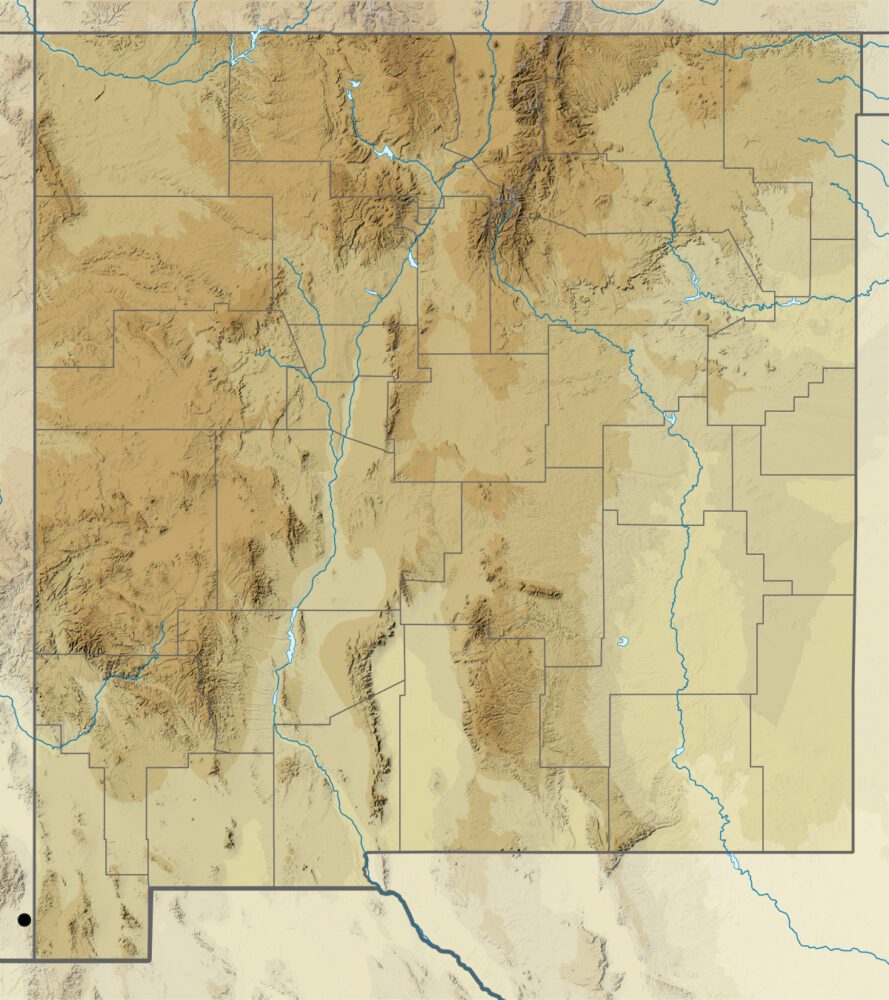by Steven J. Cary and Michael E. Toliver
Skippers (Hesperiidae). About a third of our butterfly fauna, more than 100 species, belongs to this family, which is subdivided into six subfamilies in the US: Eudaminae, Tagiadinae, Pyrrhopyginae, Pyrginae, Heteropterinae, and Hesperiinae. Of those six subfamilies, five are known from New Mexico and the sixth (Tagiadinae, represented by Celaenorrhinus fritzgaertneri) has been taken on the Arizona side of Cottonwood Canyon, Peloncillo Mountains. Therefore, it is likely that eventually all six will be known from our state. The tribe Megathymini has been considered a seventh subfamily, but recent genetic work (Li, et al, 2019) shows it belongs in the Hesperiinae. Skippers earned their name because of their rapid, skipping flight, which is powered by a heavily-muscled thorax. All skippers have antennal clubs that are distinctively bent, curved or hooked. Larvae silk leaves together for nests; larvae overwinter. Most subfamilies have distinct larval food preferences. Updated November 30, 2022
Spread-Wing Skippers (Hesperiidae: Pyrginae). About a third of New Mexico’s skipper species (34) are in this subfamily, which is also informally known as the “Herb, Shrub and Tree Skippers.” Larvae in this group eat a variety of dicotyledonous plants (herbs, shrubs and trees) in various families. The Pyrginae includes some genera whose member species have confusingly similar appearances, including the duskywings (Gesta species) and checkered skippers (Pyrgus and Burnsius). Identification is often challenging for Pyrgine skippers because key diagnostic characters are on wing undersides, which are hard to see when wings are spread, as they often are. For a few species, only genitalic examination via microscope can provide certainty regarding identity.
- Common Sootywing (Pholisora catullus)
- Mexican Sootywing (Pholisora mejicanus)
- White-tufted Sootywing (Pholisora albicirrus)
- Gold-headed Scallopwing (Staphylus ceos)
- Texas Gold-headed Scallopwing (Staphylus ecos)
- Mojave Sootywing (Hesperopsis libya) confertiblanca, lena
- Saltbush Sootywing (Hesperopsis alpheus)
- Texas Powdered-Skipper (Systasia pulverulenta) Systasea
- Arizona Powdered-Skipper (Systasia zampa) Systasea
- Glassy-winged Skipper (Xenophanes ruatanensis) tryxus
- Common Streaky Skipper (Celotes nessus) Celotes limpia, Celotes sabinus, Arizona Streaky-skipper
- Grizzled Skipper (Pyrgus centaureae)
- Mountain Checkered-Skipper (Pyrgus xanthus)
- Small Checkered-Skipper (Pyrgus scriptura) apertorum
- Common Checkered-Skipper (Burnsius communis) Pyrgus communis,
- Cryptic Checkered-Skipper (Burnsius albezens) Burnsius albescens, Pyrgus albescens, White Checkered-skipper
- Desert Checkered-Skipper (Burnsius philetas)
- Tropical Checkered-Skipper (Burnsius oileus)
- Erichson’s White-Skipper (Heliopetes domicella) Heliopyrgus
- Northern White-Skipper (Heliopetes ericetorum)
- Laviana White-Skipper (Heliopetes laviana)
- White-Patched Skipper (Chiothion georgina) Chiomara asychis
- Brown-Banded Skipper (Timochares fuscifasciata) ruptifasciata, ruptifasciatus
- Dreamy Duskywing (Erynnis icelus)
- Burgess’ Duskywing (Erynnis burgessi) Sleepy Duskywing, Erynnis brizo
- Mottled Duskywing (Gesta martialis) Erynnis martialis
- Pacuvius Duskywing (Gesta pacuvius) Erynnis pacuvius
- Juvenal’s Duskywing (Gesta juvenalis clitus) Erynnis juvenalis
- Rocky Mountain Duskywing (Gesta telemachus) Erynnis telemachus, propertius
- Meridian Duskywing (Gesta meridianus) Erynnis meridianus
- Horace’s Duskywing (Gesta horatius) Erynnis horatius
- Mournful Duskywing (Gesta tristis tatius) Erynnis tristis
- Scudder’s Duskywing (Gesta scudderi) Erynnis scudderi
- Funereal Duskywing (Gesta funeralis) Erynnis funeralis, Gesta zarucco
- Afranius Duskywing (Gesta afranius) Erynnis afranius
- Persius Duskywing (Gesta persius) Erynnis persius
- Hermit Skipper (Grais stigmaticus)
- Wind’s Skipper (Windia windi)
Pholisora catullus (Fabricius 1793) Common Sootywing (updated February 25, 2024)
Description. Common Sootywing, like its sister species Mexican and White-tufted, is small and dark. All three are iridescent black above with a variable number of white spots, mostly in the forewing subapical area, none of which have diagnostic value. Distinguish Common from the next two species by examining the underside, which is unmarked glossy dark brown; veins are not heavily blackened; legs are usually white. Range and Habitat. This skipper inhabits disturbed areas across most of temperate North America and into Mexico. In New Mexico it has been recorded from all counties. Look for it below 7000′ in Upper Sonoran Zone habitats, but it has been seen above 9000 feet, too. Life History. Larvae eat various species of Chenopodiaceae and Amaranthaceae such as Amaranthus retroflexus, A. blitoides, A. albus and Chenopodium album (Scott 1992). Many plants in these families are weeds in New Mexico, which makes disturbed areas good places to find this species. Flight. There are one to three generations annually in New Mexico. Peak flight is June to September in northern New Mexico, then May and August farther south; records span March 12 to November 26. Adults skitter and dodge near the ground seeking nectar and moist soil. Males patrol swales and arroyos looking for females. Comments. On 8 June 1981, several miles west of Portales (Ro), C. G. Schmidt observed several flying when the air temperature was 104º F.
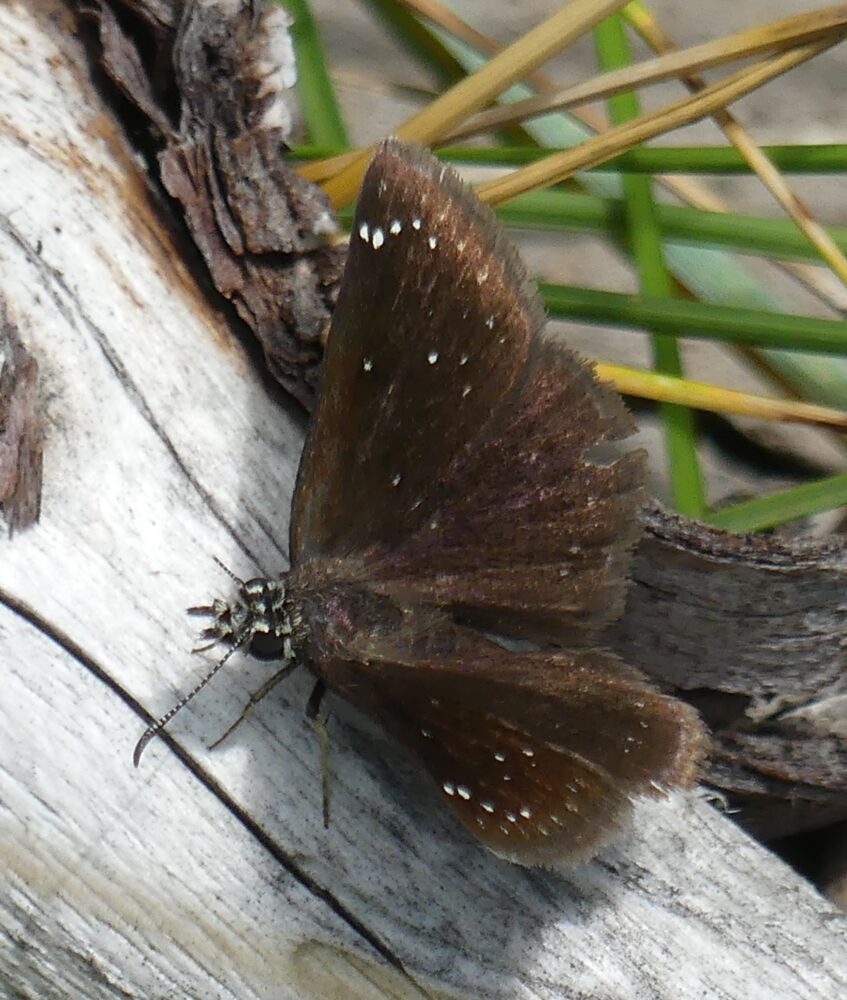
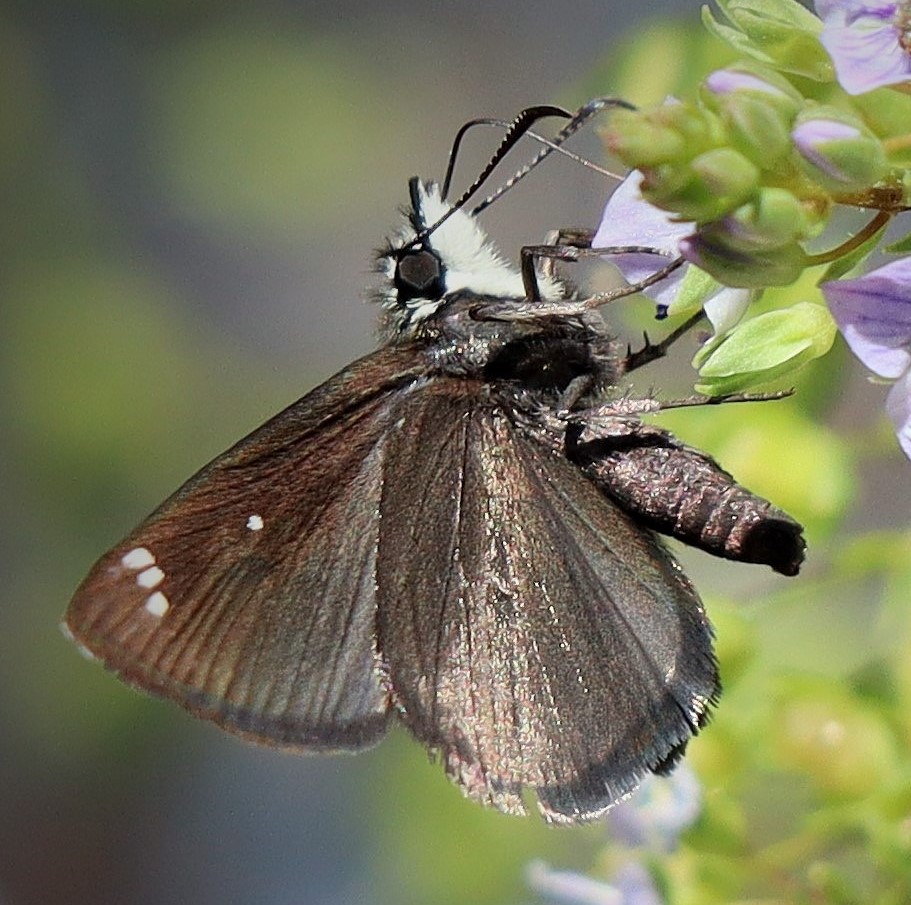

Pholisora albicirrus Glassberg 2023 White-tufted Sootywing (updated November 28, 2023)
Description. White-tufted Sootywing, like Common and Mexican, is small and dark. It is iridescent black above with a variable number of white spots, none of which have any diagnostic value. Differentiating traits of White-tufted include (1) a spurt of white hairs behind each foreleg, (2) a white ring completely encircling each eye (incomplete in Common), and (3) a spritz of gold scales near the base of the VFW (which may disappear with wear). Legs are usually white. Range and Habitat. This newly described species lives in southeast Arizona, southwest New Mexico (counties: Ca,DA,Gr,Hi,Lu) and south into Mexico. In our state it inhabits arid grasslands and scrublands between 3800′ and 5000′ elevation, occasionally as high as 6000′. Life History. Nothing is yet documented for this butterfly, but larvae probably munch from the same general menu as its sister sootywings: various species of Chenopodiaceae and Amaranthaceae. Flight. This species is on the wing at least during the monsoon season (July 17 – October 9); a spring brood seems likely, but evidence remains scant. Adults skitter and dodge near the ground seeking nectar and moist soil. Comments. Jeff Glassberg described ‘White-tufted’ Common Sootywing as a new subspecies from SE AZ, Mexico and Hidalgo Co., NM, gave it the name albicirrus, and speculated that it might be a full species. Shortly thereafter, Zhang, et al. 2023 proposed, based on DNA studies, that Pholisora albicirrus Glassberg 2023 is indeed a full species distinct from Common Sootywing. In his original description, Glassberg noted the existence in Grant County of potential hybrids with Common Sootywing. Additional field work is clearly needed in southwest New Mexico to better elucidate the relationship between catullus and albicirrus: Do they fly together anywhere? Do they interbreed?
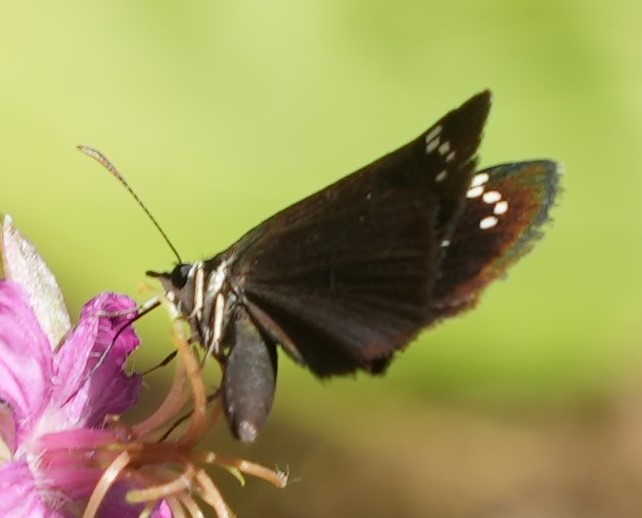

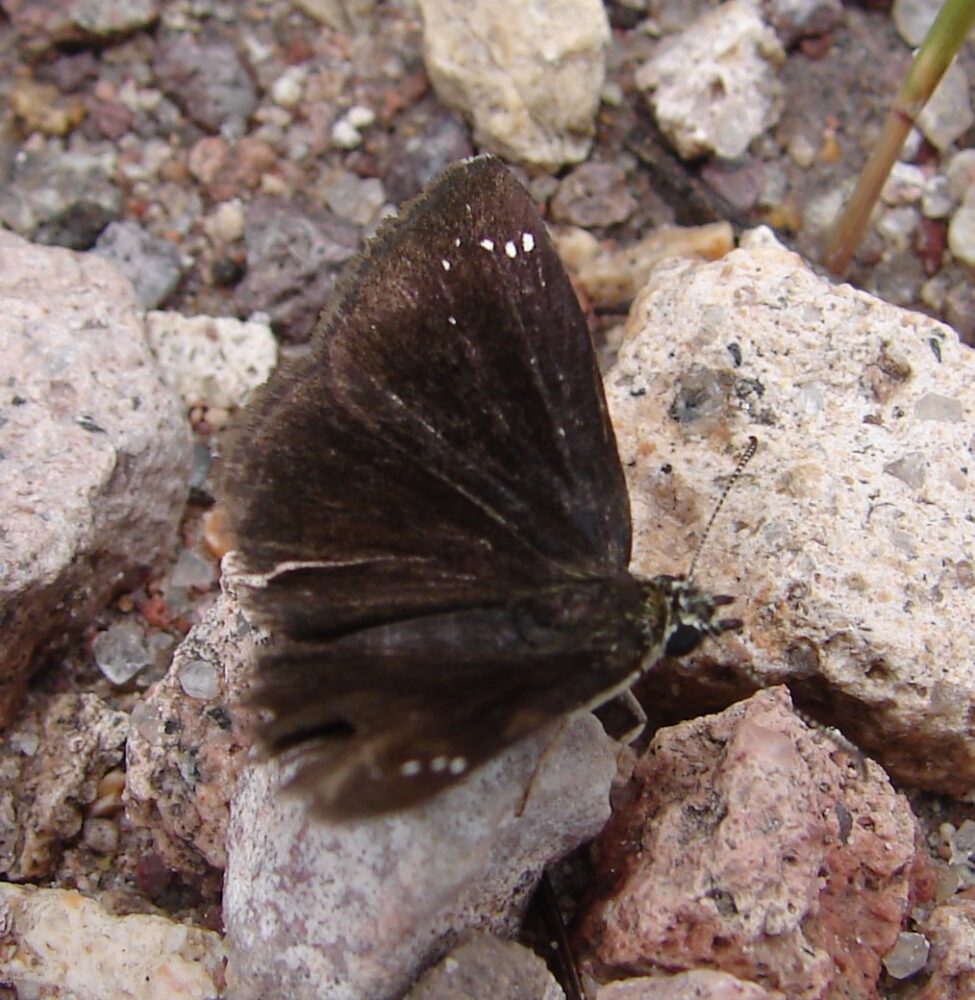

Pholisora mejicanus (Reakirt [1867]) Mexican Sootywing (updated November 28, 2023)
Description. Mexican Sootywing, like Common and White-tufted, is small and dark. It is uniform iridescent black above with a variable number of white spots, none of which have diagnostic value. Mexican stands out from the other sootywings by virtue of its ventral hindwing, which is iridescent steel blue with black veins which seem to gain prominence as the blue scales wear or fade to brown with age. Legs are black. Some individuals have white tegulae, or shoulders (see photo below). Range and Habitat. Pholisora mejicanus appears to be restricted to the eastern foothills of the Rocky Mountains from southern Colorado south into Mexico, including central New Mexico (counties: Be,Ca,Co,Ed?,Li,Ot,Sv,SM,SF,So,Ta,To,Un). Like Pholisora catullus, it occupies disturbed, weedy areas in Upper Sonoran to Transition Zones, 6300 to 9200′. It prefers higher elevation areas compared to Pholisora catullus, which is not often seen above 7000’ elevation. Life History. Larval hosts are shared with Common Sootywing, including Amaranthus retroflexus and Amaranthus blitoides. Flight. Adults skitter and dodge near the ground seeking nectar and moist soil. This skipper is univoltine to possibly bivoltine in New Mexico. Peak flight is in July, but observations range from May 15 to August 27. Comments. It is not clear why Mexican is so geographically restricted while Common is so widespread. They rarely occur together in New Mexico, but when they do, they do not interbreed. Their larvae can even occur on the same plant. Genomic data confirms these two species have been distinct for a long time. Dorsal similarity to Common Sootywing is blamed for several dubious determinations of Mexican Sootywings over the years. Underside views, absolutely essential for ID, can be hard to get. Sometimes, after they warm up, they will fly up to flowers a foot or two off the ground and not spread their wings so wide. Even on worn specimens that may lack the iridescent blue ground color, seeing the blackened veins is enough to confirm Mexican. The Sandia, Manzano and Sierra Blanca mountain ranges seem reliable places to find this tiny but glorious species.
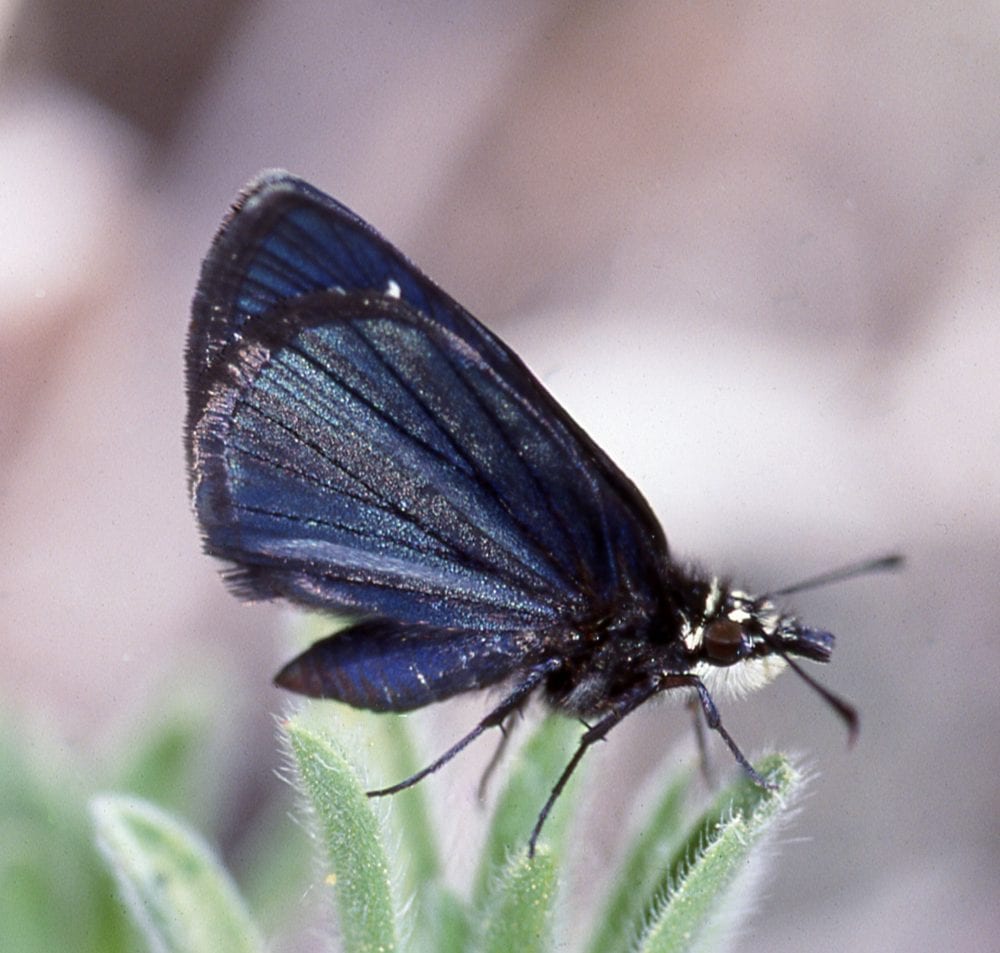
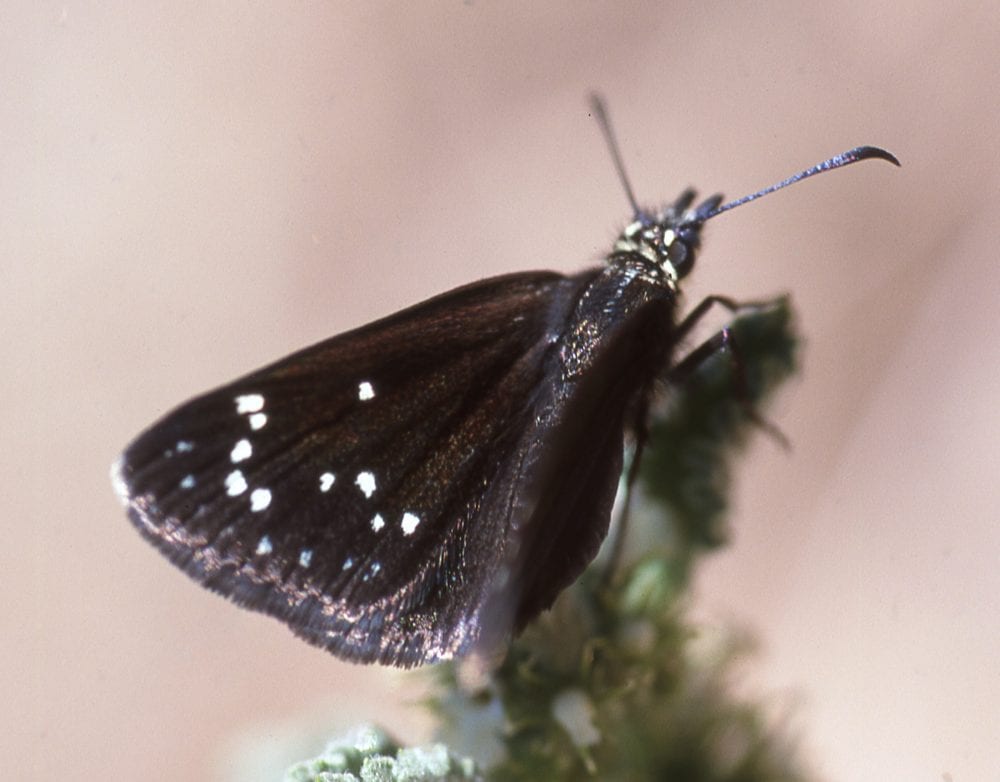


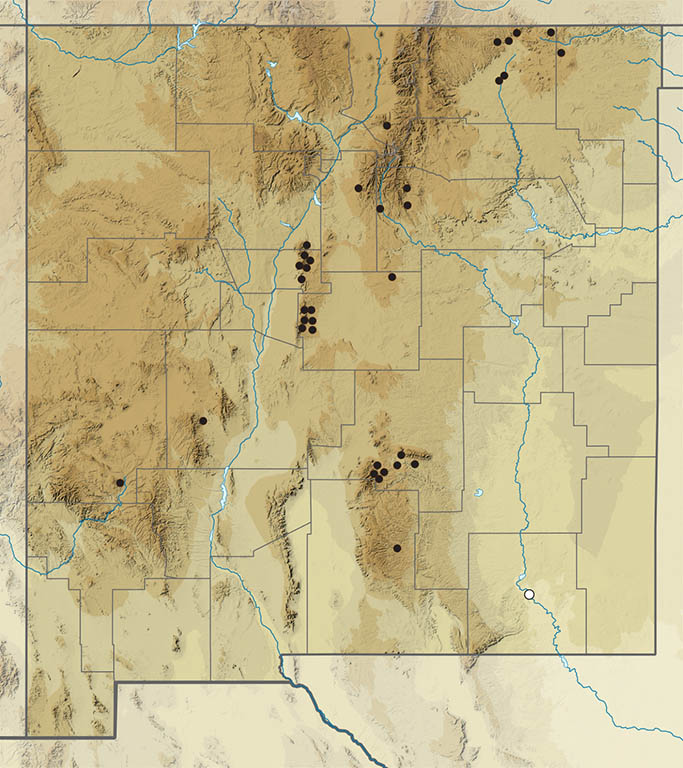
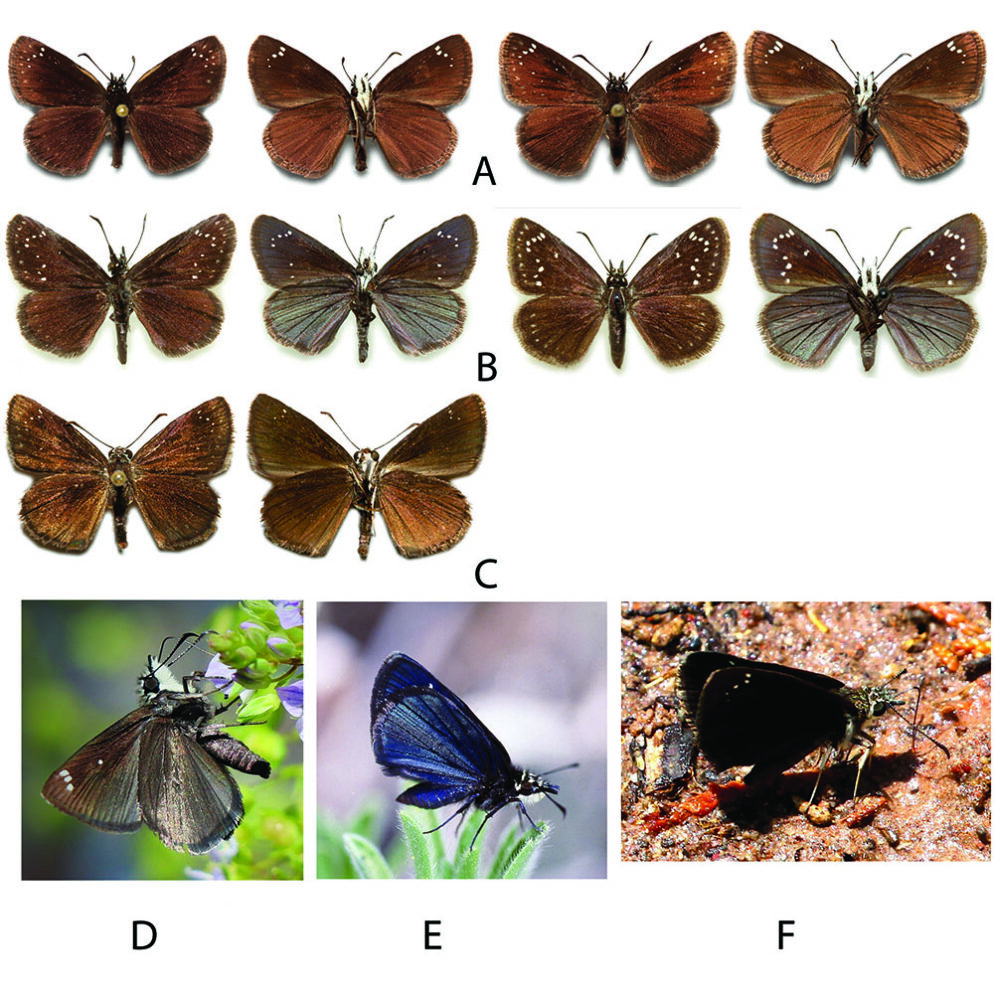
Staphylus ceos (W. H. Edwards 1882) Gold-Headed Scallopwing (updated August 22, 2022)
Description. Its combination of orange head and palpi, habitat, and flight habits easily set Gold-Headed Scallopwings apart from all other New Mexico butterflies. Note the somewhat “wavy” margin of the HW. Range and Habitat. Staphylus ceos lives in Mexico and the southwestern US, including southern parts of California, Arizona, Texas and New Mexico. Here it occurs in canyons, arroyos, and river valleys (counties: Be,Ca,DA,Ed,Gr,Hi,Lu,Ot,Si,So,Va), generally 4000 to 6500′ but straying as high as 8000′ in the Organ Mountains (DA). Life History. According to Bailowitz and Brock (1991, 2022), Staphylus ceos larvae make nests and eat at least two species of Chenopodium (Chenopodiaceae) in southeast Arizona, including Chenopodium fremontii, which also is used in southern New Mexico. Flight. Adults fly near the ground, dodge through gnarly shrubs, perch at moist earth or low plants, and nectar at flowers. We have two broods per year, with adult flights peaking in April and August. Actual reports span the period March 14 to October 22. Comments. The first documented New Mexico report is credited to Harry Clench, who found it at Sitting Bull Falls, Guadalupe Mountains (Ed), on 12 September 1960. We may need to keep a sharp eye open for Staphylus ecos, a recently described look-alike species which occurs in Davis Mtns. and Chisos Mtns. of west Texas (see below).
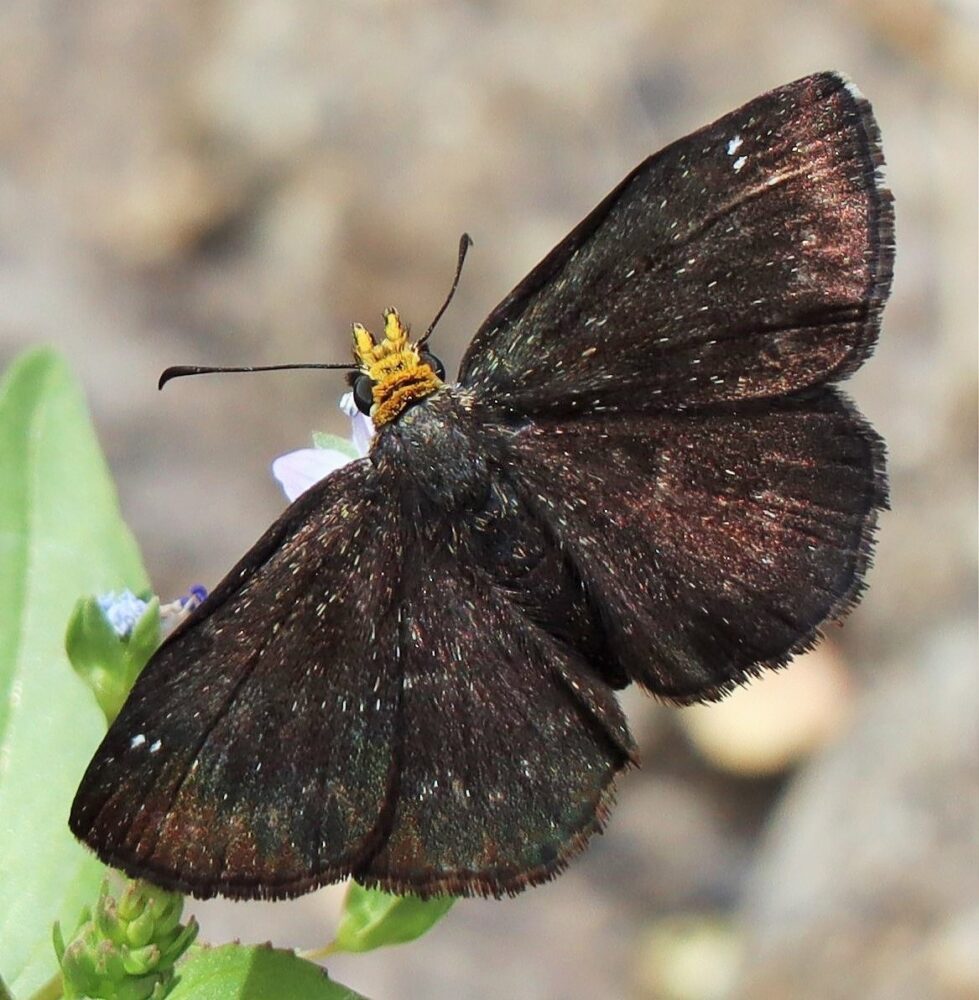
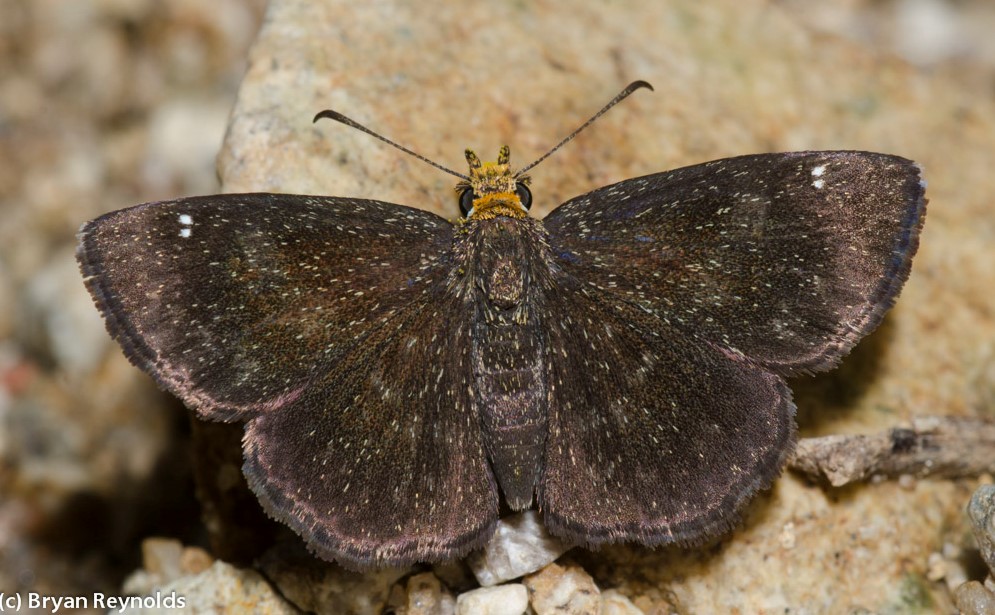
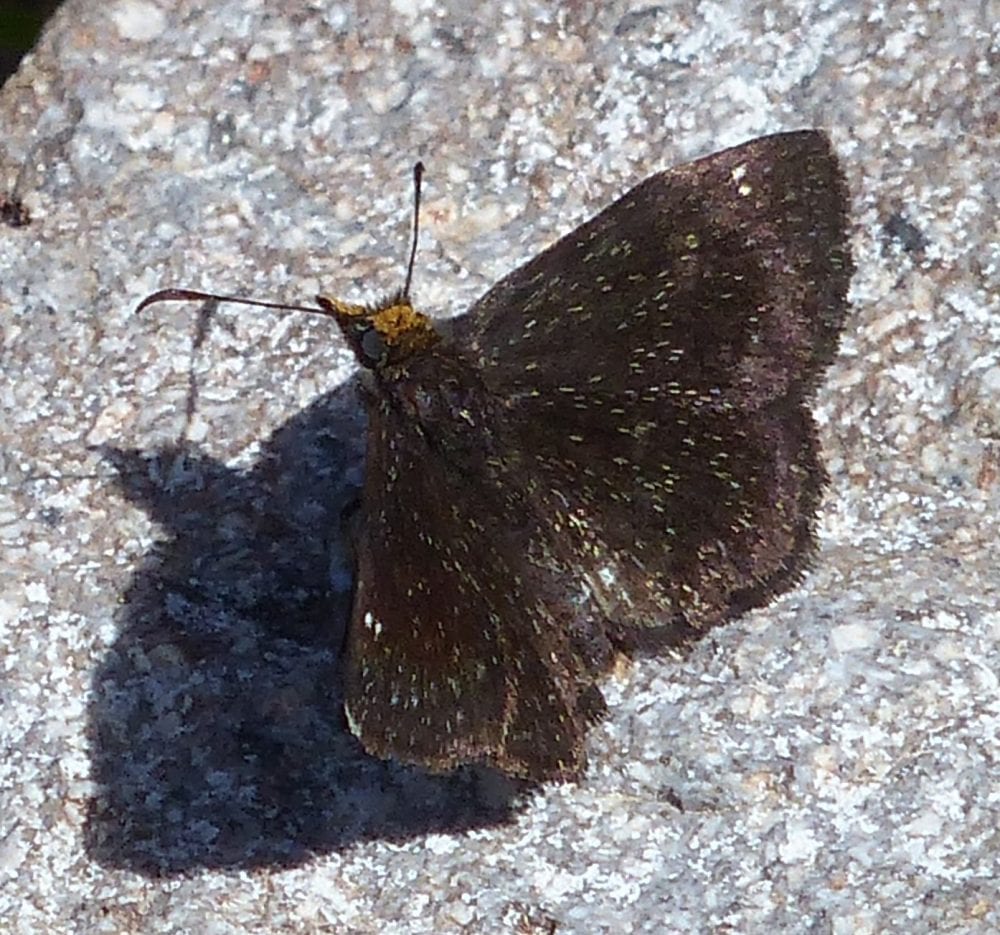
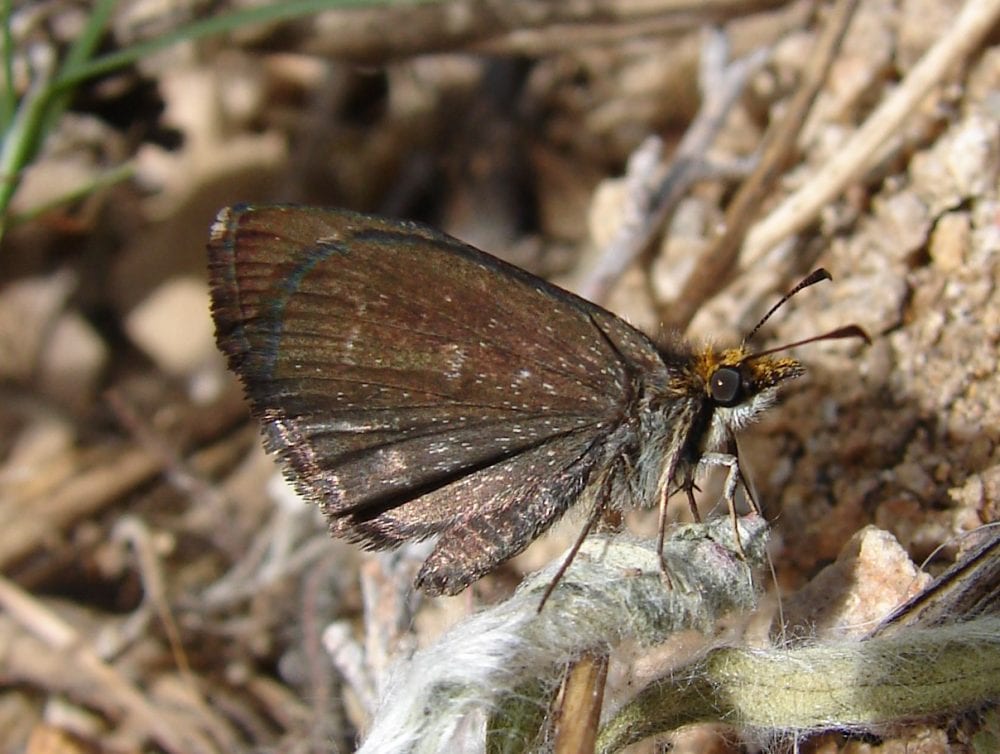
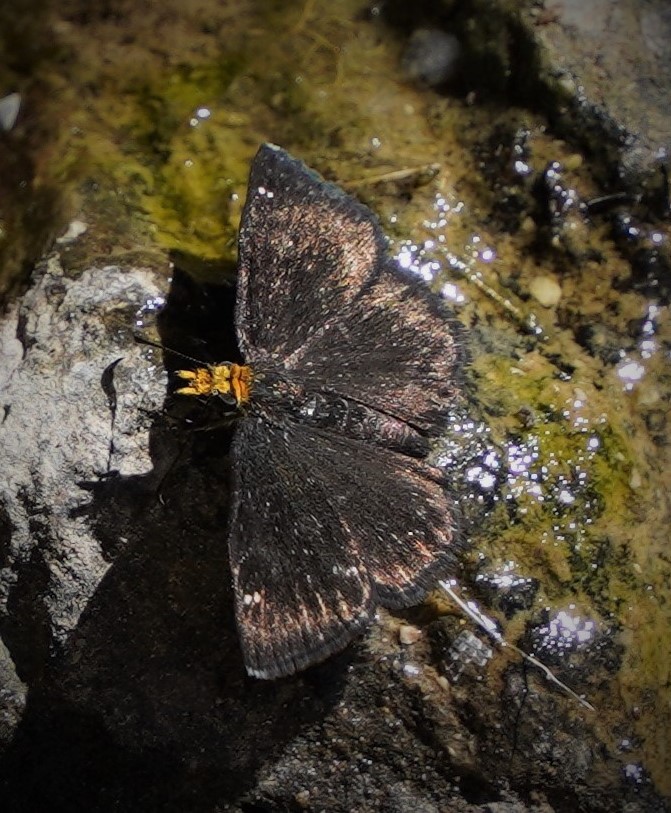
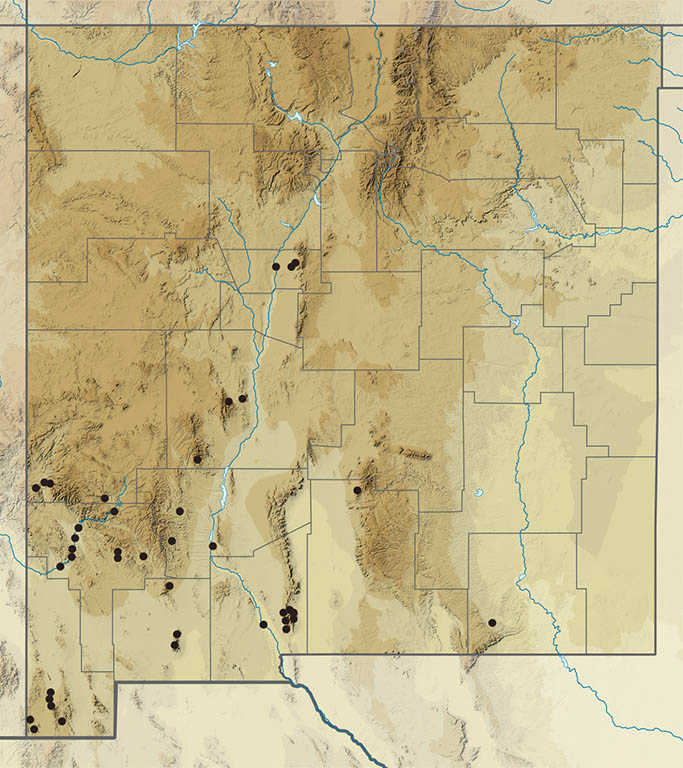
Staphylus ecos Grishin 2022 Texas Gold-headed Scallopwing (added May 18, 2024)
Description. Before the description of this species in 2022, any orange-headed dark skipper found in southern New Mexico could easily be identified as S. ceos. There is no currently known naked eye observable way to distinguish ecos from ceos; reliance must be placed on genitalic examination or DNA analysis. Note the somewhat “wavy” margin of the HW, characteristic of this group of skippers. Range and Habitat. Staphylus ecos lives in Texas and adjacent Mexico. It has yet to be found in New Mexico, but it closely approaches the state in west Texas and given the difficulty in distinguishing this species from ceos, we should closely examine any Staphylus found in Eddy and Lea counties. Grishin (in Zhang 2022) says “The two sister species [ceos and ecos] are currently allopatric, and the boundary between them in the USA lies somewhere between the Davis Mountains and the Franklin Mountains in Texas with no known intervening populations.” Life History. Eggs are placed on Chenopodium berlandieri in Texas. Plants in the genus Chenopodium (Chenopodiaceae) in southeastern New Mexico should be examined for larvae. Flight. In its known range, records range from May-July and September-October, indicating two broods. Comments. As noted above, this species is currently unreported from New Mexico. We include it here to raise awareness of its possible occurrence in southeastern New Mexico, and urge butterfliers there to collect any Staphylus they find, especially in Eddy and Lea counties.

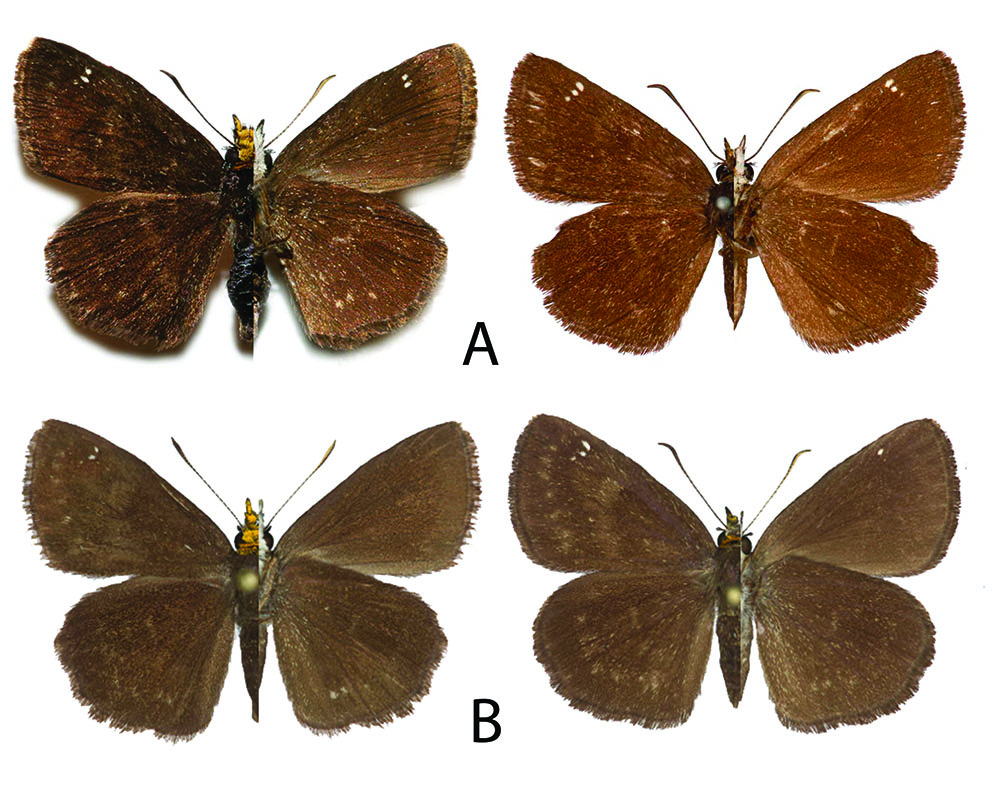
Hesperopsis libya (Scudder 1878) Mojave Sootywing (updated August 19, 2024)
Description. Dorsally, Mojave Sootywing looks like a Pholisora species; it is small and dark with subapical white spots on the forewing. The hindwing below, however, is olive-brown with a few white spots and the wing fringes are white. Range and Habitat. This skipper inhabits Lower Sonoran to Upper Sonoran Zone desert washes and alkali flats where the hostplants grow. It is distributed from northwest Mexico through the Great Basin north to Oregon, and on the east side of the Rockies as far north as North Dakota. It prefers altitudes below 5000′ and barely reaches into NM along the San Juan River and its tributaries. We know of only two reports (county: SJ), although it may be more widespread in an area that is little investigated by butterflyers. Life History. Larvae eat Chenopodiaceae such as the widespread Four-wing Saltbush (Atriplex canescens); Atriplex confertifolia is also a suspected host (Scott 1986). Flight. Adults fly in low areas near larval hostplants and are fond of nectar. One New Mexico report is for June, 4 miles northwest of Newcomb (Kilian Roever). A second, more recent sighting was on July 19, 2021. There should be two broods per year if it is a breeding resident, so more looking is warranted. Comments. Our populations belong to subspecies Hesperopsis libya confertiblanca (J. Scott 1992), which may in the end prove to be a synonym of H. libya lena (W. H. Edwards 1882).
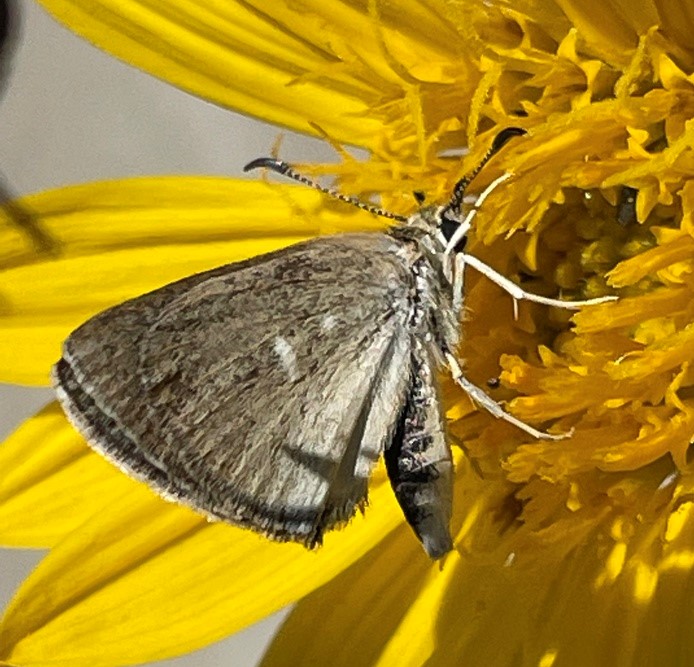
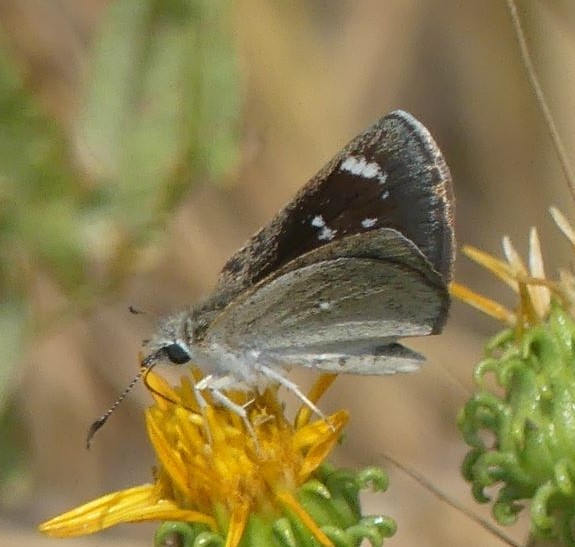

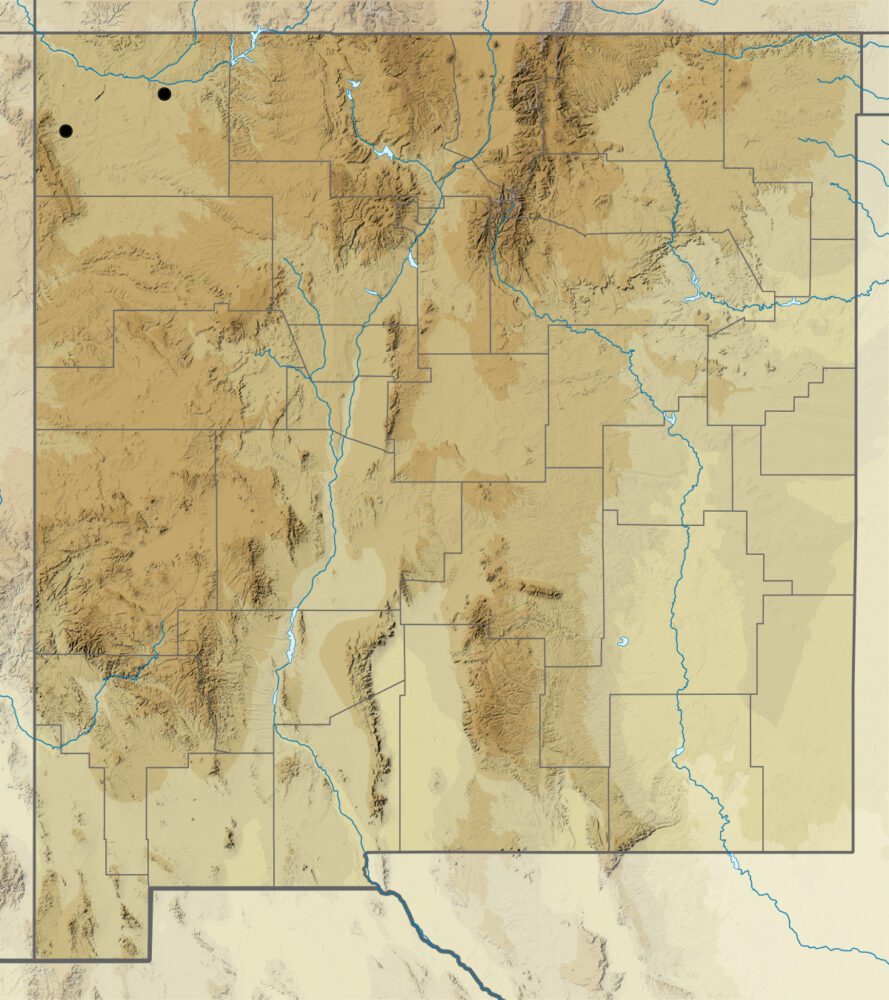
Hesperopsis alpheus (W. H. Edwards 1876) Saltbush Sootywing (August May 29, 2022)
Description. Saltbush Sootywing is marked like a diminutive Erynnis species, with nondescript pale smudges, marks and mottling that are hard to put into words. It resembles a Common Sootywing that has been splattered with light scales. Wing fringes are checkered. Range and Habitat. This skipper inhabits southwestern deserts, ranging from Nevada, Utah and Colorado south into Mexico. In NM it occupies low and middle elevation areas (3000’ to 7300′), sometimes higher, always with stands of the host (counties: Be,Ch,Ci,Co,DB,DA,Ed,Gr,Hi,Li,Lu,MK,Ot,RA,Sv,SJ,SF,Si,So,Ta,Va). Life History. Various Chenopodiaceae serve as larval hosts. Fourwing Saltbush (Atriplex canescens) is thought to be the primary host in New Mexico. Flight. Like the other sootywings, adults fly weakly, though elusively, near the ground, almost always near stands of the host. They sometimes seek nectar. In New Mexico there is one mid-summer brood at relatively high altitude and high latitude. Hesperopsis alpheus is bivoltine at lower and warmer sites, with peak numbers in April to May and again in July. Extreme flight dates are March 9 and September 8. Comments. The type locality of Hesperopsis alpheus, described in 1876, is southwest of Raton (Co). In nearly 150 years since the types were collected, there have been no additional observations from within 100 miles of the type locality, even though the larval host is common there. Our populations are assigned to the nominate subspecies.
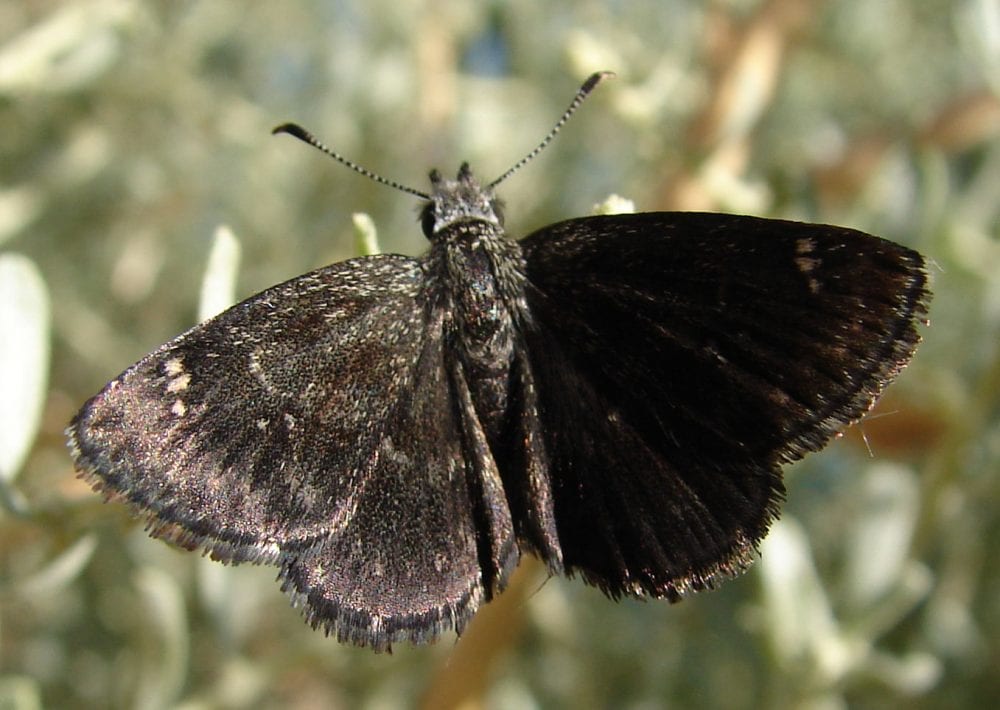
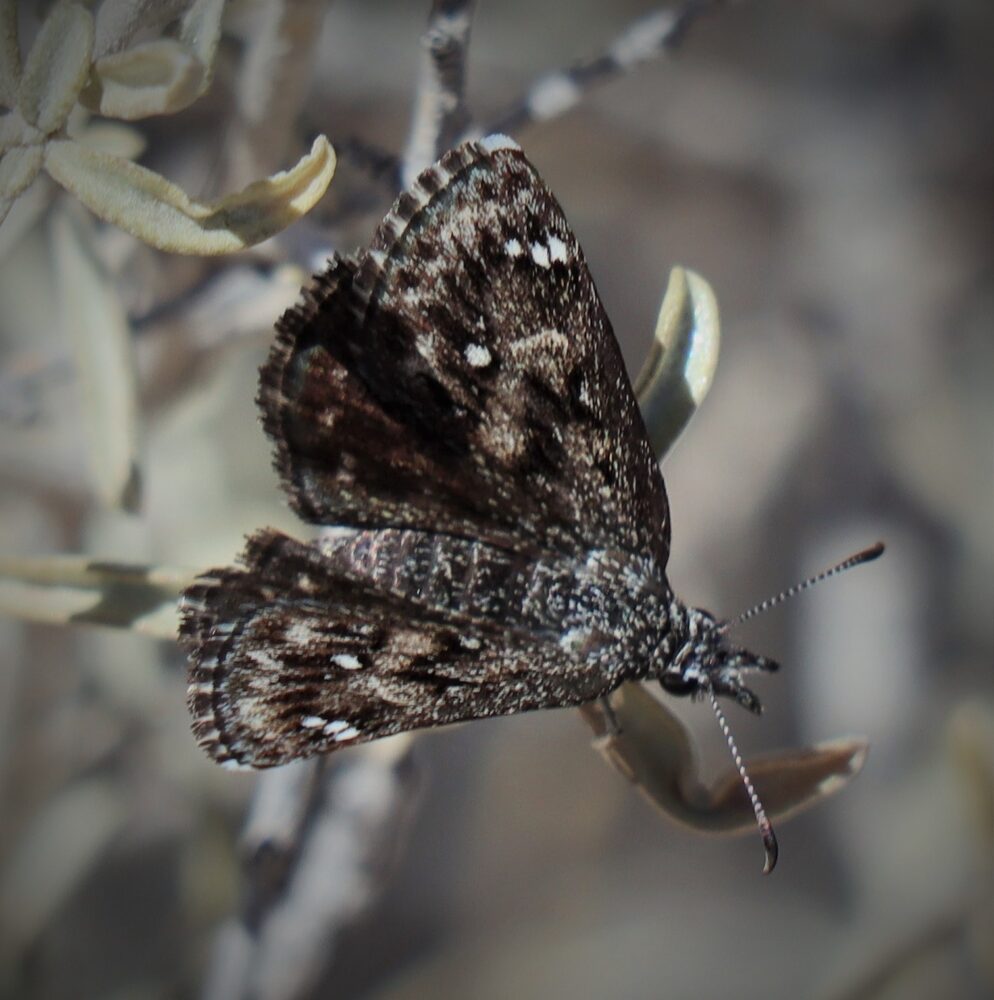
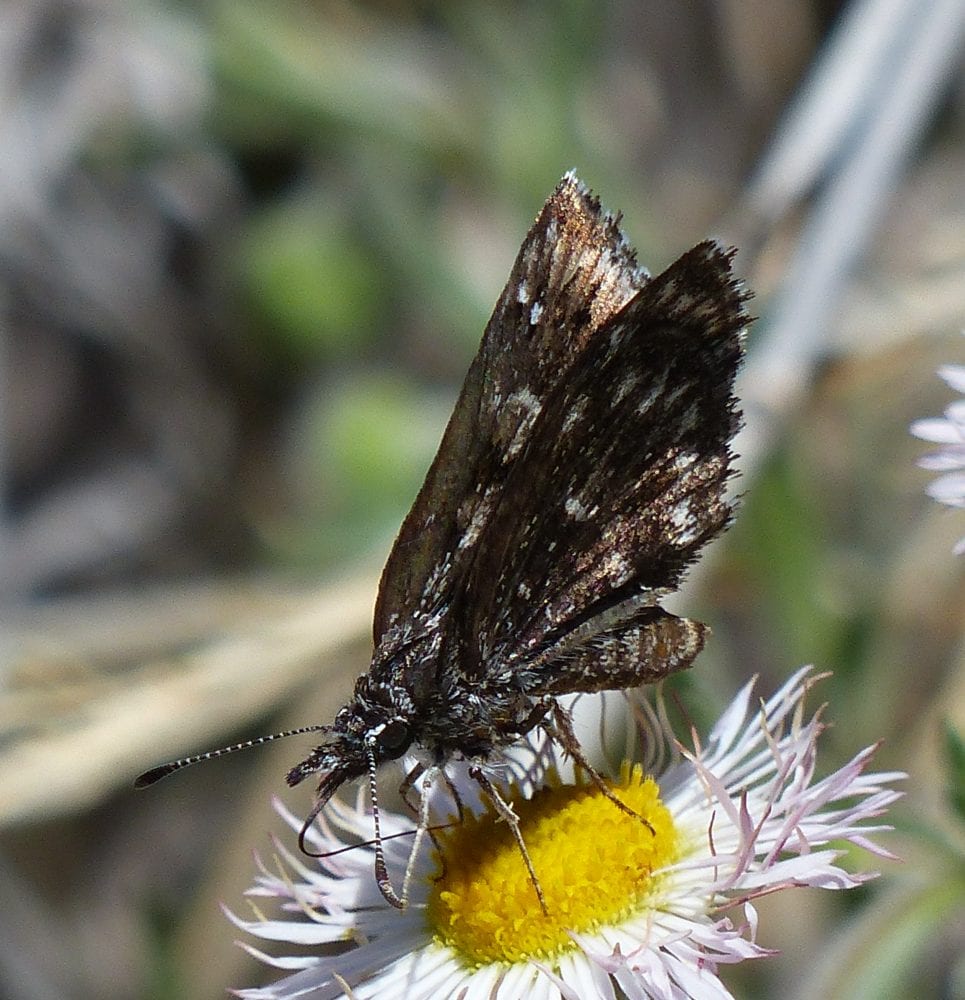
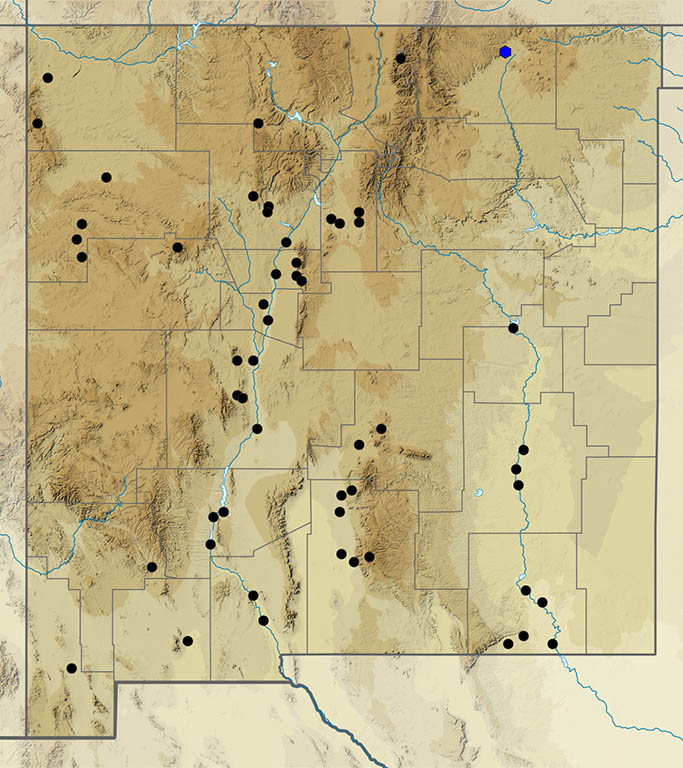
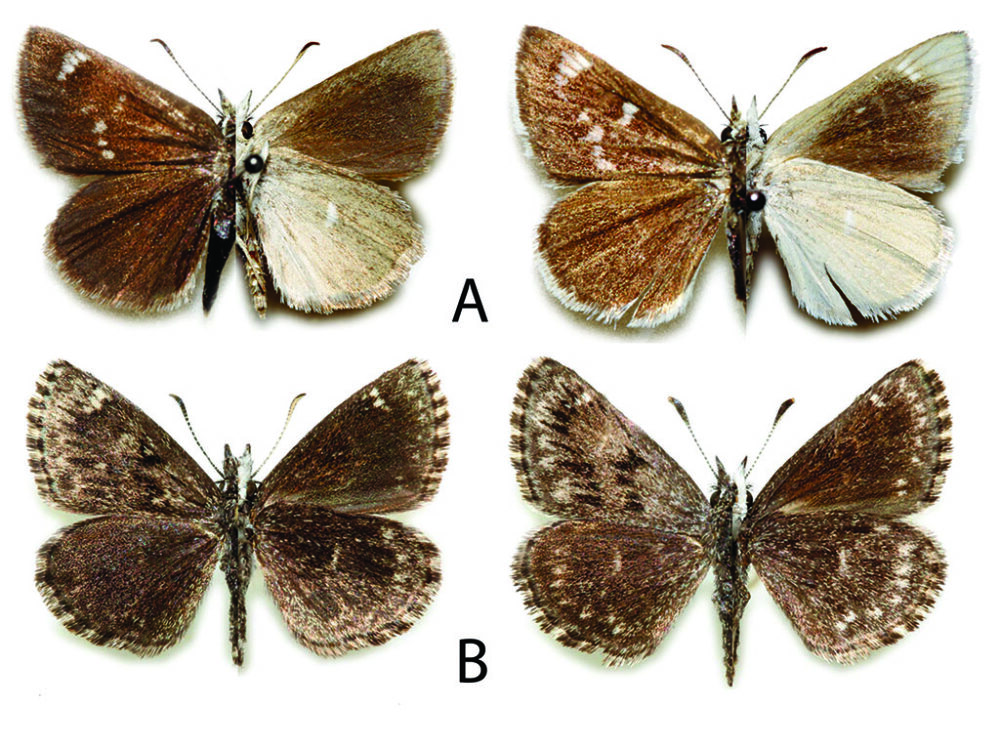
Systasia pulverulenta (R. Felder 1869) Texas Powdered-Skipper (updated February 28, 2024)
Description. Our two Powdered-Skipper species have softly scalloped wing margins that distinguish them from other butterflies. Separating the two Systasia species from each other, however, is more challenging. The best character to check is the hyaline (translucent) spot band that traverses the forewing. On Systasia pulverulenta, the inner edge of this spot-band makes a smooth, uninterrupted curve. This species also has a pinkish cast dorsally when held at an angle to the light. Range and Habitat. Ranging from Central America to south Texas and southern Arizona, Texas Powdered-Skipper also occurs in southernmost New Mexico (counties: DA,Ed,Hi) in low, thorny, desert arroyos. Life History. In Texas, a variety of mallows (Malvaceae) are the larval hosts and that will probably prove true in New Mexico, too. Flight. This skipper flies almost year-round in. We have fewer than 10 documented sightings in southeast New Mexico, but they suggest a sparse flight in early summer and better numbers in late summer, between May 3 and August 19. Males establish territories and patrol arroyo bottoms. Comments. Systasia pulverulenta seems to be making a strong showing in New Mexico in recent years and it may be more regular here than records suggest. Given its appearance in SE AZ, it should be looked for in other southern NM counties (Le,Lu,Gr,Hi,Ot).
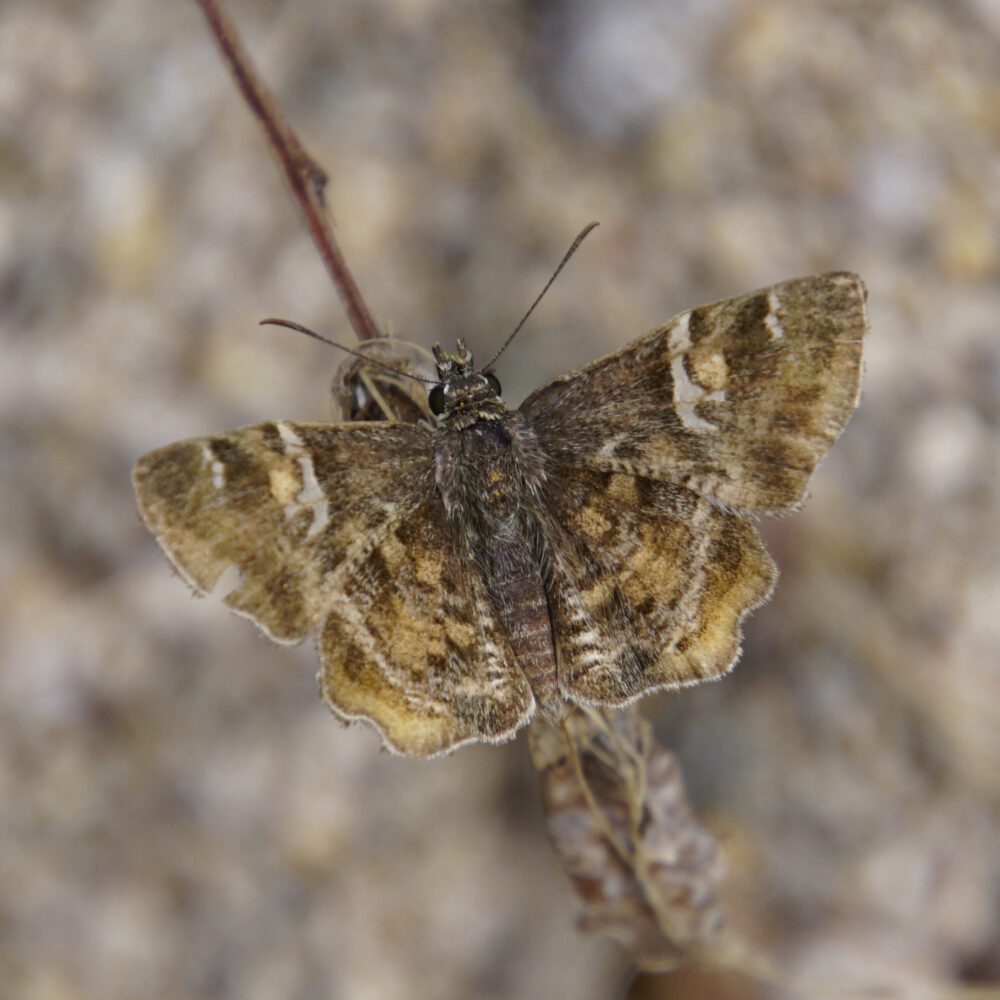
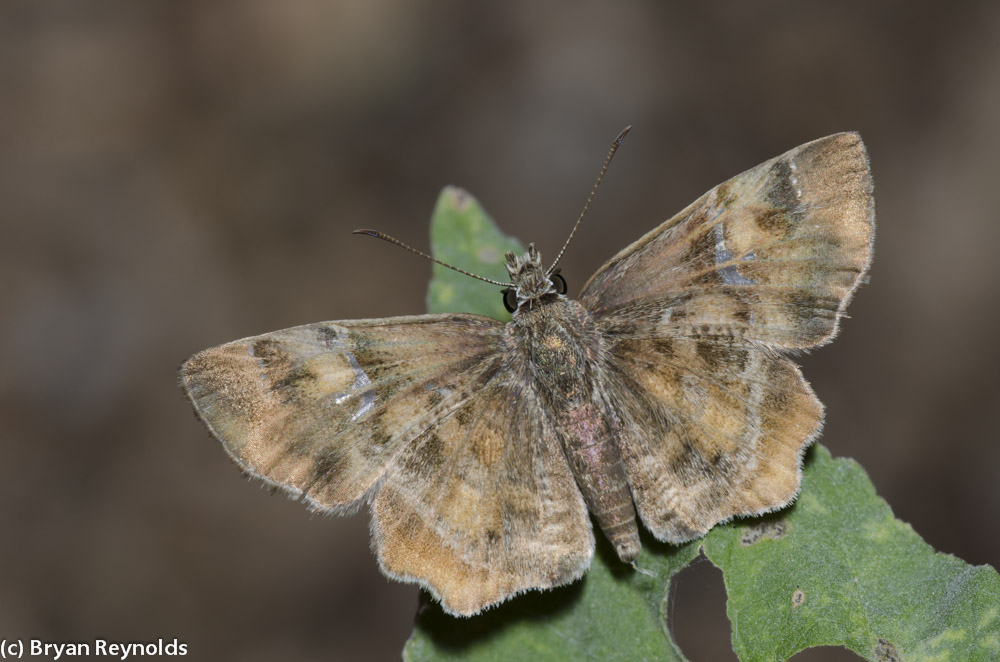
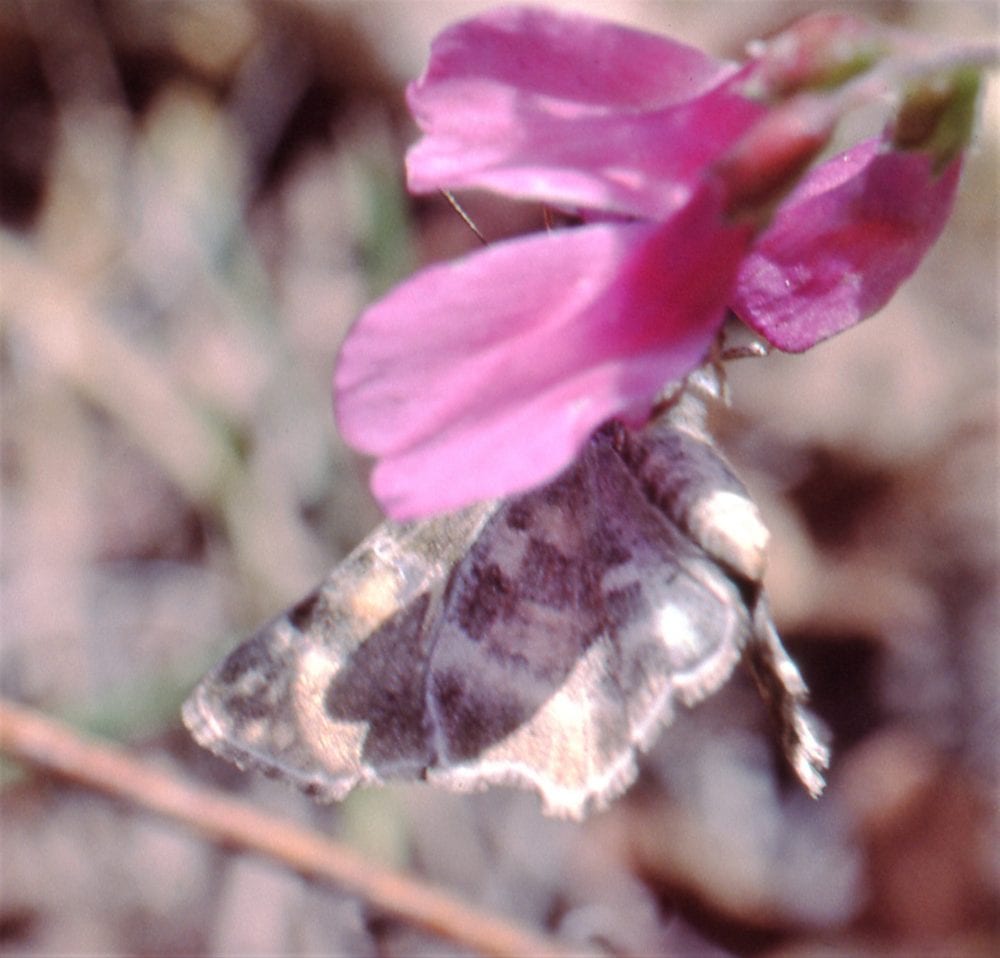

Systasia zampa (W. H. Edwards 1876) Arizona Powdered-Skipper (updated September 7, 2022)
Description. This is the more widespread of our two Systasia species in New Mexico. Compared to Texas Powdered-Skipper, the median row of hyaline spots on the forewing has an irregular inner margin and the dorsal wing surface has a faint olive cast. Range and Habitat. Arizona Powdered-Skipper has a more western distribution than Systasia pulverulenta. It lives in northwest Mexico, west Texas, and southern parts of California, Nevada, Arizona and New Mexico (counties: Ca,DA,Ed,Gr,Hi,Lu,Ot,Si). In our state it inhabits Upper Sonoran Zone canyons and foothill washes of desert mountains, usually 3600 to 6000′. Life History. For southeast Arizona, Bailowitz and Brock (2021) reported several larval hosts in the Malvaceae: Herrisantia crispa, Abutilon malacum, A. incanum, A. palmeri, A. parishii, A. abutiloides, A. sonorae, and A. reventum. These are probable hosts in southwest New Mexico as well. Flight. A spring flight peaks in April, followed by overlapping broods from July to October. Records span March 6 to October 11. Males patrol canyon bottoms and arroyos, occasionally perching on rocks and low vegetation. Adults nectar and feed at moist arroyo sand. Comments. Our first record is from San Augustin Pass, Organ Mountains (DA), 27 April 1959 (Dr. John M. Burns).
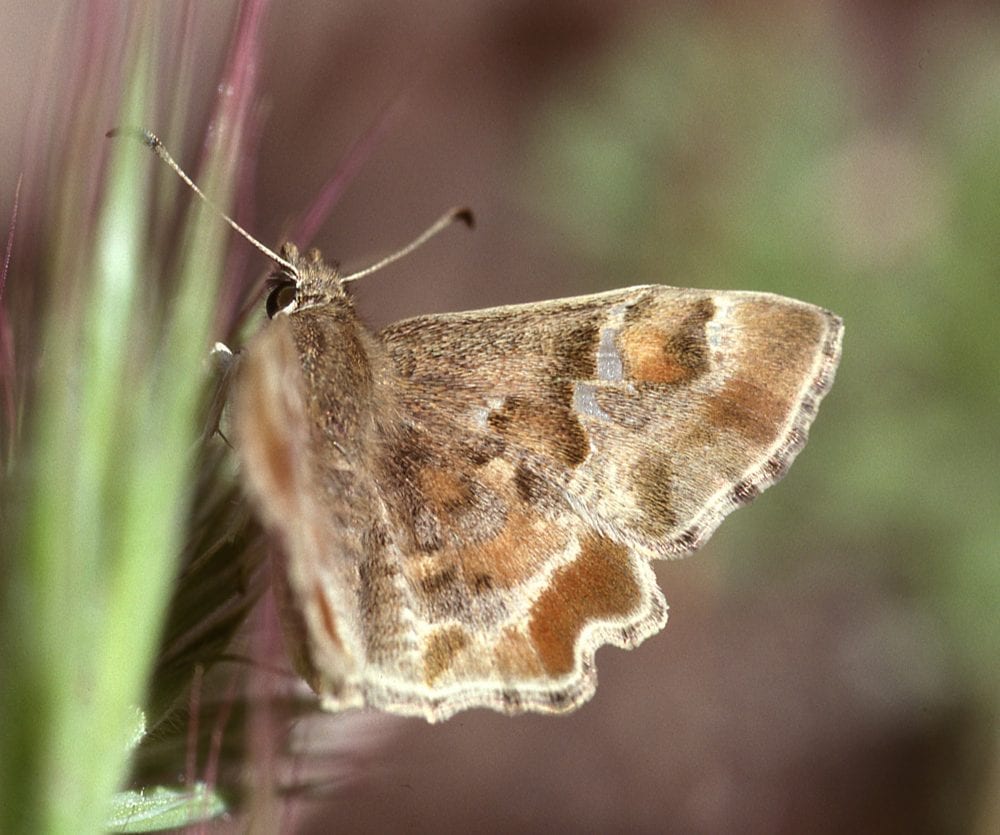
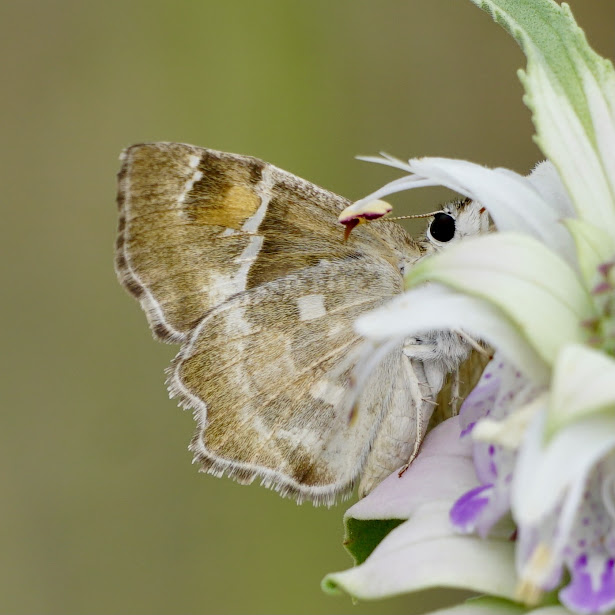
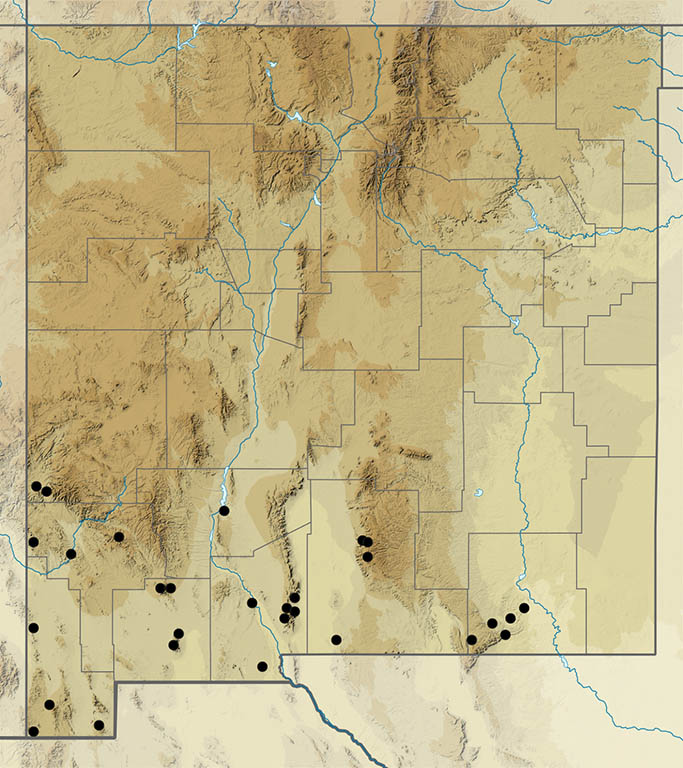

Xenophanes ruatanensis Godman & Salvin 1895 Glassy-winged Skipper (added Jun 17, 2025)
Description. The Glassy-winged Skipper is distinctive and aptly described by its common name. The median area of both FW and HW are inhabited by large translucent patches. No other butterfly currently known from NM has these distinctive patches. The apex of the FW is pointed, as is the tornus of the HW. The ground color is brown and there is a series of translucent spots near the apex of the FW. Range and Habitat. This smallish species is tropical to subtropical and is a very rare stray to NM. Its normal digs are from Argentina to northern Mexico, with occasional breeding in extreme southern Texas. Life History. Larvae feed on Malvaceae, including plants in the genera Malvaviscus and Malachra. Neither of these genera occur in NM, and it is unlikely that a stray would establish a breeding colony here using other Malvaceous plants. Flight. Glassy-wings probably fly year-round in their normal habitat. Three broods have been recorded from Texas. Comments. We have one report of this species (as X. tryxus, a species recently found to be separate from ruatanensis and not known from the US) from Guadalupe Canyon, Hidalgo County, in August. No other details are currently known. The species is not reported from AZ.
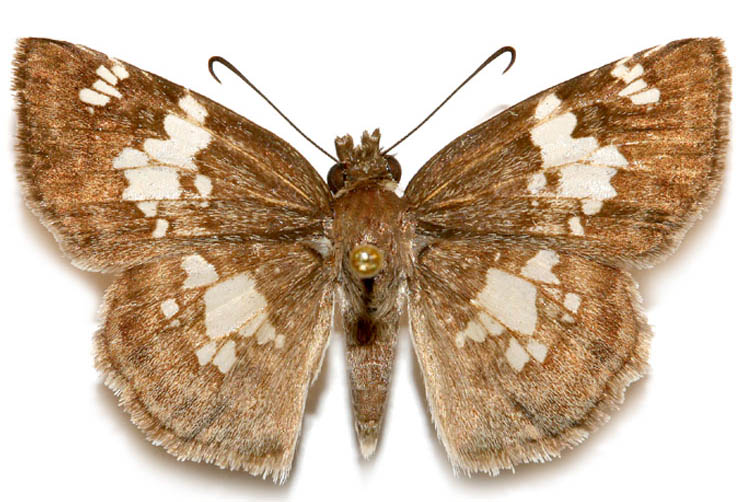
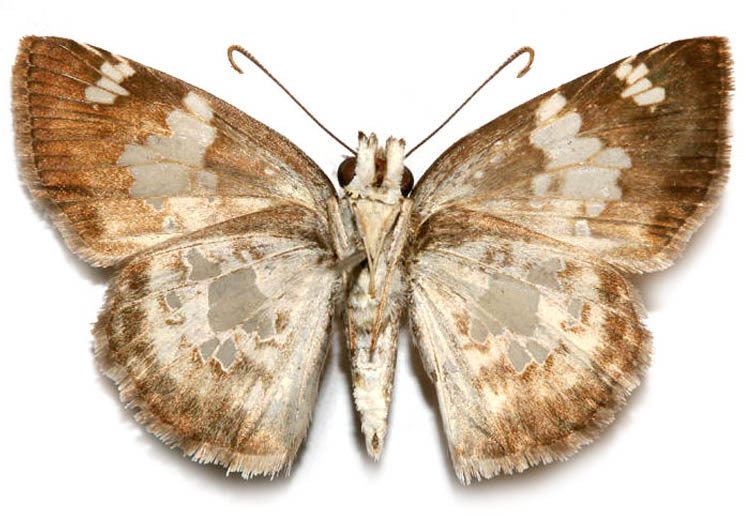
Celotes nessus (W. H. Edwards 1877) Common Streaky-Skipper (updated November 30, 2023)
Description. This small species is unique among New Mexico butterflies, at least until Celotes limpia Burns or Celotes sabinus Grishin, is found here. Celotes nessus is bronze with streaks of copper, gold, silver and dark brown above and below. Range and Habitat. It is an Upper Sonoran Zone dweller in our state (counties: Ca,Ch,DB,DA,Ed,Gr,Gu,Ha,Hi,Li,Lu,Ot,Qu,SM,Si,So,Un). It occurs from Arizona to Oklahoma then south into Mexico. All our records are from below 6300′ elevation. Life History. Larval hosts include Malvaceae (mallows) such as Abutilon incanum, Sida filipes, Wissadula amplissima, W. holosericea, and Sphaeralcea angustifolia var. lobata. Ayenia compacta (Sterculiaceae) is used in southern AZ; a female oviposited on Ayenia insulicola at Rockhound State Park (Lu) (Jim Brock). Flight. Adults fly near the ground in desert arroyos and canyons. Males patrol up- and down-stream from perches in dry streambeds, sometimes seeking nectar. It is bivoltine in most of New Mexico, with flight peaks in April to May and again in August. Extreme flight dates are March 6 and September 15. Comments. Scarce Streaky-Skipper (C. limpia) is virtually identical in appearance to Common Streaky Skipper. The only sure way to tell them apart is by genitalic examination. Specimens from SE NM (counties DA,Ed,Le,Ot) should be collected and examined to ascertain if any are Scarce Streaky-Skippers. So far, all specimens examined have been Commons. Details may be found in Burns’ original paper and on the Butterflies of America website (https://www.butterfliesofamerica.com/t/Celotes_a.htm). A second sister species has been recognized to the west in southern Arizona (Zhang et al. 10/2/2023). Naturalists should look for Arizona Streaky-skipper (Celotes sabinus Grishin 2023) in SW NM. It seems a bit of a long shot because it is not yet reported from the adjacent Arizona county (Cochise) and naked-eye diagnostic characters are not yet known.

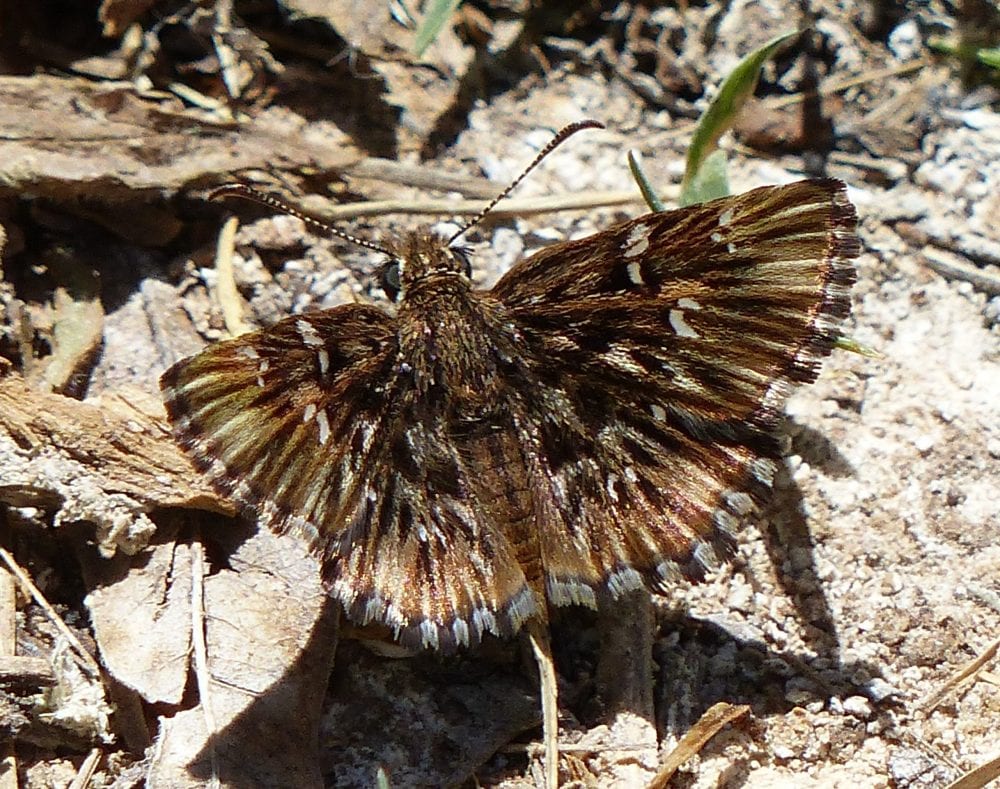
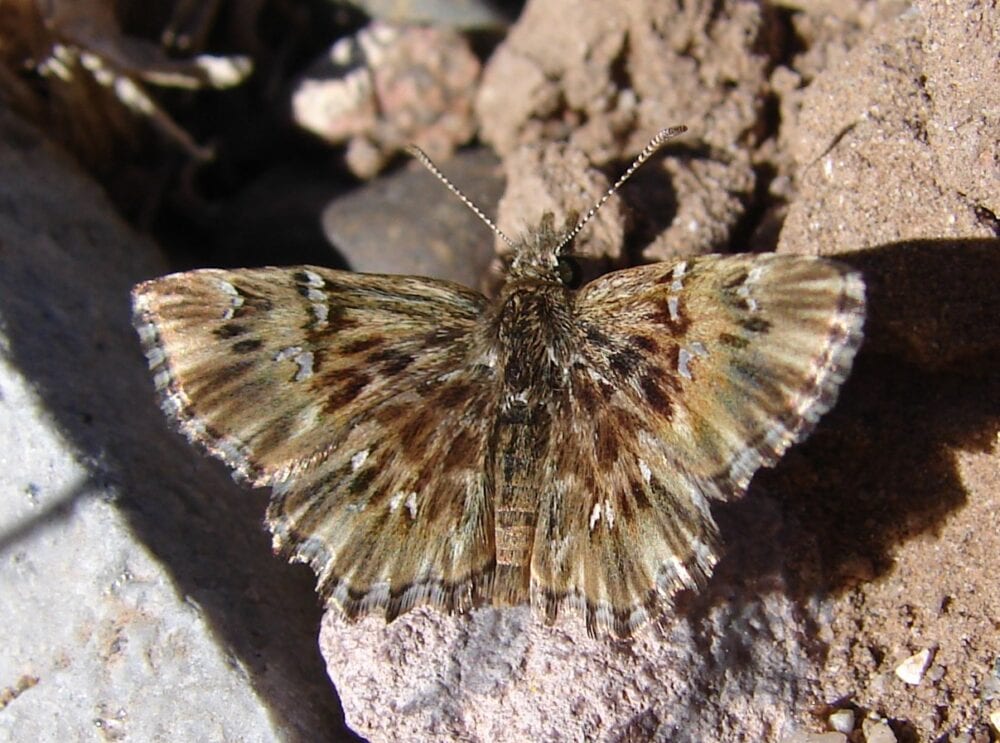
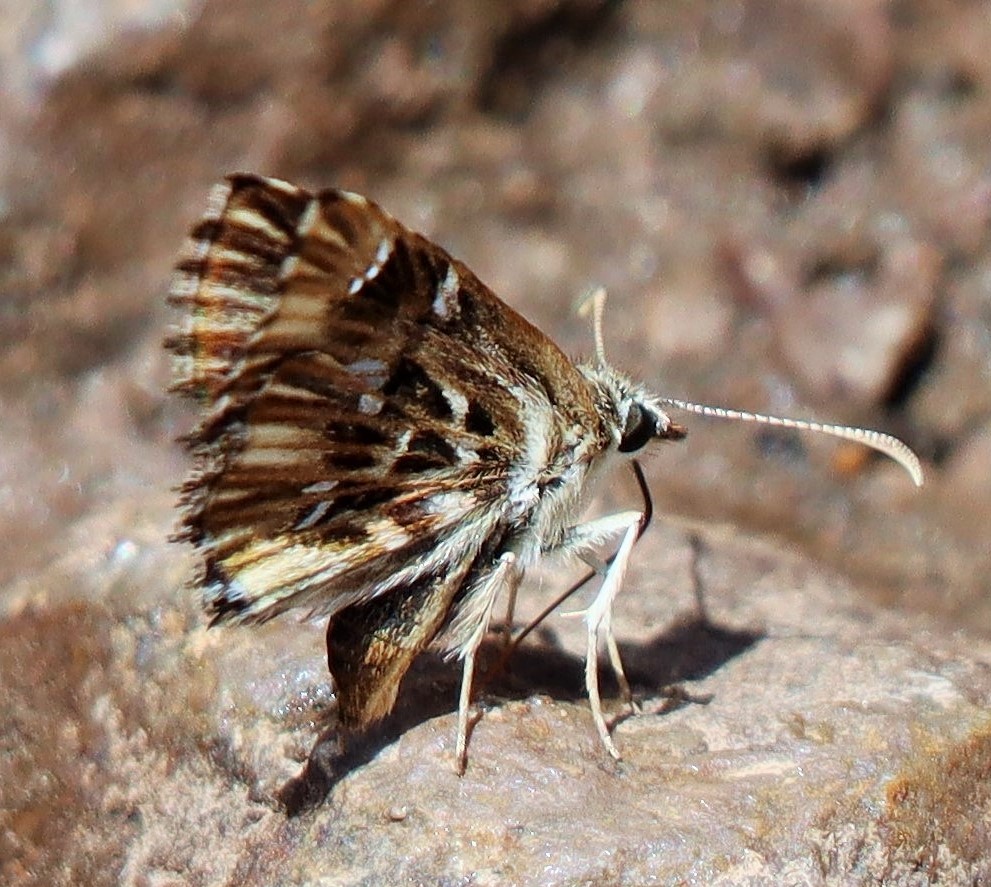
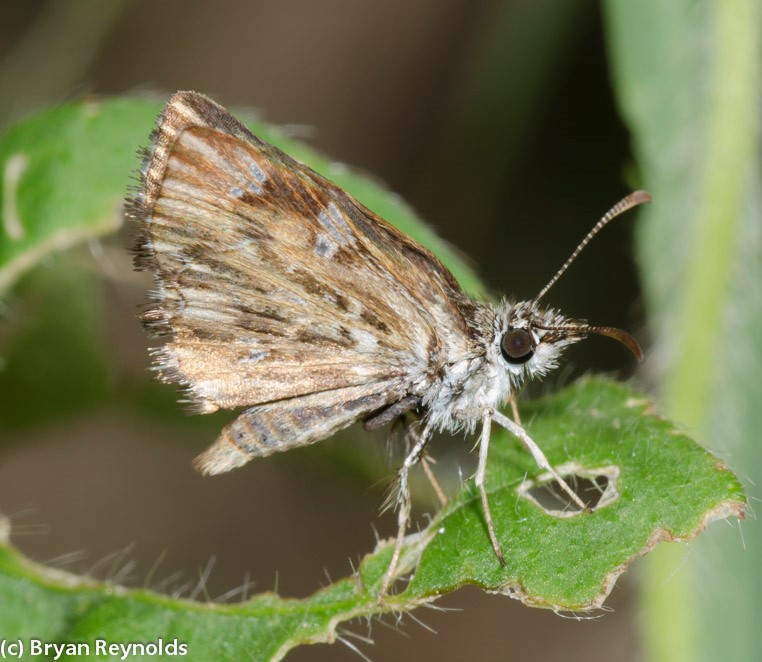
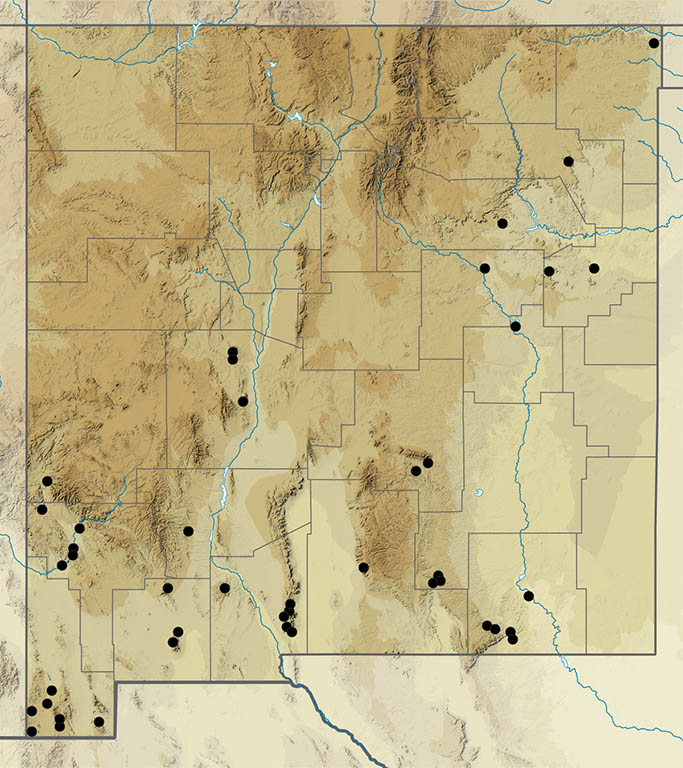
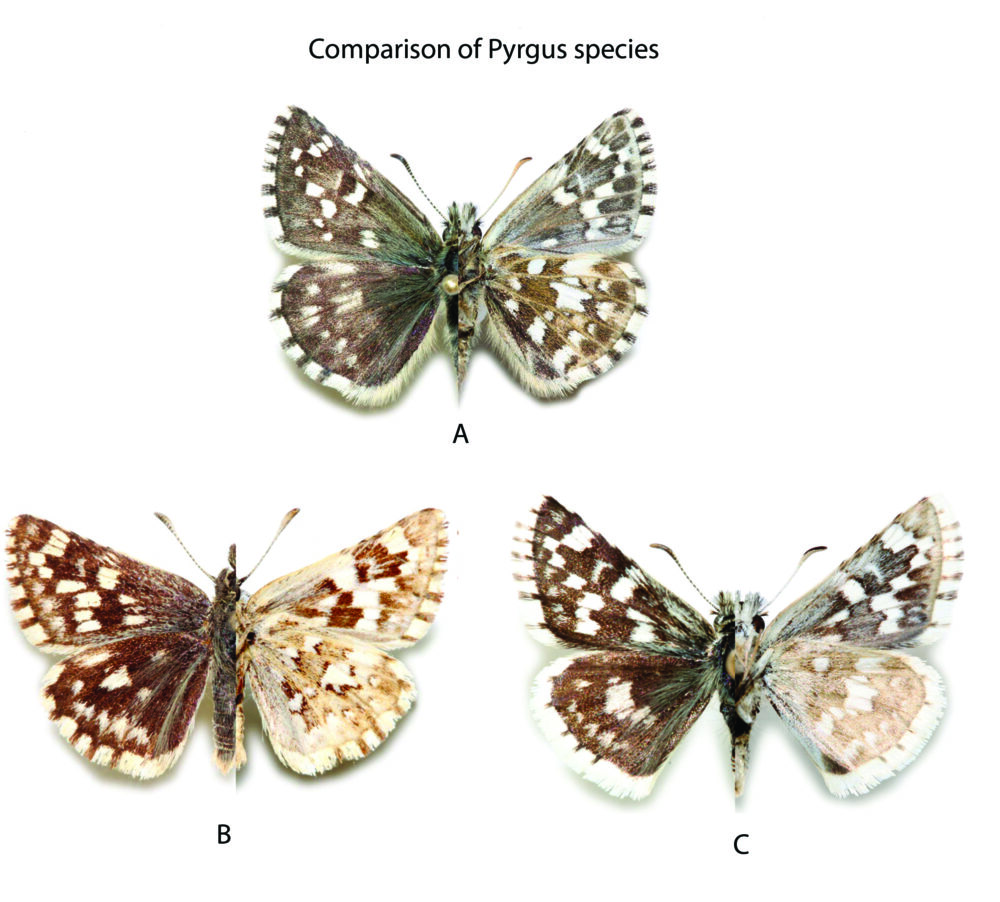
Photos courtesy of Jim Brock and Andy Warren (https://www.butterfliesofamerica.com/index.html).
Pyrgus centaureae (Rambur [1842]) Grizzled Skipper (updated September 1, 2022)
Description. All Pyrgus species are dark gray above, checked with white. Grizzled Skippers have a uniquely yellowish cast and no white spot at the base of the dorsal forewing cell. Ventral hindwing bands are more contrasty than on sister species in the genus. Males have a costal fold, unlike Mountain and Small Checkered Skippers. Range and Habitat. Grizzled Skipper’s arctic/alpine habitat enables it to prevail across Canada, Alaska and northern Asia. Colonies left behind after Pleistocene ice ages survive in the higher Rocky Mountains as far south as northern New Mexico (counties: Co,Mo,RA,SM,SF,Ta), where it lives near and above treeline, from 10,000’ to 12,500′ elevation. Life History. Larvae eat Rosaceae. Scott (1986) reported oviposition on Potentilla diversifolia. Like many tundra butterflies, Grizzled Skippers are biennial: two years are required to complete one generation. Flight. Adults are on the wing between June 5 and August 24, mostly late June and July. Look for them in damp meadows near treeline. Comments. While on the faculty of the Las Vegas Normal School, naturalist and Professor Theodore Dru Allison Cockerell found this species at 11,500′ near Spring Mountain (SM), 1-4 August 1900. Our populations belong to Rocky Mountain subspecies Pyrgus centaureae loki Evans 1953.
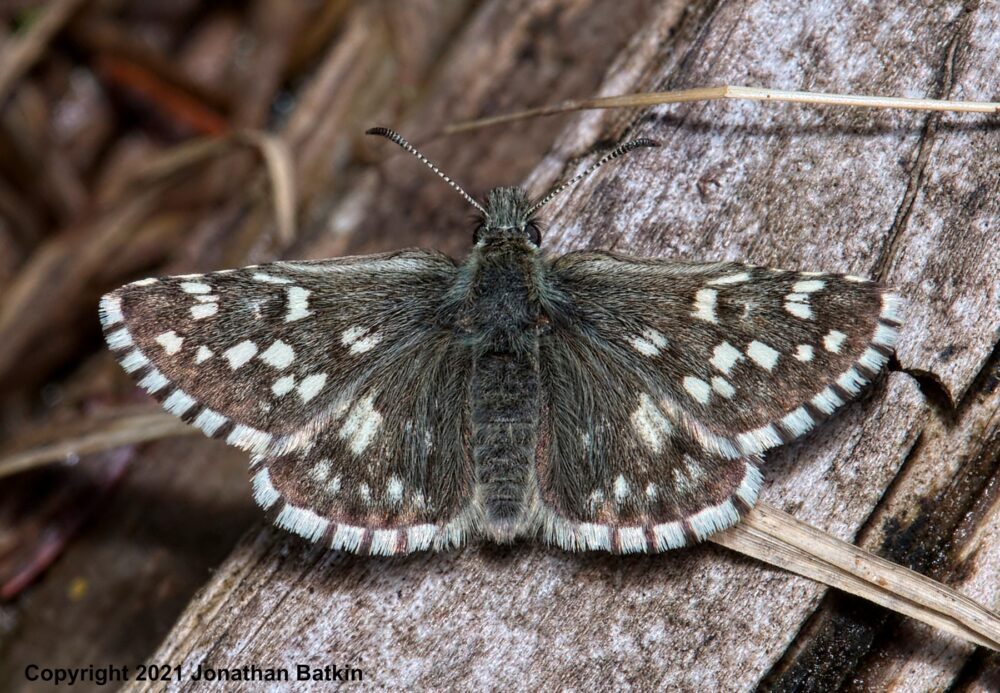
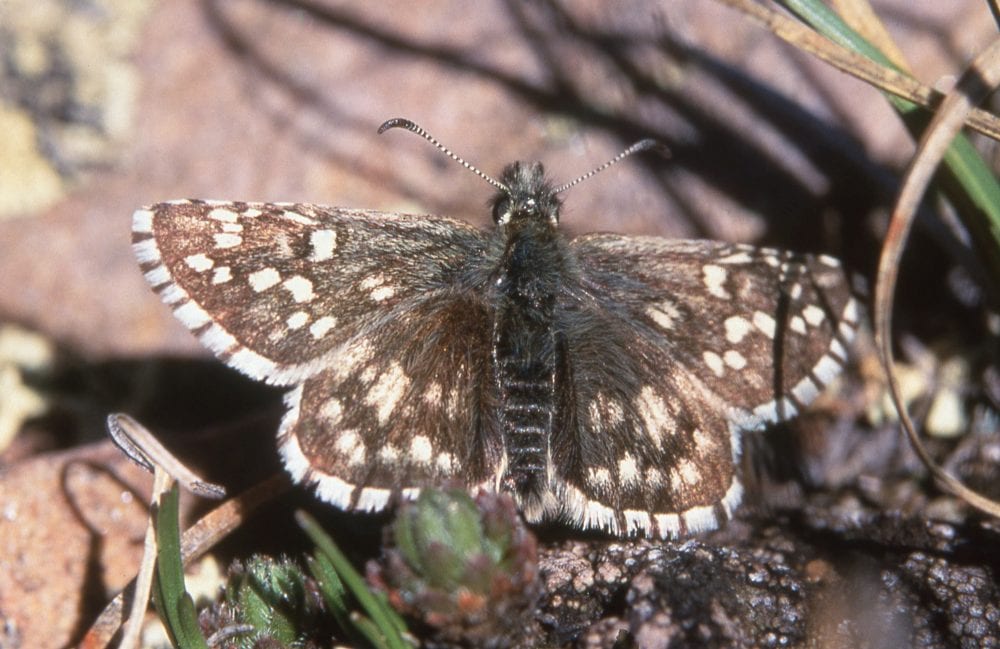
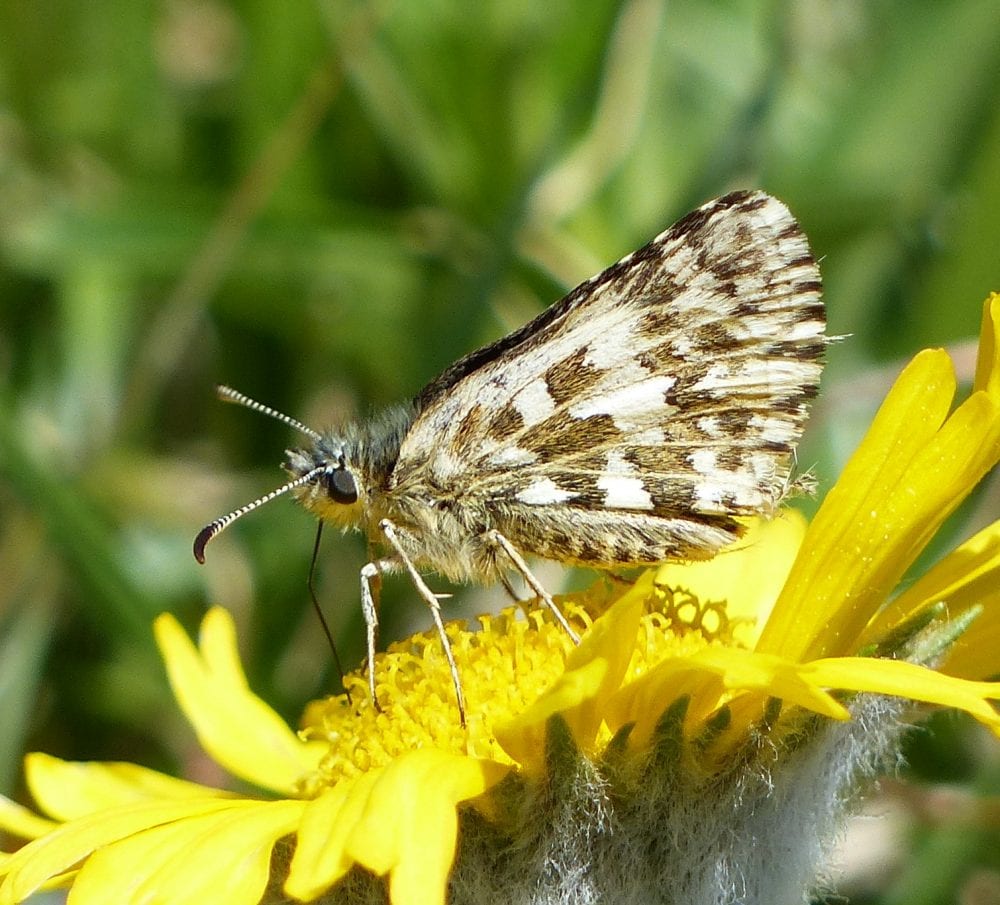

Pyrgus xanthus W. H. Edwards 1878 Mountain Checkered-Skipper (updated September 2, 2022)
Description. This and the next species are tiny and hard to distinguish from each other. Mountain Checkered-Skipper has bolder contrasting marks; the hindwing above has a white basal dot and strong white bands. Bold black checks on the hindwing fringe extend all the way to the edge. The hindwing underside also is more boldly marked. Range and Habitat. Pyrgus xanthus is a Transition and Canadian Zone resident, frequenting pine forest openings in Colorado, Arizona and New Mexico (counties: Ca,Ch,Ci,Co,Li,LA,MK,Mo,Ot,RA,Sv,SM,SF,So,Ta), 6600 to 9800′. Life History. Larvae eat Potentilla species (Rosaceae). Scott (1992) reported oviposition on Potentilla pulcherrima at Hopewell Lake (RA) and on Potentilla subviscosa at Ledoux (Mo). He reported pre-oviposition on Potentilla ambigens at Cloudcroft (Ot) and adults associating with Potentilla hippiana and Potentilla pennsylvanica north of Raton (Co). Flight. This skipper completes one brood per year with adults on the wing from March 25 to June 26, primarily in May. Males fly near the ground or patrol about the host. Both sexes bask on sunny rocks, visit moist soil, and nectar at flowers of the larval host. Comments. This species is easily confused with Pyrgus scriptura, but the strongly checked hindwing fringe is a good character for separating the two.
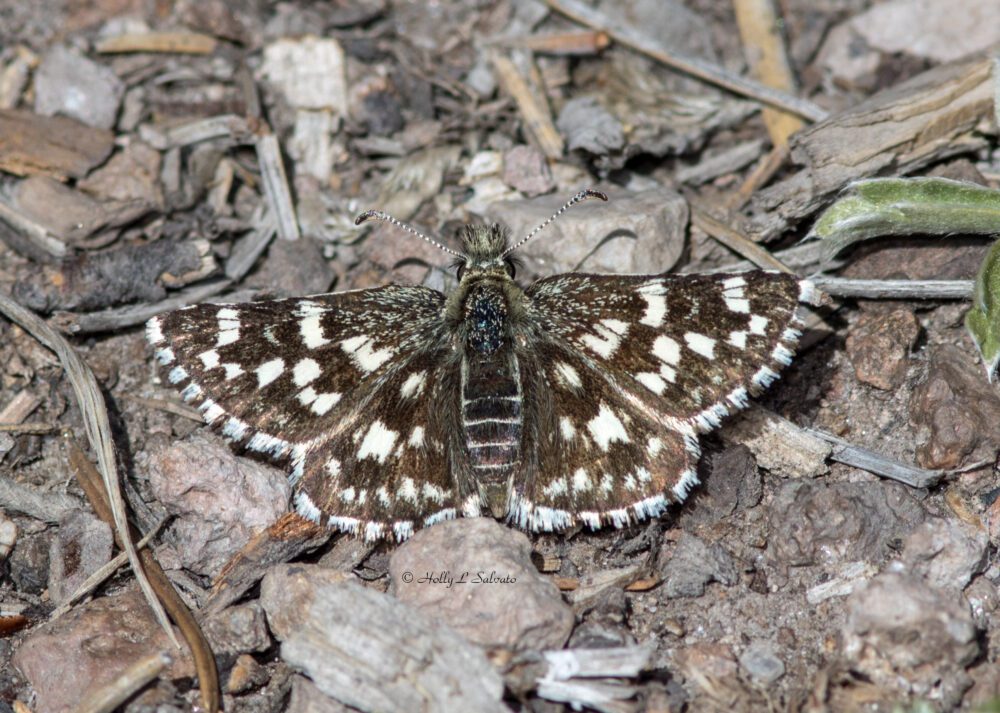

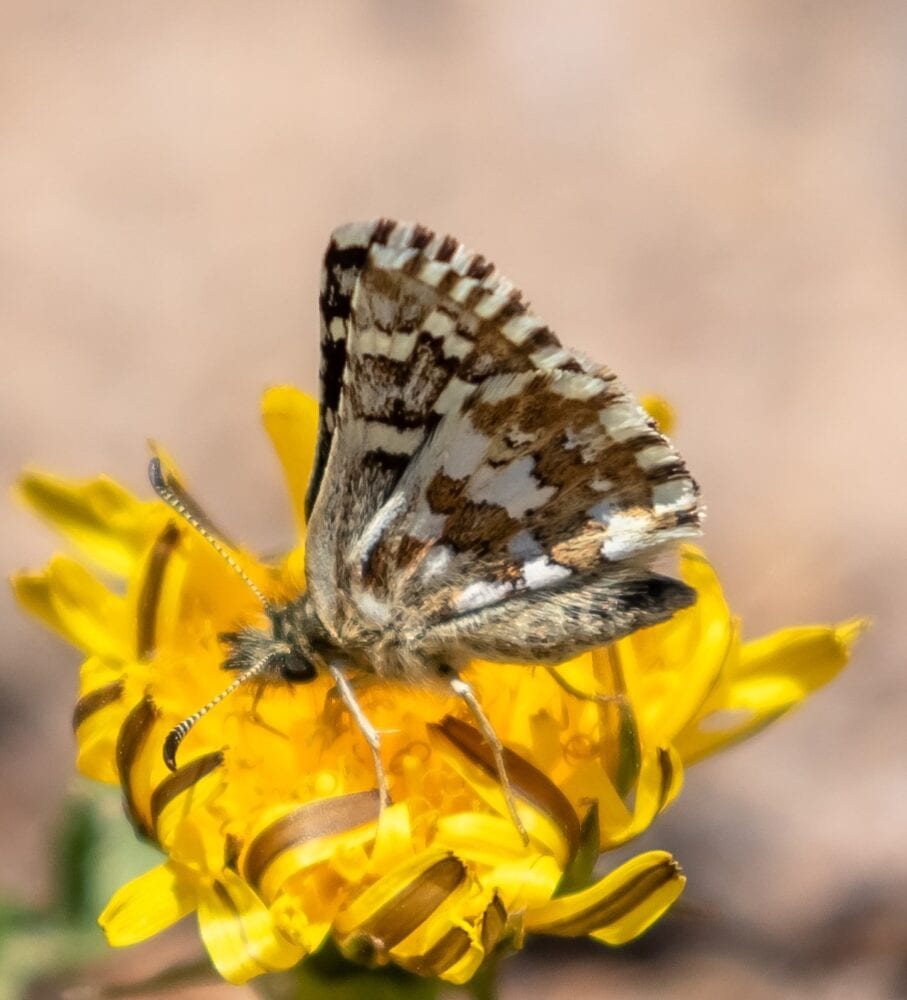
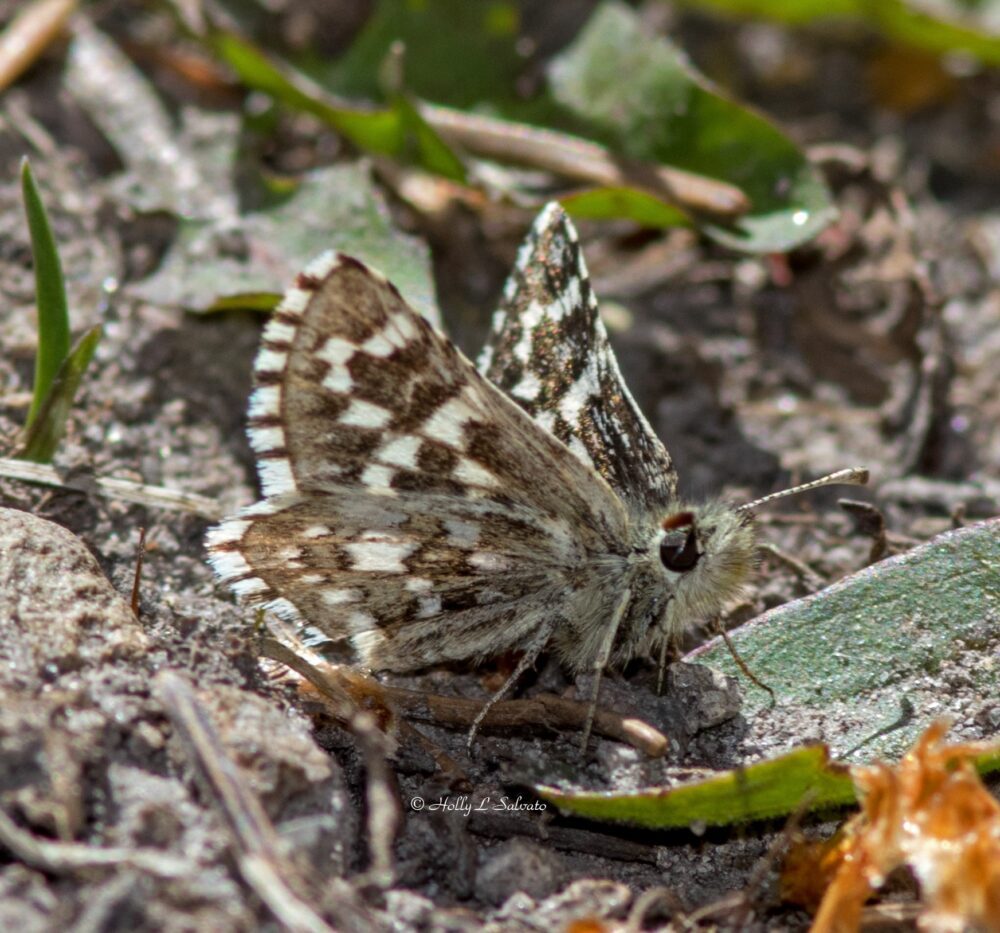

Pyrgus scriptura (Boisduval 1852) Small Checkered-Skipper (updated June 28, 2023)
Description. Pyrgus scriptura is even smaller than Pyrgus xanthus. The hindwing fringe is weakly checked: the dark vein-ends rarely reach the edge. The VHW is typically paler than that of P. xanthus. Range and Habitat. Small Checkered-Skipper lives from the northern Rockies south to Mexico and west to California. In New Mexico, disjunct pockets of this skipper are found somewhat unpredictably in grassy savannas, along prairie watercourses, and in lowland arroyos (counties: Be,Ca,Ch,Ci,Co,DA,Ed,Gr,Ha,Hi,Li,LA,Lu,MK,Mo,Ot,Ro,Sv,SM,SF,Si,So,Ta,To,Un), generally from 3300 to 8000′ elevation. Life History. Scott (1986) reported Sida hederacea, Sphaeralcea coccinea (in Colorado) and Sphaeralcea ambigua (all Malvaceae) as larval hosts. Flight. This species has variable voltinism in New Mexico. Records span March 1 to October 15. In north-central New Mexico there are overlapping broods from April to October, peaking in June. Southern New Mexico has flight peaks in March to April, June and August. Adults fly near the ground, pause at wet sand and seek nectar. Comments. Novelist/lepidopterist Vladimir Nabokov collected butterflies in New Mexico in 1954. A male Pyrgus scriptura taken near Eagle Nest on 23 June survives from that visit (Andrew Warren, pers. com.). We have subspecies P. s. apertorum Austin 1998.
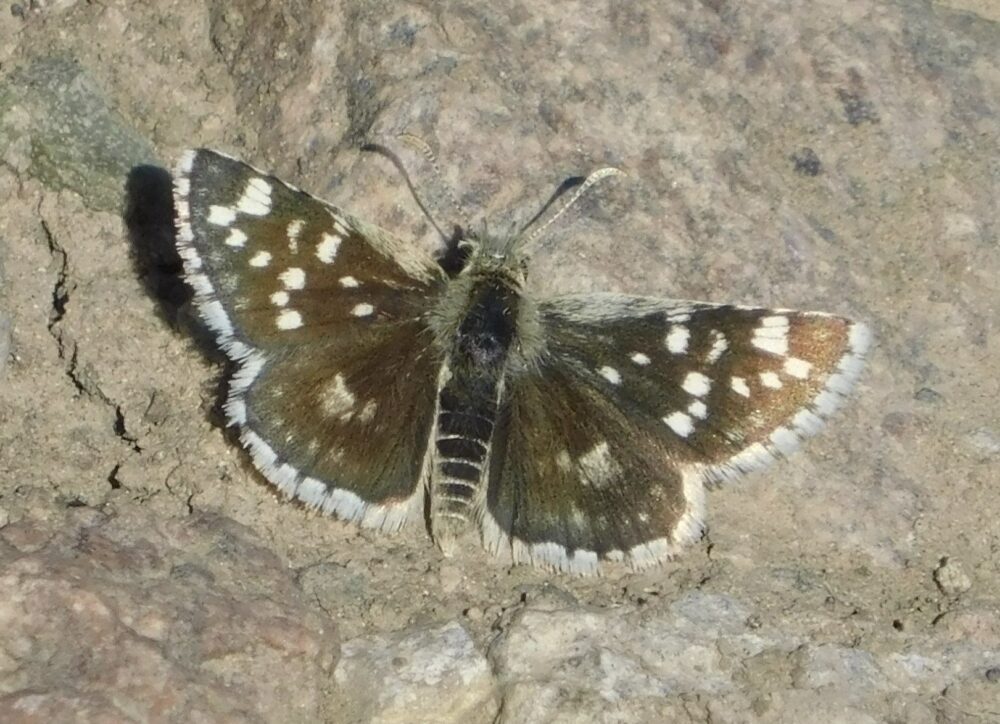
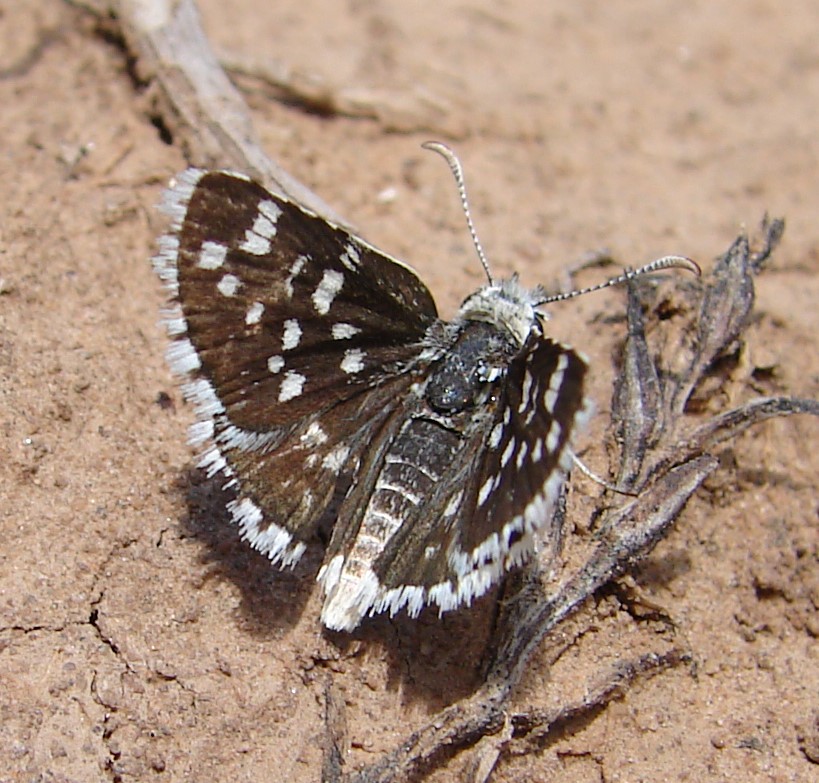
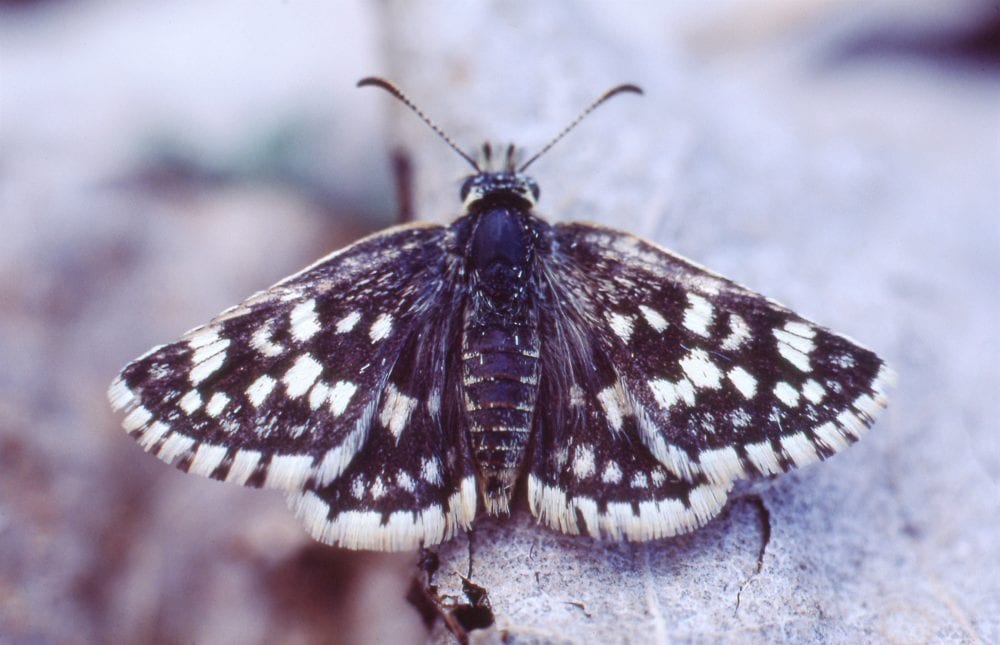
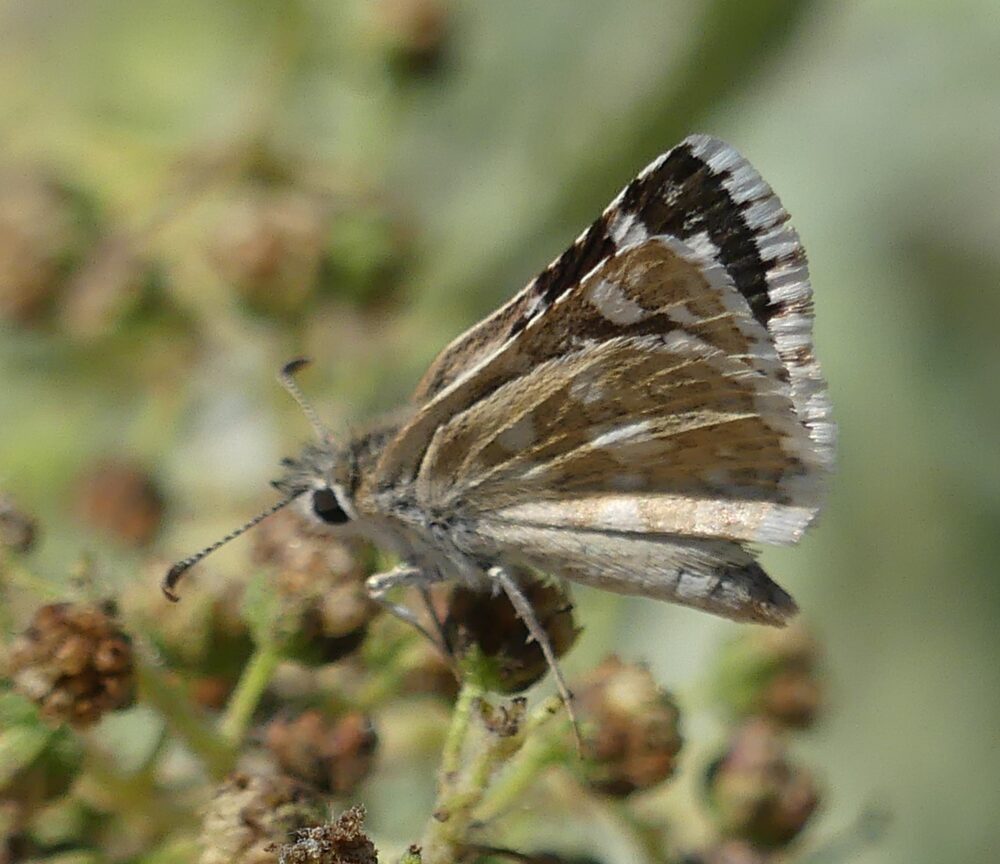
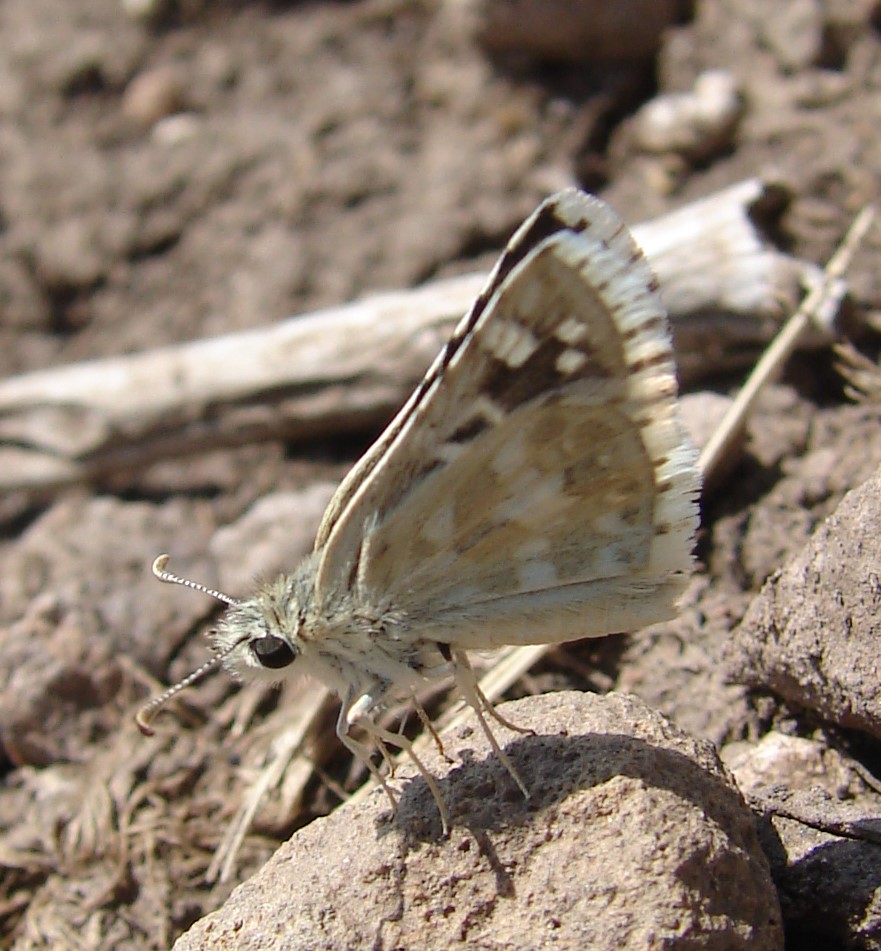
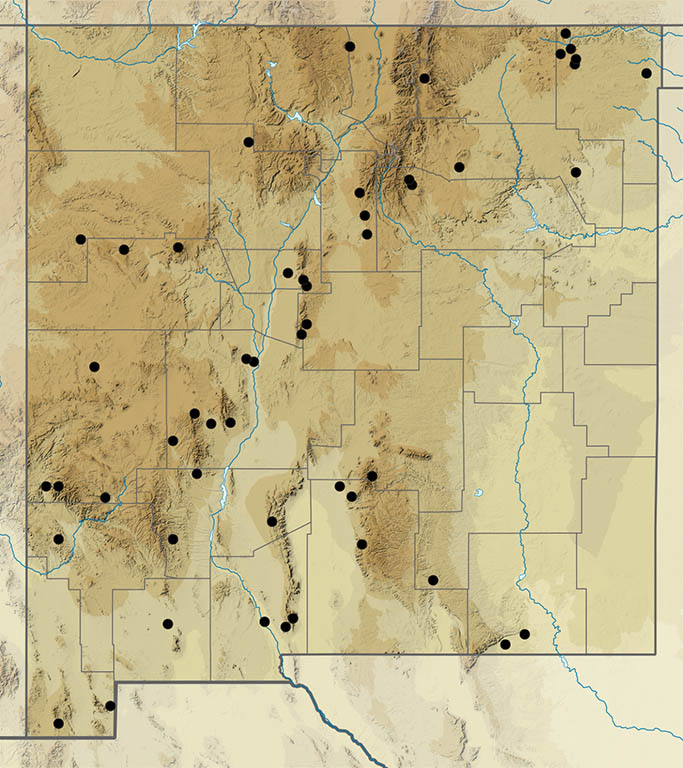
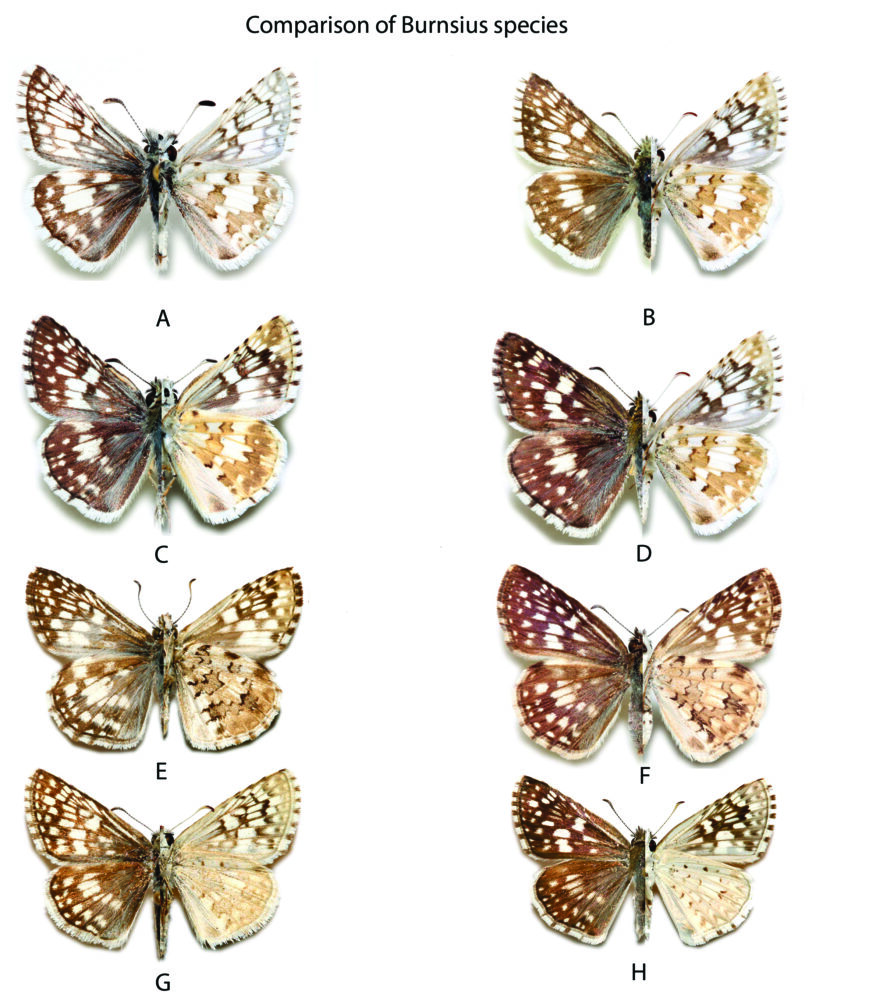
Burnsius communis (Grote 1872), Common Checkered-Skipper, & Burnsius albezens Grishin 2022, Cryptic Checkered-Skipper (updated February 10, 2023)
Description. These two species are best treated as in indistinguishable pair. Dorsally, and not surprisingly, Common/Cryptic Checkered-skippers sport a complex pattern of white checks arrayed against a dark gray to black background. Females have noticeably fewer white marks. The forewing lacks a round white dot in the apex and lacks a white patch in the dark space beyond the hourglass-shaped white patch at the end of the discal cell. Fringes are evenly checkered black and white. On the hindwing underside, Common/Cryptic C-S has postmedian and postbasal bands of olive-tinted spots on a pale, gray-white background; the olive bands vary in expression from bold to faint. Range and Habitat. As a ’complex’ this duo is ubiquitous in New Mexico, across most of temperate North America, and in the Neotropics. Burnsius albezens has the more subtropical range of the two, prevailing in southern New Mexico and below 5000’ elevation. Burnsius communis dominates farther north and up to 10,000′. Our northern tier of counties can reliably be said to have only Common C-S. Learning the full distribution of both forms will require collection and dissection of many specimens. Life History. Larvae eat many species of Malvaceae, including the genera Althaea, Abutilon, Anoda, Callirhoe, Hibiscus, Malvastrum, Modiola, Malva, Sidalcea, Sida and Sphaeralcea. Flight. Adults fly fast near the ground and visit nectar and water. Multivoltine, adults fly until severe cold sets in. New Mexico records span January 24 to December 14, concentrated in the warm season. Comment 1. These two nearly identical taxa were first distinguished from each other in the laboratory by Smithsonian curator John M. Burns (Burns 2000), who dissected genitalia of more than 1,000 specimens. At that time, this confusing pair was thought to consist of B. communis (Common C-S) and B. albescens (White C-S). However, recent work by Zhang, Cong, Burns and Grishin (2022) determined that the name albescens properly belonged to another taxon altogether, a more southerly Mexican subspecies of B. communis, which did not occur in the US. That left the insect we have known erroneously as White Checkered-Skipper without a Latin name. Zhang et al. proposed the name albezens and we apply that epithet here. We also need a new English name, so we propose Cryptic Checkered-Skipper because albezens was so well hidden and because the DNA revolution is revealing so many cryptic species. In long series, Cryptic C-S has a whiter dorsum than Common C-S, but there is so much overlap that identification of individual butterflies is impossible using wing characters alone. Comment 2. Examine male genitalia to be sure of your catch: Burnsius albezens has one tooth on the valve, while Burnsius communis has two. Although separable in the laboratory, distinguishing communis and albezens in the field or even in-hand continues to pose major challenges, with genitalic dissection of males being the clincher. If you butterfly with binoculars or a camera, consider them a complex of two and don’t worry about it. Comment 3. These and the next two species were formerly in the genus Pyrgus, but recent genetic work showed significant differences which prompted erection in 2019 of the new genus Burnsius, appropriately honoring Dr. Burns, as the taxonomic home for several of the checkered-skippers. Comment 4. Sajan KC and Anisha Sapkota have suggested that Common C-S has abundant bluish thoracic hair-like scales while on White C-S those scales are silver/gray. This may eventually become a tool to distinguish the two species in nature.
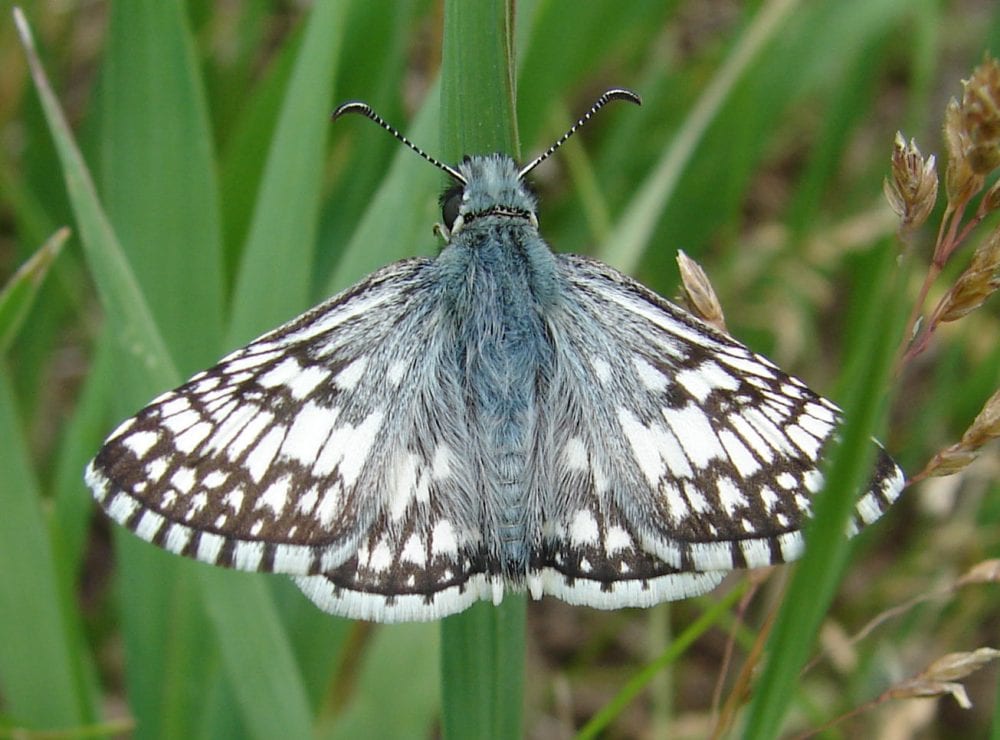
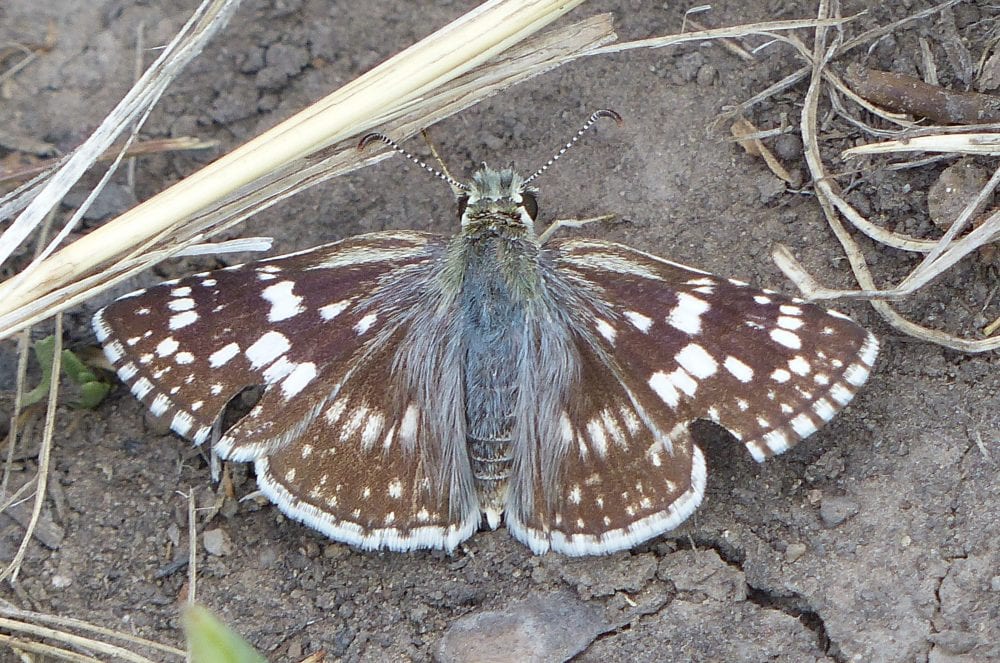
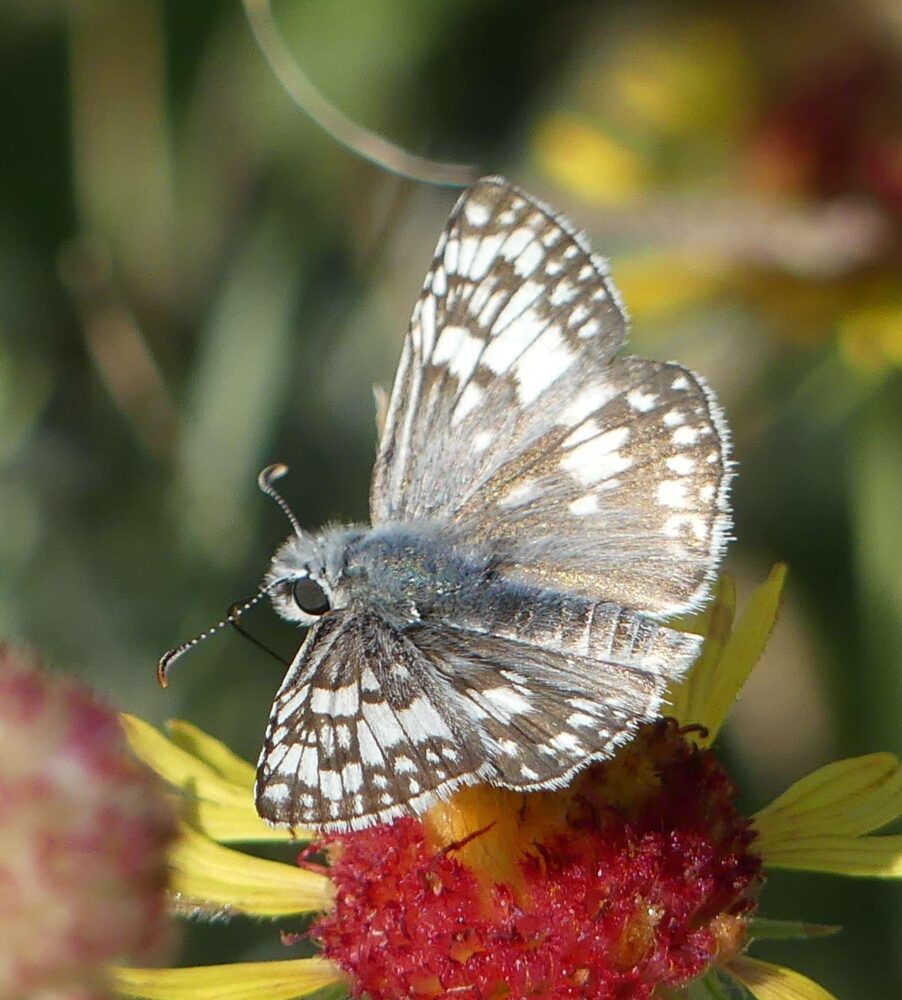
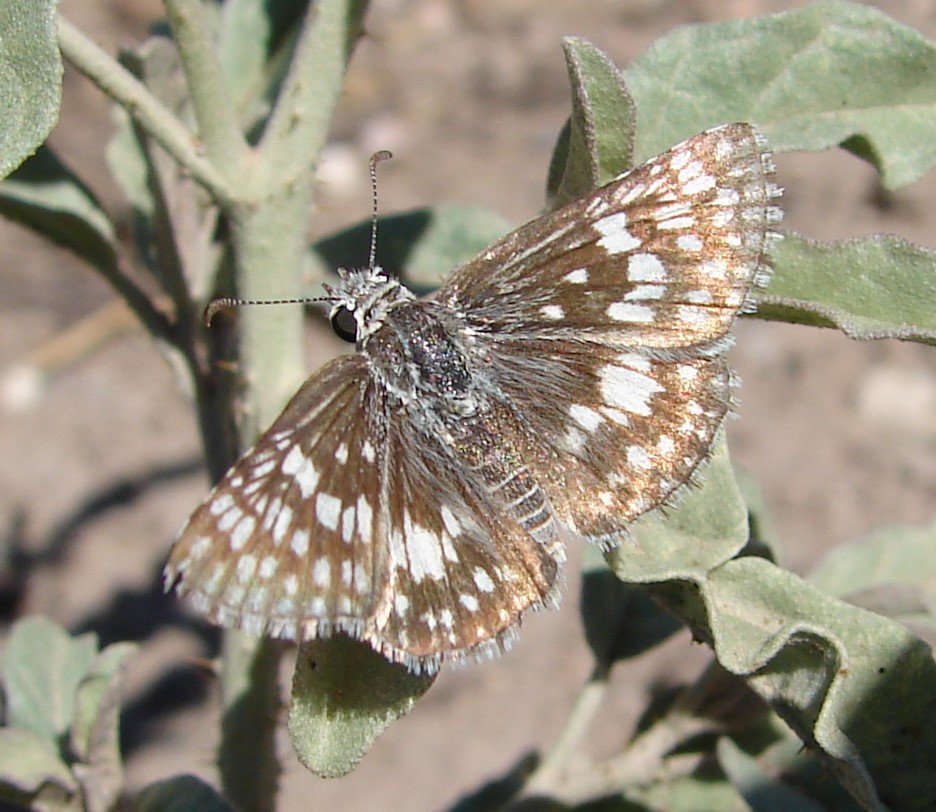
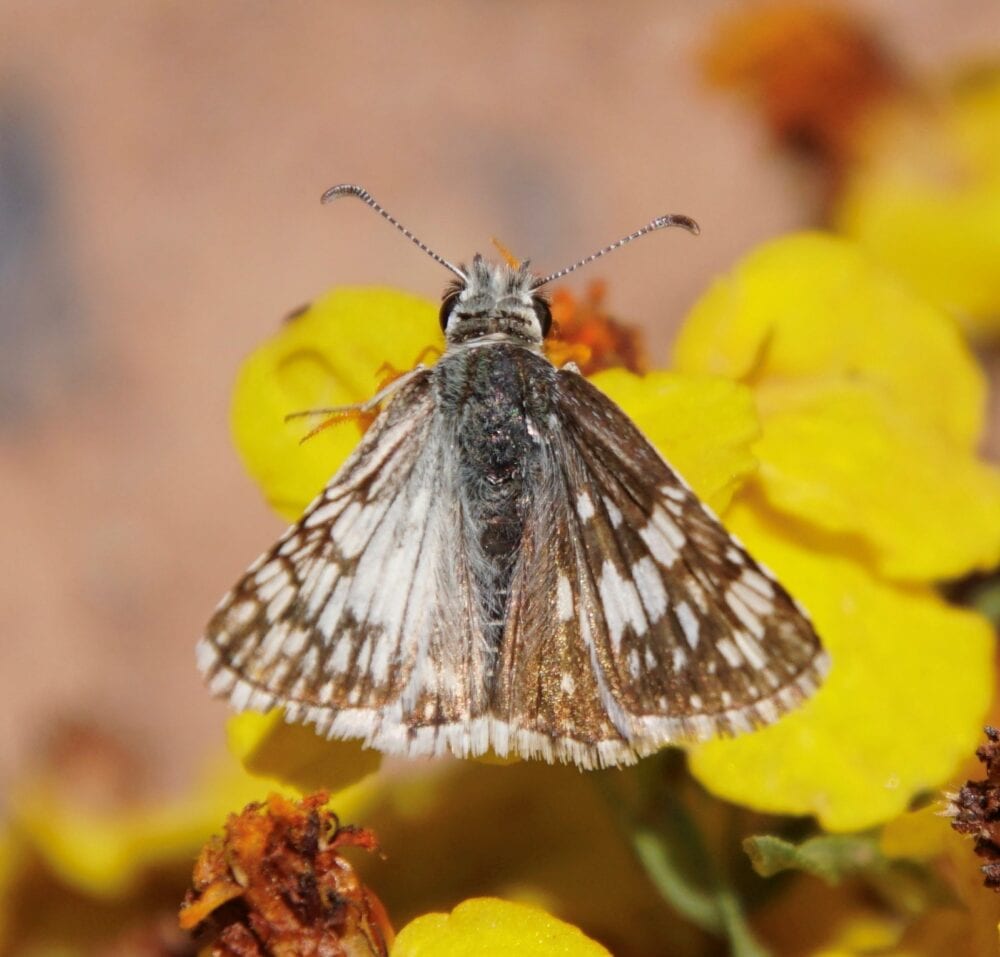
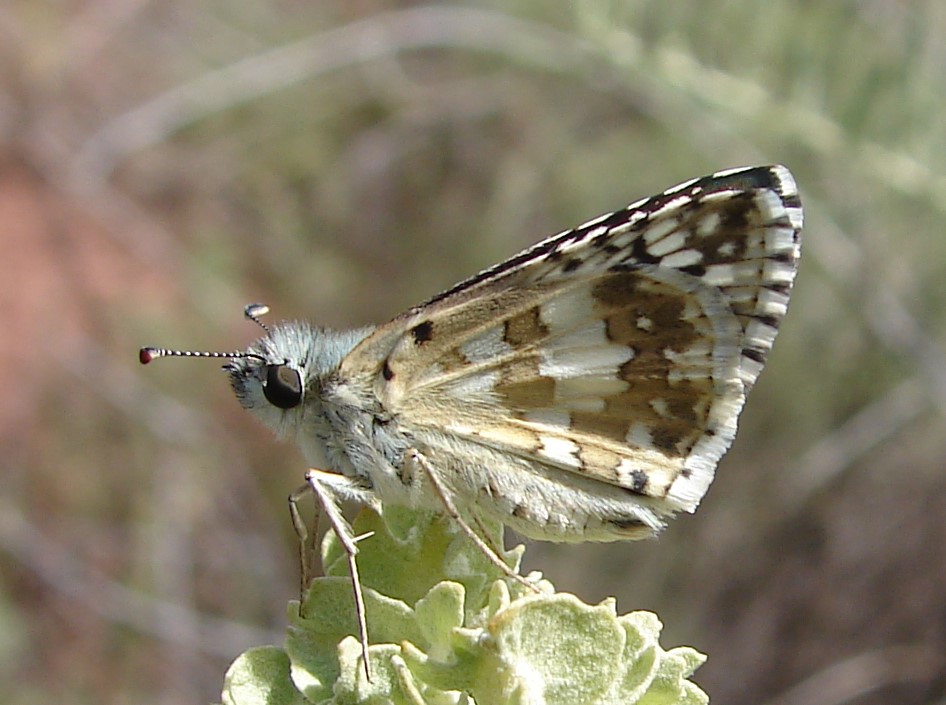
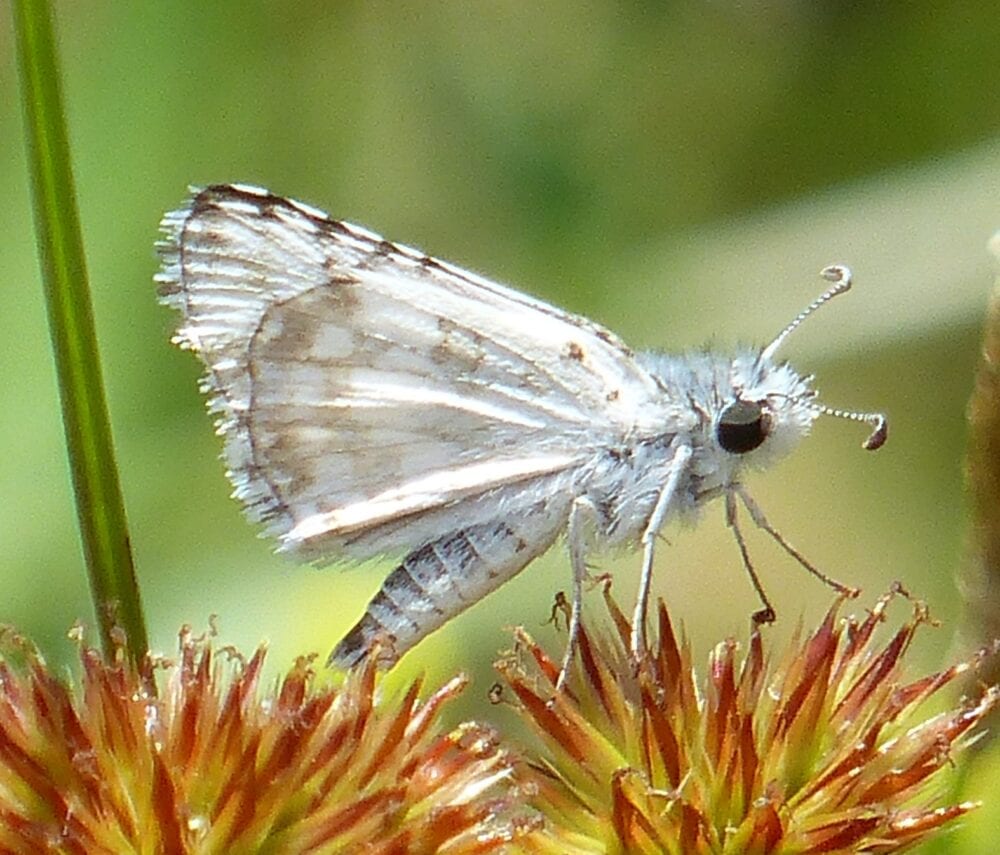
Burnsius philetas (W. H. Edwards 1881) Desert Checkered-Skipper (updated March 16, 2023)
Description. If one looks only at uppersides, this skipper is hard to distinguish from sister species Burnsius communis, Burnsius albescens and Burnsius oileus. To do so, look for two marks that its congeners lack: a white dot at the dorsal forewing apex and a white spot beyond the hourglass-shaped white patch at the end of the discal cell. If you can get a look at it, however, the ventral hindwing is distinctively gray-white with only the faintest of ghostly dark marks, including two black dots near the HW leading edge. Range and Habitat. Desert Checkered-Skipper occurs in Subtropical and Upper Sonoran Zone grassland habitats in Mexico, reaching its northern limits in southern Arizona, central Texas and southern New Mexico (counties: DA,Gr,Hi,Lu). In our state it is usually seen below 5500′ on grassy footslopes and adjacent arroyos draining desert mountains. Life History. Larval hosts are various Malvaceae. Bailowitz and Brock (1991) reported use of Sida procumbens. Flight. New Mexico records span March 6 to November 29. An early spring generation peaks in April; subsequent overlapping broods peak in September and October. Adults seek nectar and sip moisture from damp soil. Its flight is more subdued than that of White Checkered-Skipper, with which it can be easily confused based on uppersides alone. Comments. This butterfly has been observed in the grasslands of City of Rocks State Park (Gr), which have not been grazed by domestic livestock since 1971.
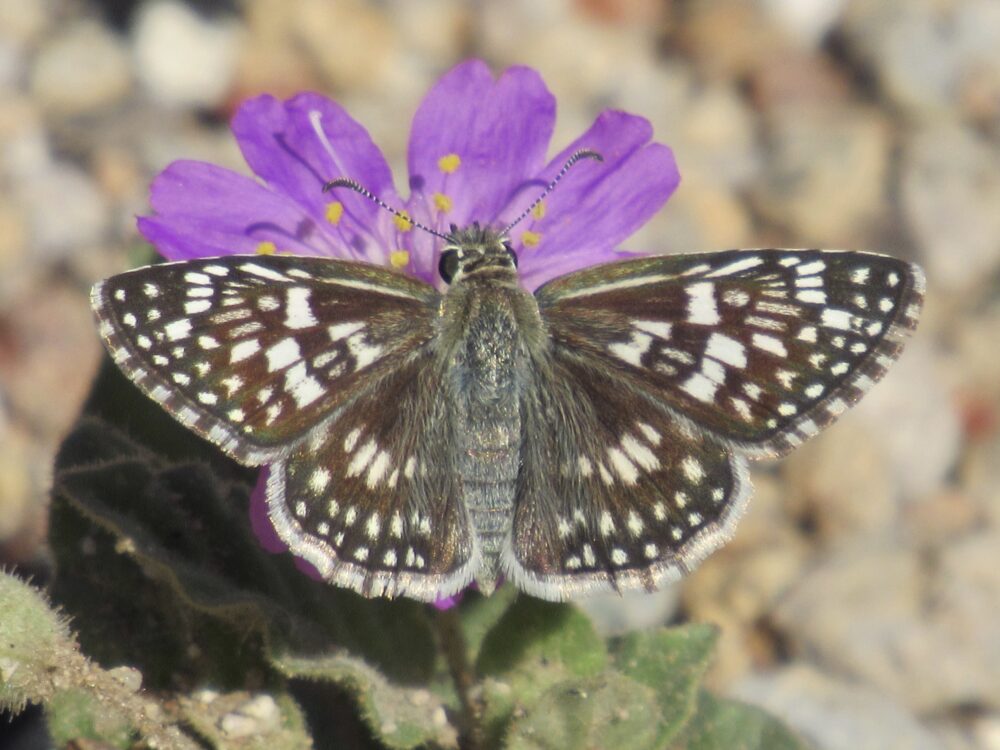
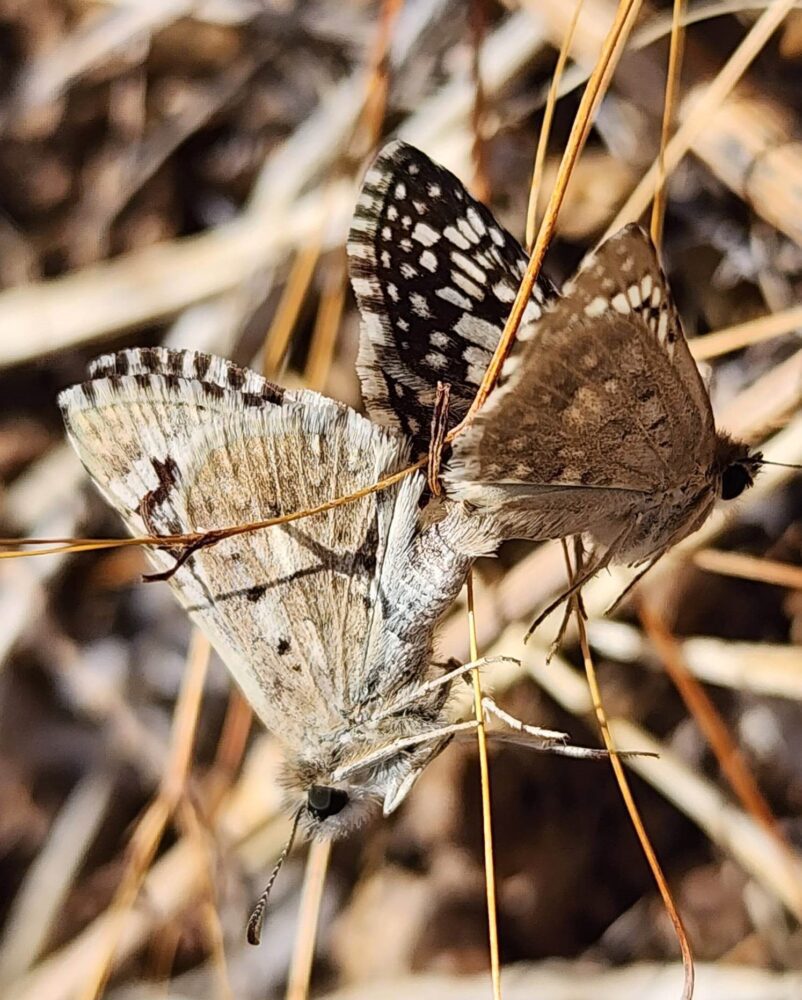
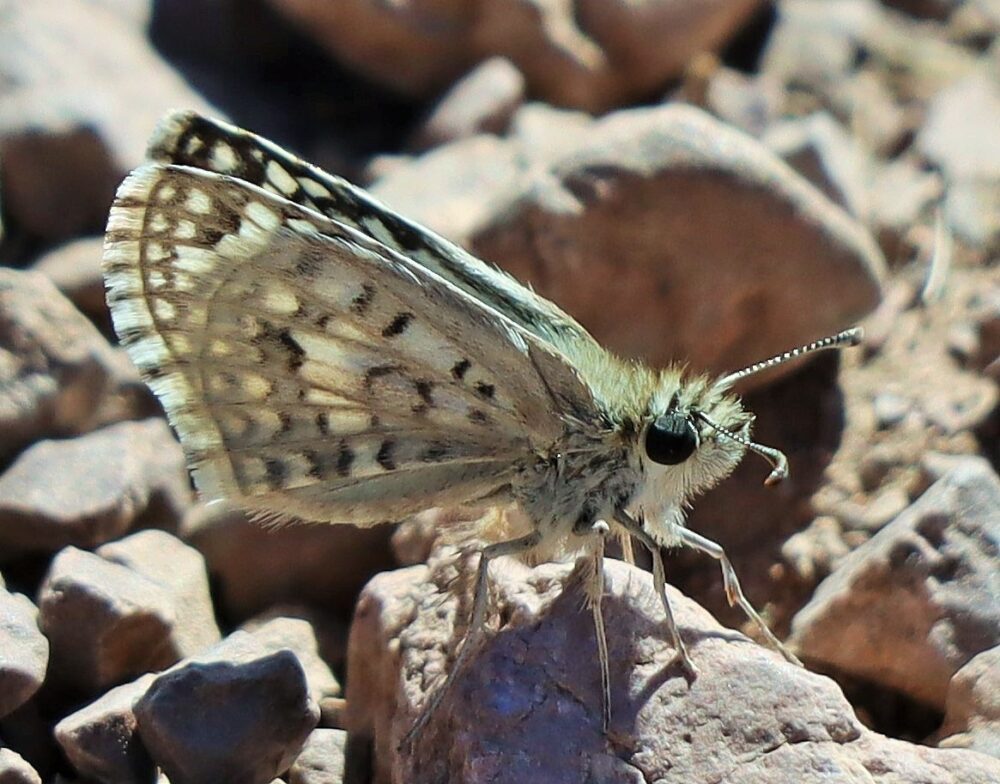
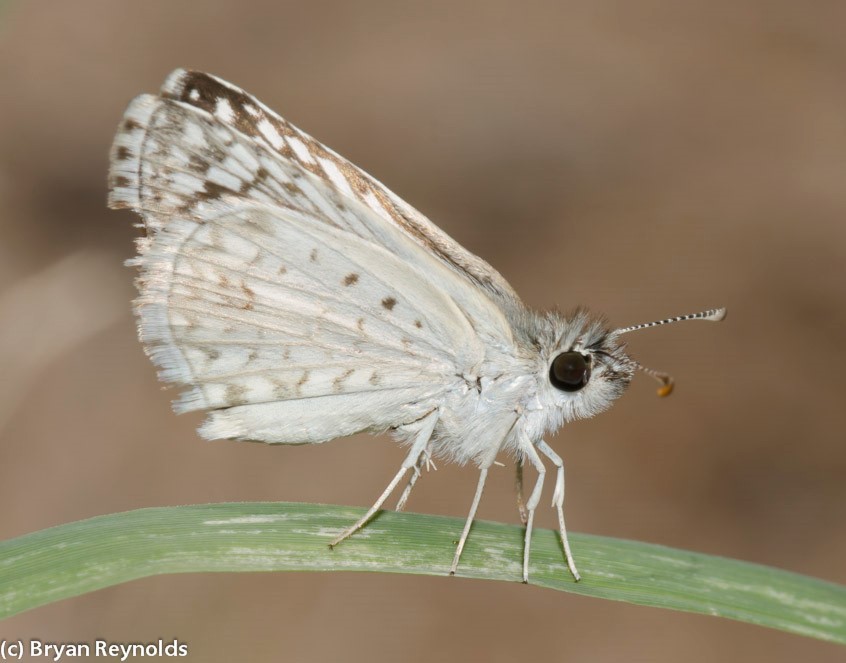
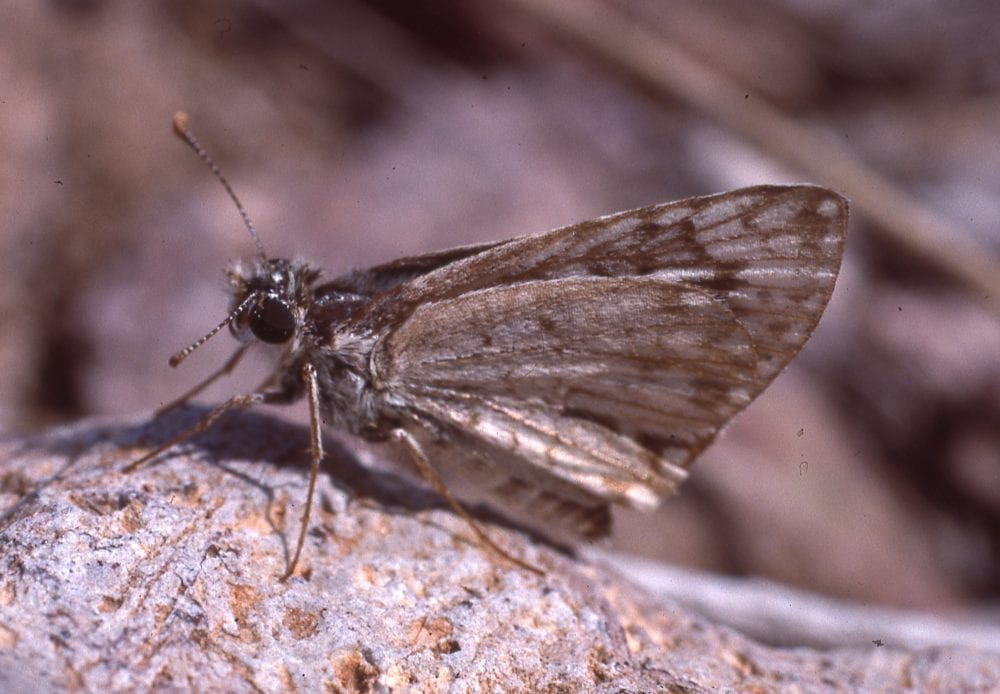
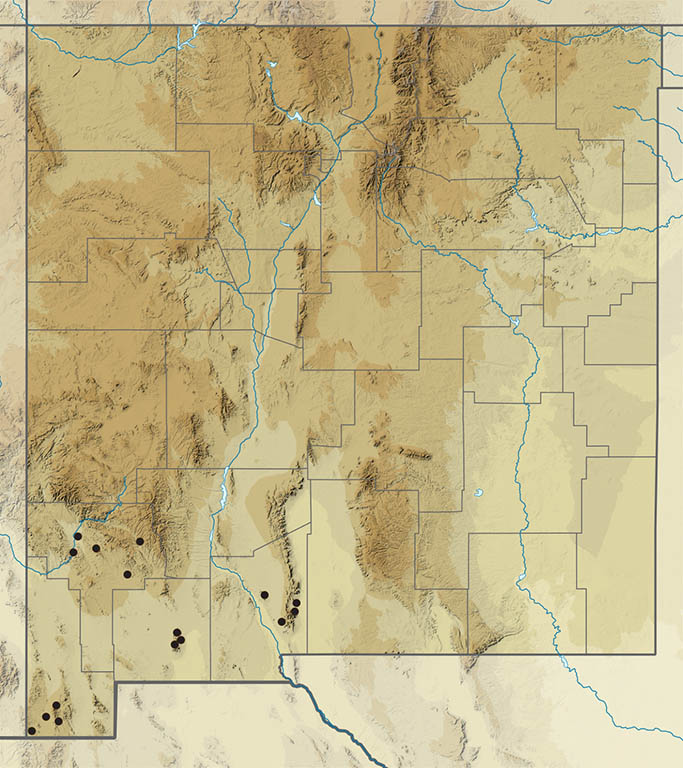
Burnsius oileus (Linnaeus 1767) Tropical Checkered-Skipper (updated September 5, 2022)
Description. Adult Tropical Checkered-Skippers are sexually dimorphic. Females are dark above, while males have a layer of white hairs. Both sexes have a dark area on the forewing fringe. Like Desert C-S, Tropical C-S has a white dot at the dorsal forewing apex and a white spot at the end of the forewing cell, both absent from the similar Common C-S and White C-S. Burnsius oileus has a boldly-patterned hindwing below and tends to be larger than the other Burnsius species. Range and Habitat. Tropical Checkered-Skipper lives in much of the Neotropics, including south Florida, south Texas and possibly southern Arizona, from where it may wander even farther north. In New Mexico it is a rare stray in Upper Sonoran riparian situations (counties: Gr,Hi). Life History. Larval hosts are Malvaceae such as Sida rhombifolia in Texas (Kendall 1976), but there is no evidence of reproduction in New Mexico. Flight. Our few records were logged between late March and late April. Burnsius oileus is likely to be multivoltine farther south, but it is only a stray here. Adults fly near the ground and come to nectar. Comments. Dale Zimmerman and P. Hoyt collected one below the mouth of Pacheco Canyon in the Gila River Valley on 31 March 1964 (det. C. D. Ferris). Paul Opler reported it from Eick’s Creek in the Animas Mountains (Hi), 27 April 91.
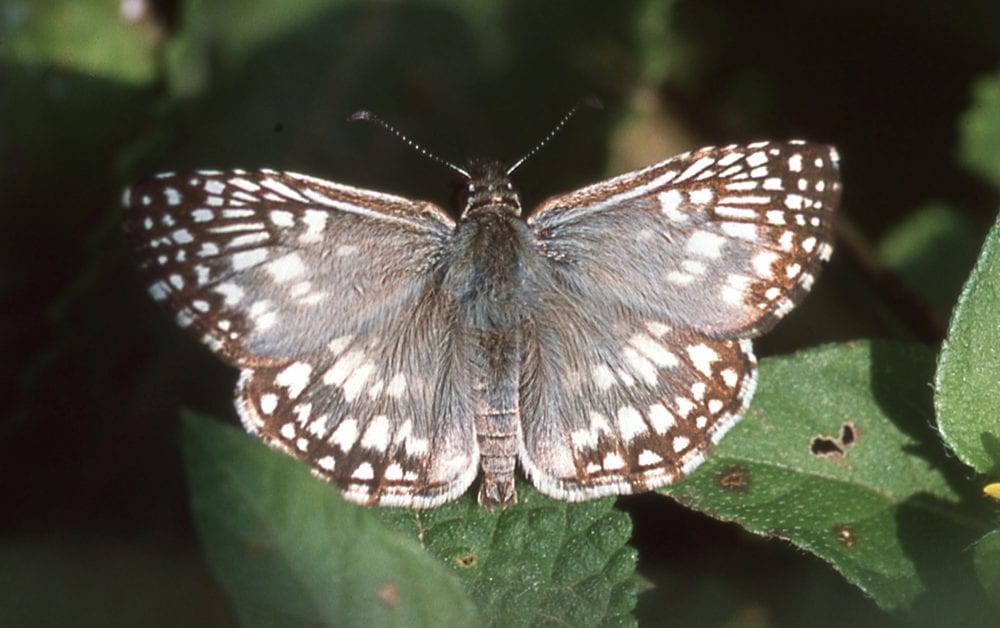

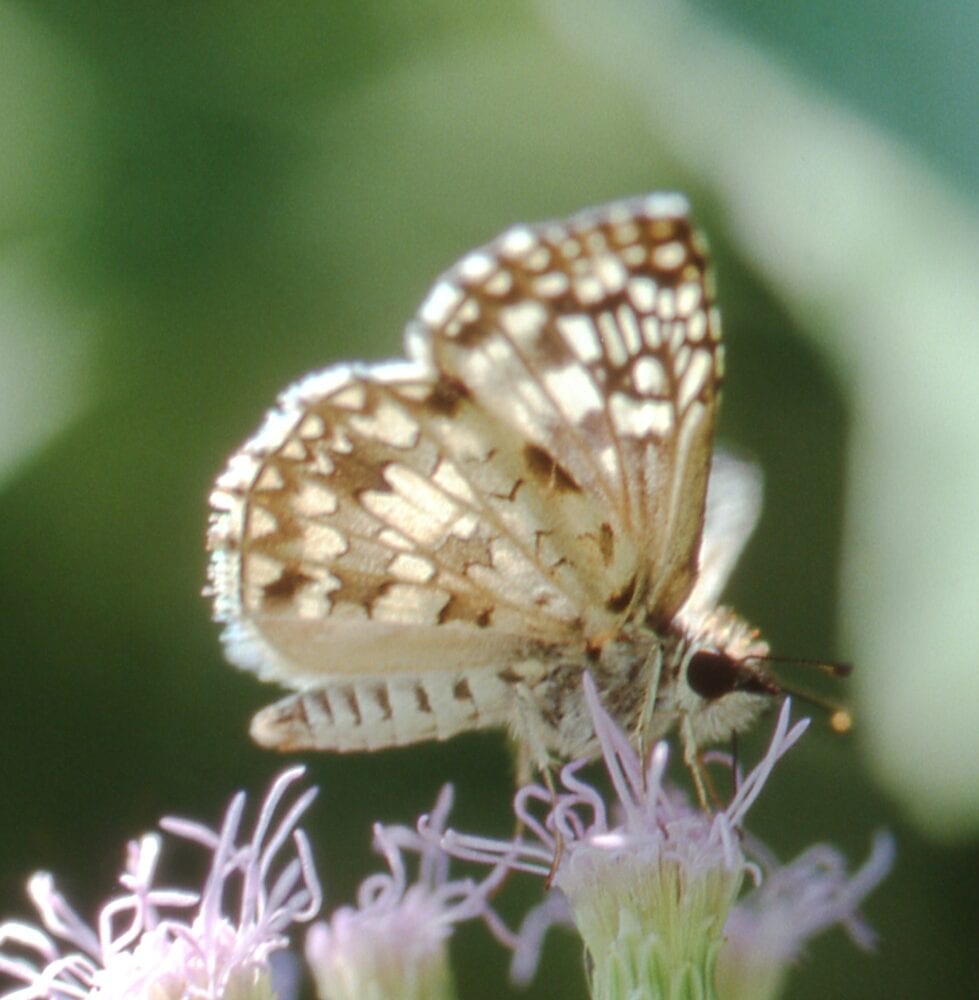
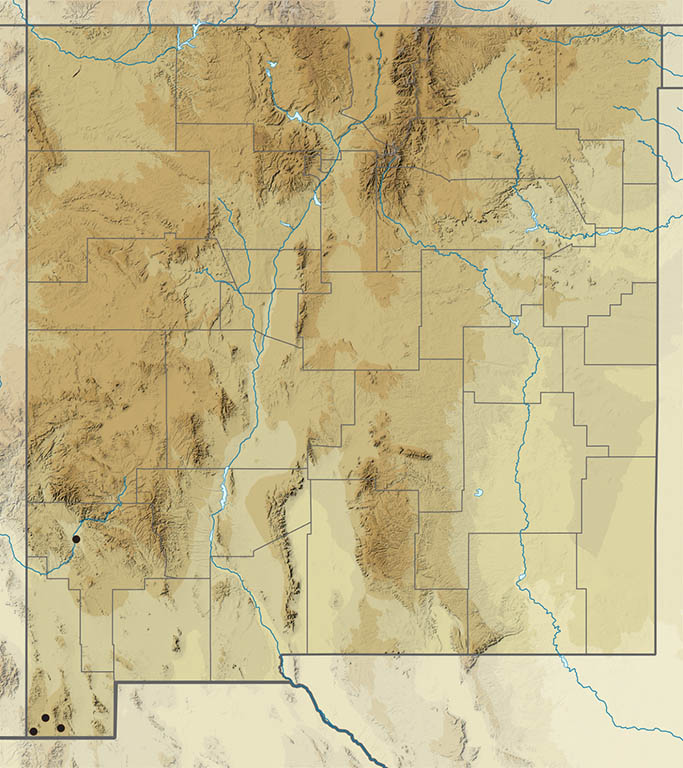
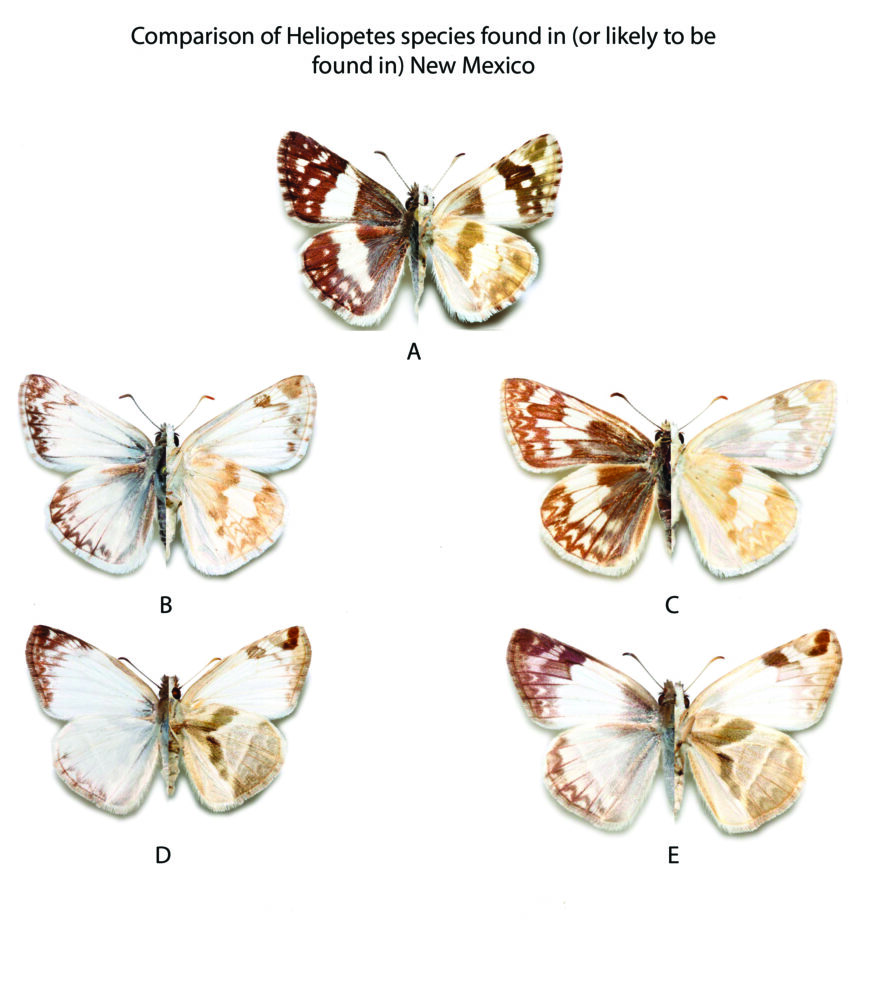
Heliopetes domicella (Erichson [1849]) Erichson’s White-Skipper (updated October 6, 2022)
Description. Though superficially like the various checkered-skippers, Erichson’s White-Skipper stands out with a bold, broad, white band crossing dark upper wing surfaces. Males and females are similar but can be confused with female Northern White-Skipper. Erichson’s has more clearly marked and straighter borders to the white band on the upper surface. Range and Habitat. Heliopetes domicella is a Mexican skipper whose northern breeding limits extend from southeast Arizona to west Texas, including southern New Mexico (counties: DA,Hi,Lu,Ot). Life History. Malvaceae (mallows) are the larval hosts. Larvae were found on Abutilon incanum ,A. palmeri and Herrisantia crispa in southeast Arizona (Bailowitz and Brock 2021). It is double-brooded there, with flights in spring and late summer. Flight. Our growing cache of records span March 8 to November 14, so it seems to be double-brooded in southern New Mexico, too. Bailowitz and Brock (2022) noted that larvae of Erichson’s White-Skipper don’t diapause, simply taking longer to develop in colder weather. Adults patrol arroyo bottoms and come to nectar sources such as Apache plume. Comments. Some authors place this butterfly in the genus Heliopyrgus. Multiple Doña Ana County sightings over 2017-2022 suggest it does breed there, at least seasonally.
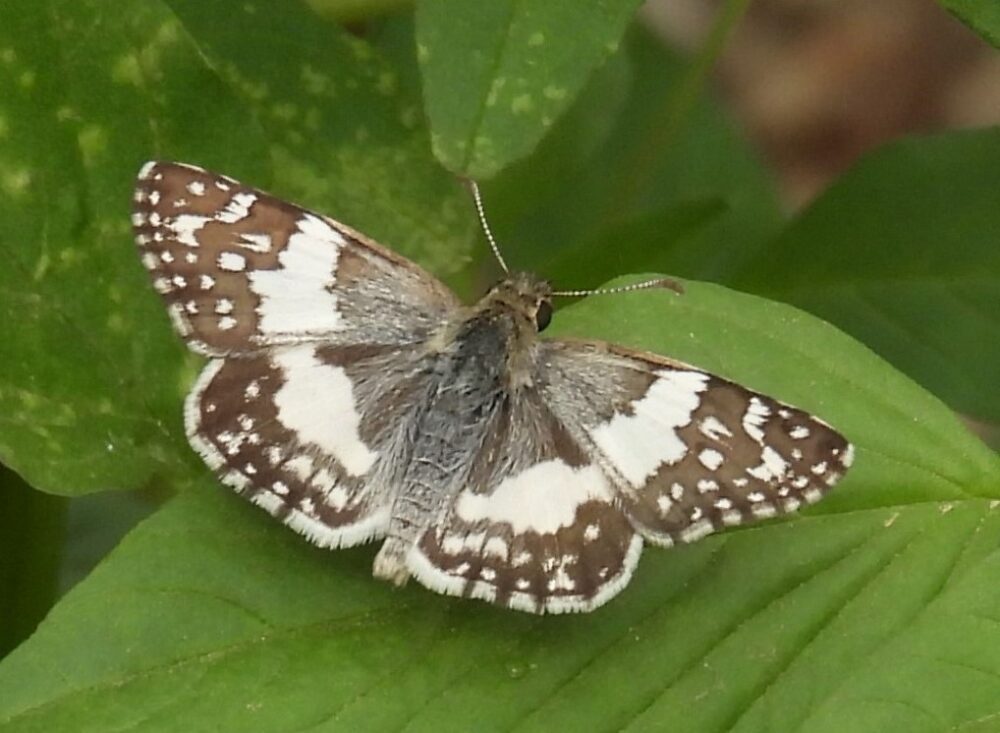
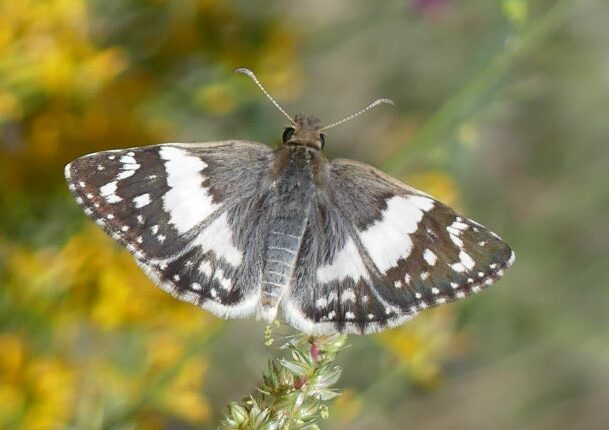
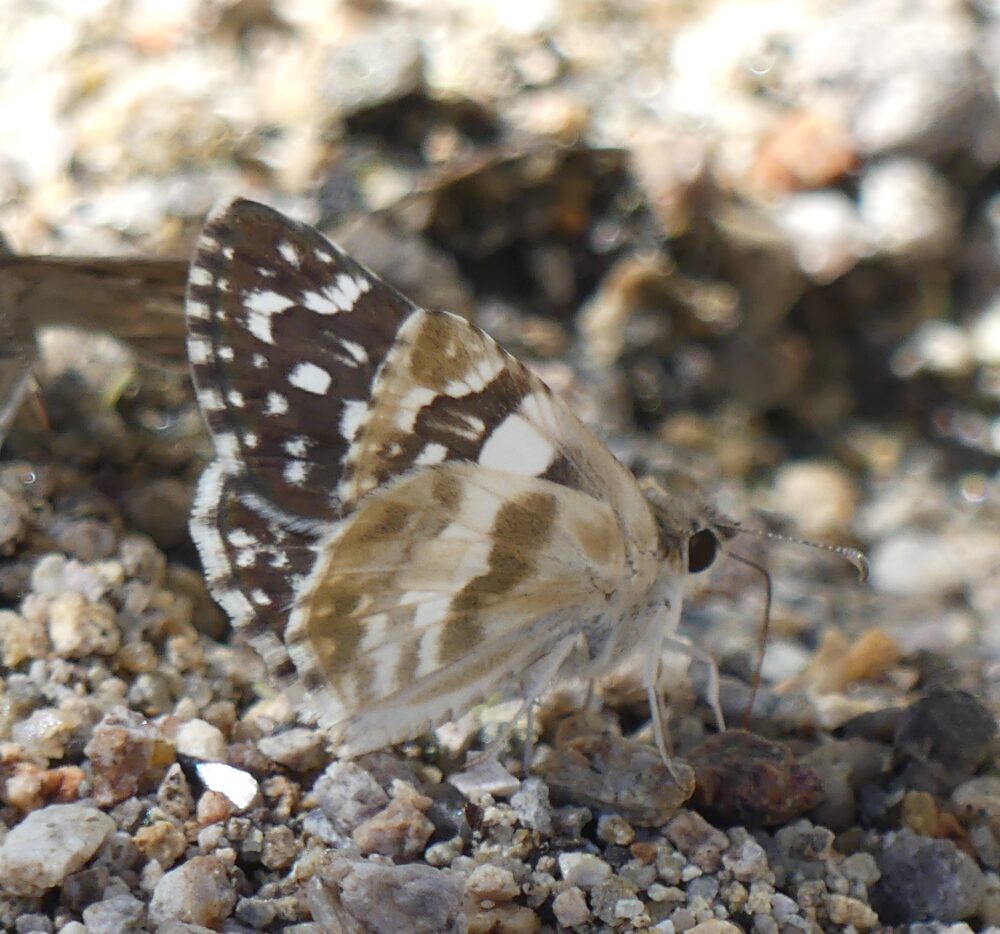
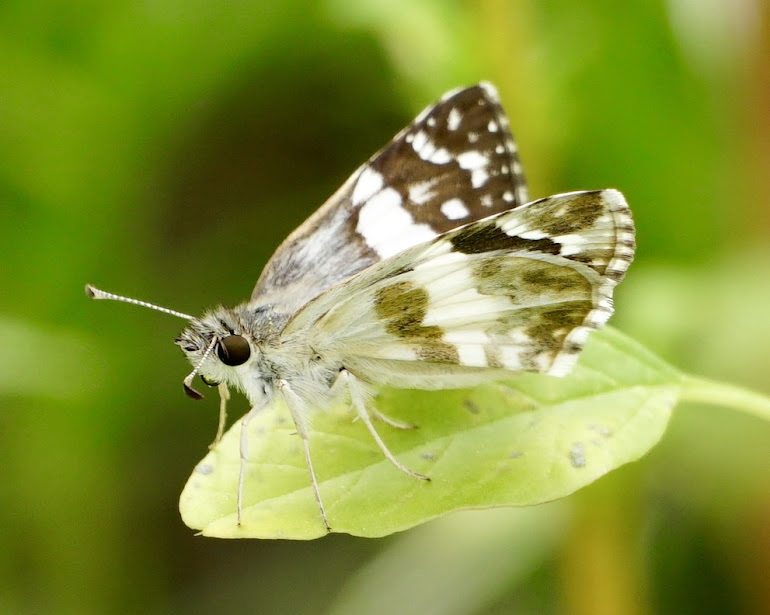
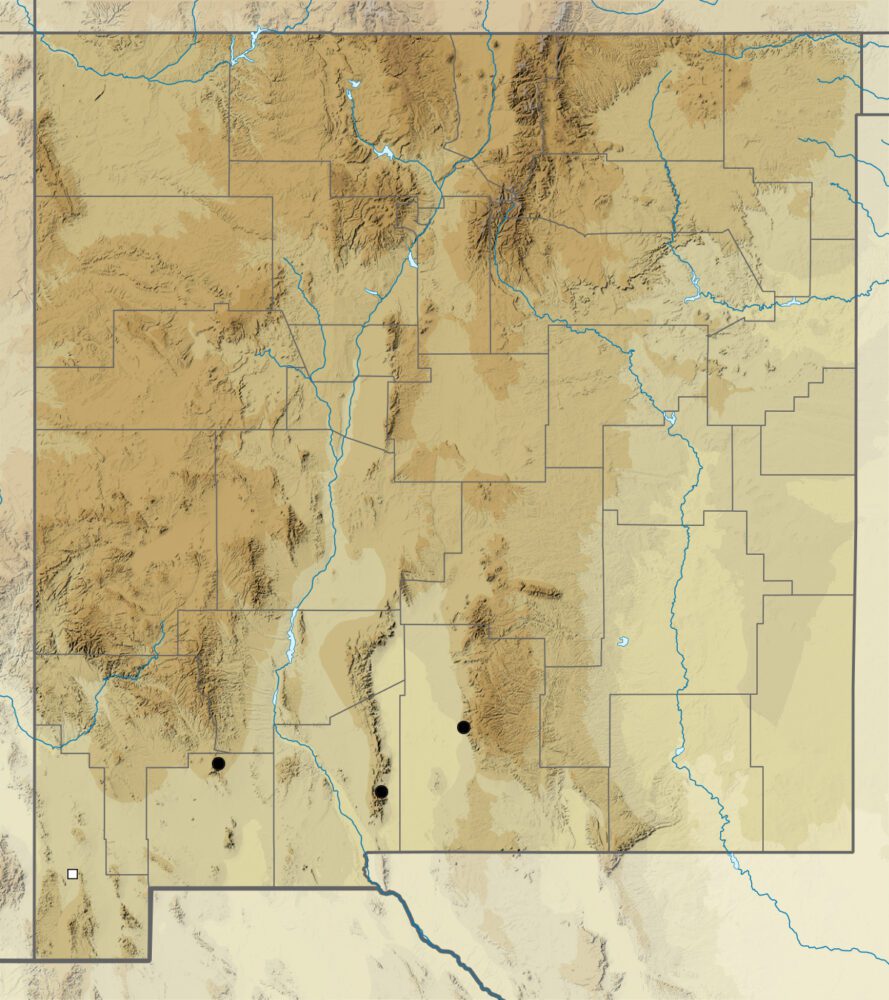
Heliopetes ericetorum (Boisduval 1852) Northern White-Skipper (updated October 18, 2023)
Description. This smallish skipper is sexually dimorphic. Males are white dorsally with black marginal hieroglyphics. Females have a white dorsal band across black wings like Erichson’s White-Skipper, but the band is more diffuse and the ventral forewing is white at its base. Range and Habitat. A widespread North American member of this genus, Heliopetes ericetorum ranges from eastern Washington south into Mexico. It lives in Upper Sonoran Zone (6000 to 7000′) canyons of the Colorado Plateau, including northwest New Mexico (counties: Ca,Ci,Gr,Li,MK,RA,SJ), where it is never common. Life History. Various Malvaceae and Sterculiaceae are larval hosts. Ovipositions on Sphaeralcea fendleri are reported from southeast Arizona (Bailowitz & Brock 2021). Flight. Our few reports suggest two generation, one peaking in June and a second in early autumn. Specific New Mexico records span May 22 to October 2. Males establish territories along gully bottoms. Adults come to nectar and water. Comments. The first New Mexico record of this species is credited to John Woodgate, who collected a male near Fort Wingate (MK) on 12 June 1910. The specimen is in the American Museum of Natural History.
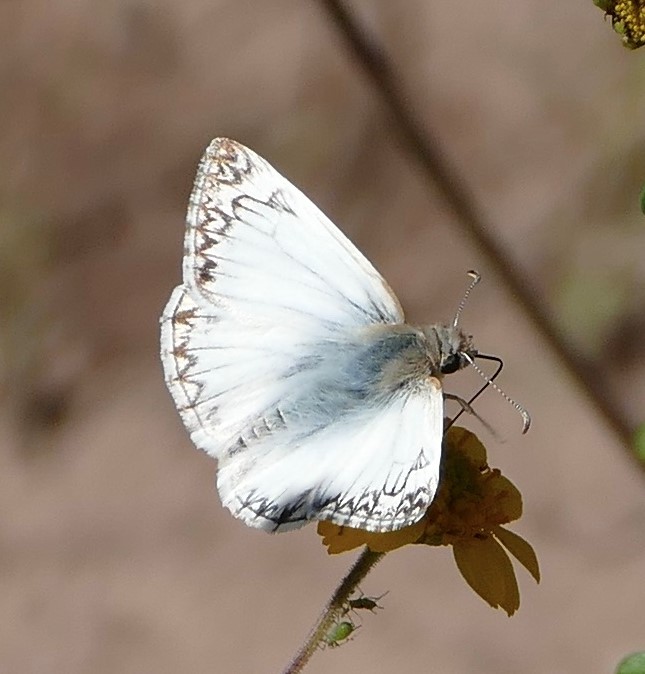

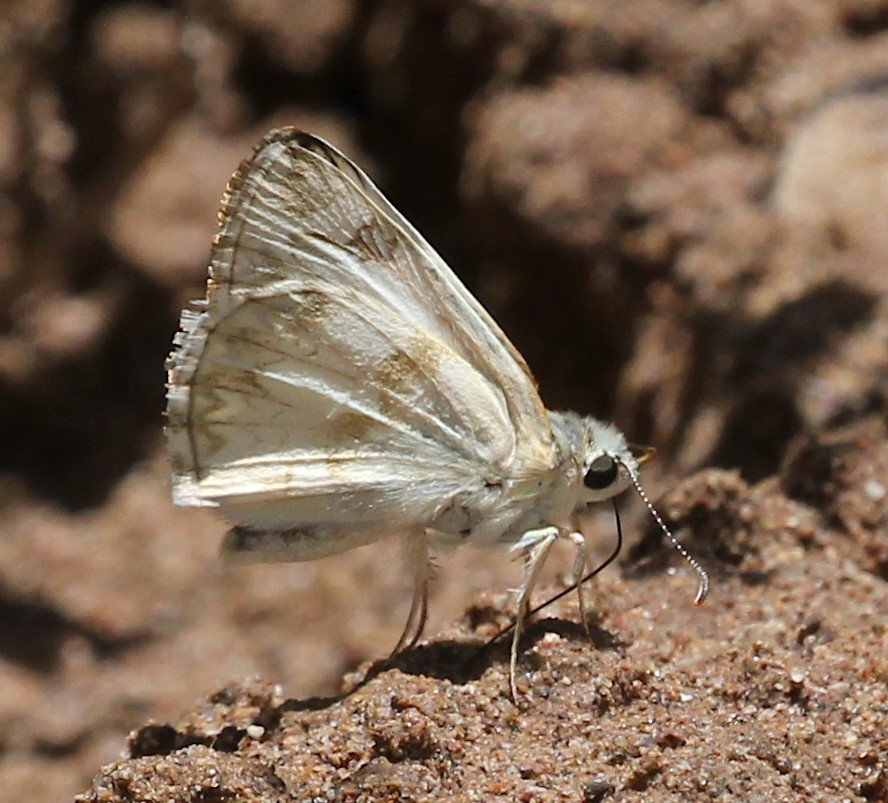
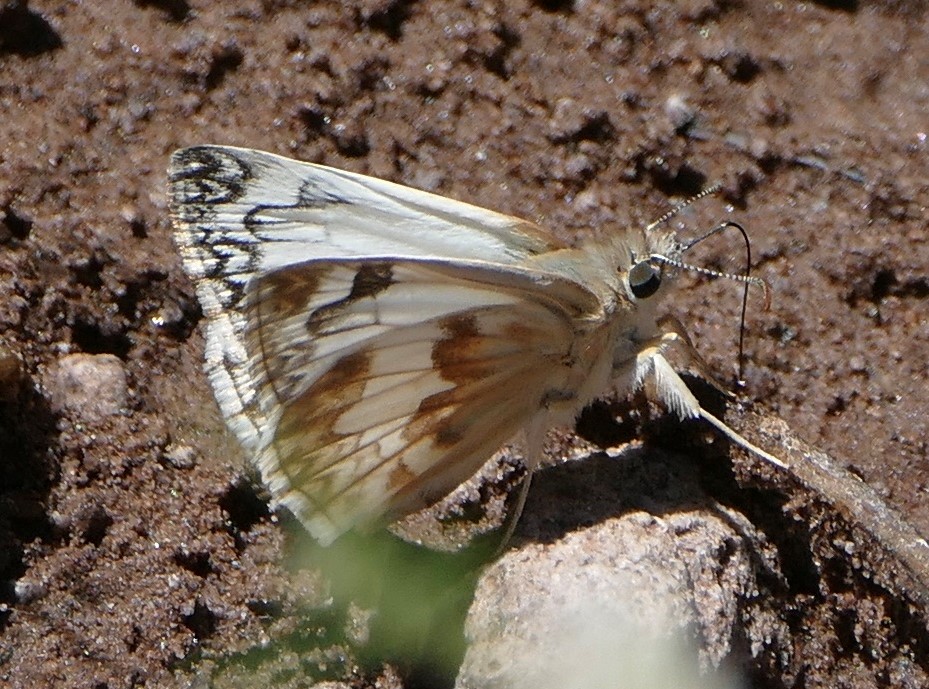
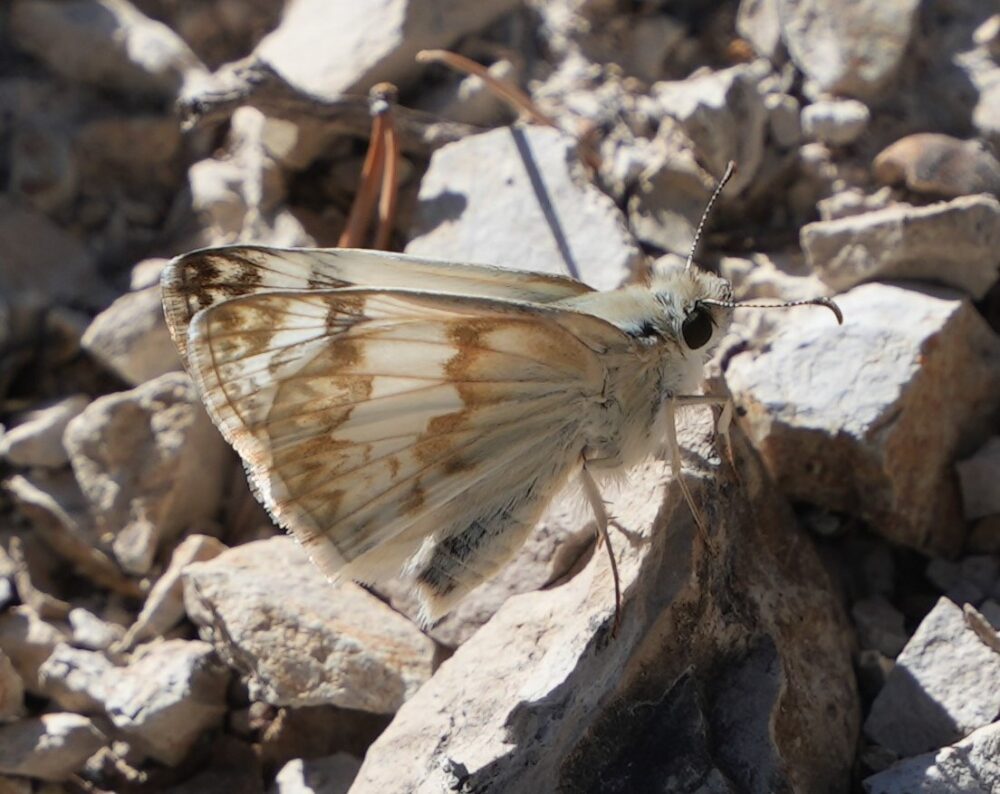
Northern White-Skipper (Heliopetes ericetorum) near Maverick Hill, Greenlee Co., AZ; May 22, 2023 (photo by Marta Reece)
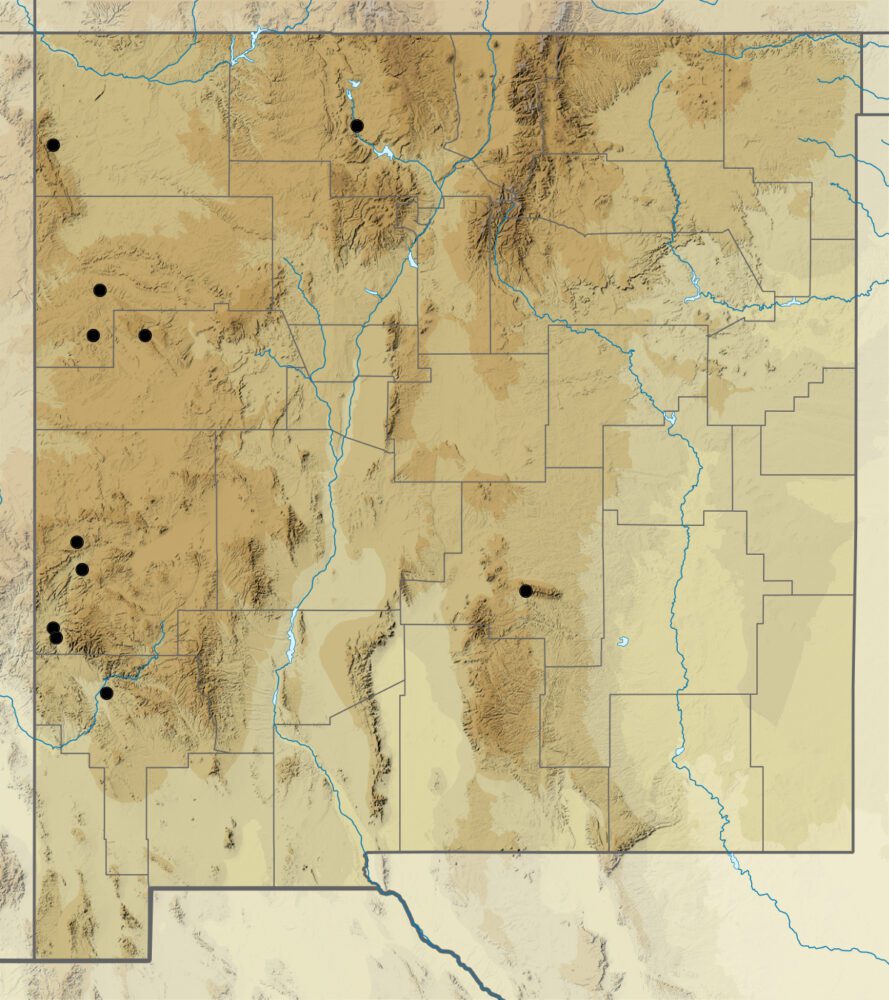
Heliopetes laviana (Hewitson 1868) Laviana White-skipper (added September 7, 2022)
Description. Laviana males and females are both white above with dark FW apices. There are partial dark borders on the FW and HW, more prominent on the female. These borders are less extensive on this species than on the Northern White-Skipper. A diagnostic trait which will separate this species from similar white-skippers (including the Turk’s Cap White-Skipper – Heliopetes macaira – not yet found in either AZ or NM) is the straight postmedian line on the VHW. Range and Habitat. This species has been found close to the NM border in SE AZ (the AZ side of the Peloncillo Mts.). Laviana White-Skipper is common in S TX and a regular part of the SE AZ fauna, so it seems reasonable to expect it soon in the Peloncillo or Animas Mtns. of NM. It ranges through Mexico south to Venezuela. Life History. Bailowitz and Brock (2022) noted that Anoda abutiloides (Malvaceae) is used as a larval food plant in AZ. Flight. There seem to be two broods in AZ. It flies year-around in S. TX. Comments. Not yet reported from NM, captures from the AZ side of the Peloncillo Mountains argue for its discovery here when that region is more fully explored. If any readers have live photos and are willing to share, we’d be happy to post them with our gratitude.


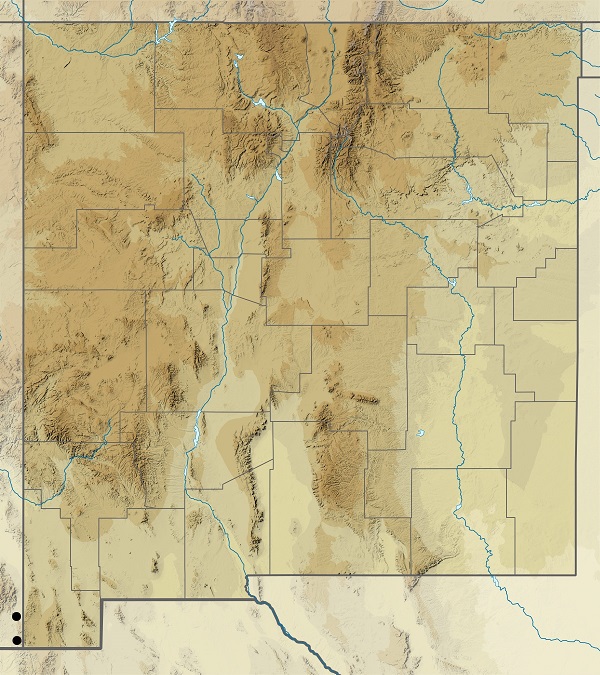
Chiothion georgina (Reakirt 1868) White-Patched Skipper (updated September 9, 2022)
Description. The ventral surface of this butterfly is white with variable amounts of brown spots. The dorsal surface is “patchy-looking” with splotches of brown, grey and white on the forewing. There are a few subapical white spots on the forewing as well. The hindwing has a prominent medial white patch. The fringes are largely uncheckered. Range and Habitat. White-Patched Skipper is a subtropical species that breeds from Argentina north to Mexico and south Texas. It may also breed seasonally in southern Arizona. It is prone to wandering, which accounts for the sole New Mexico report. Adults prefer moist canyons and perch at mud puddles, often with the front wing tips bent downward. Life history. Reported larval hosts are Malpighiaceae (Scott 1986), including Malpighia glabra, an ornamental plant cultivated in south Texas for its fruits, which are made into jellies (Kendall and Rickard 1976). Flight. The late summer rainy season is the most likely time to encounter this unusual species. Comments. Our one record is from Guadalupe Canyon (county: Hi) on 10 October 1989 by Kilian Roever. This butterfly has been mistaken for Chiomara asychis (Stoll), a South American species with which its relationship is under study (see Opler and Warren 2002).
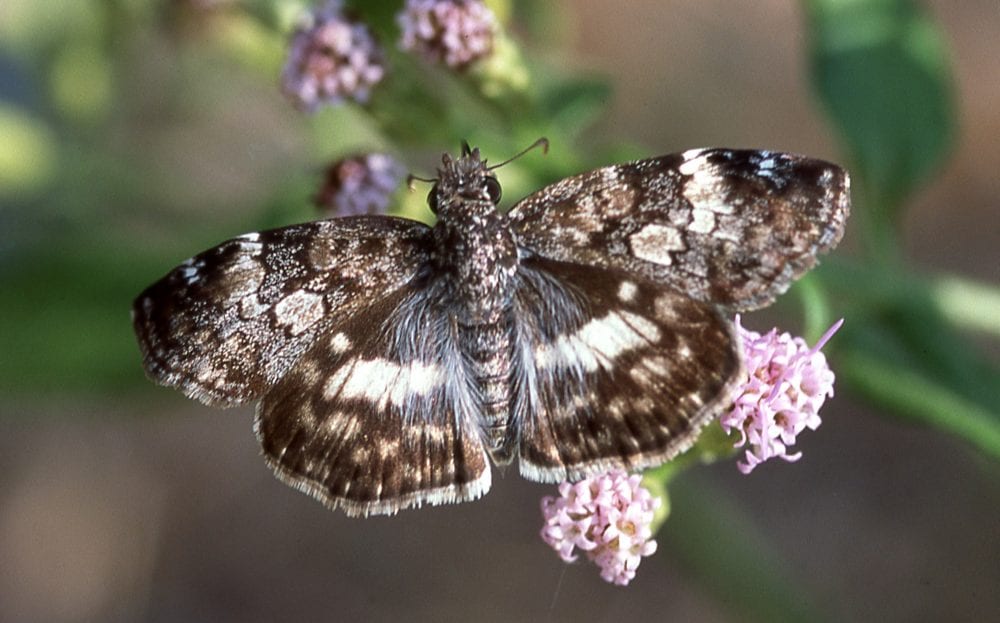
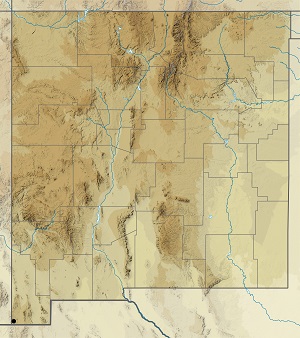
Timochares fuscifasciata (Plötz 1884) Brown-Banded Skipper (updated September 20, 2022)
Description. Like many Erynnis and Gesta species, the upper side of Brown-Banded Skipper is tan with bands of brown spots paralleling the wing margins. The ground color is paler than in most Erynnis and Gesta. The dorsal hind wing has three rows of brown spots. Brown-Banded Skippers lack the apical white spots on the forewings typical of many Gesta species. The underside is orange-brown with the dorsal pattern repeated in a paler fashion. Range and habitat. This subtropical Mexican skipper apparently breeds in south Texas, where its larval host is an ornamental plant often seen in urban areas, but it is only a rare stray in southern New Mexico (counties: DA,Gr). Life history. The reported larval host in Texas is Malpighia glabra (Malpighiaceae) (Kendall and Rickard 1976). Flight. Most of our infrequent subtropical strays are encountered during or shortly after the summer monsoon season. In this case, our only two records are from 20 September 1963, caught by Dale Zimmerman at Little Walnut Creek, north of Silver City, and 20 October 2021 (see photo below) from the Organ Mountains in Doña Ana County. Comments. The Hermit Skipper (Grais stigmaticus) is somewhat similar but is larger and paler and often has subapical white spots on the forewing. Formerly Timochares ruptifasciatus (see Zhang et al., Nov. 2024) for a detailed explanation of this change
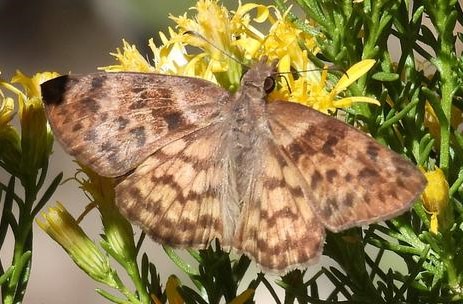
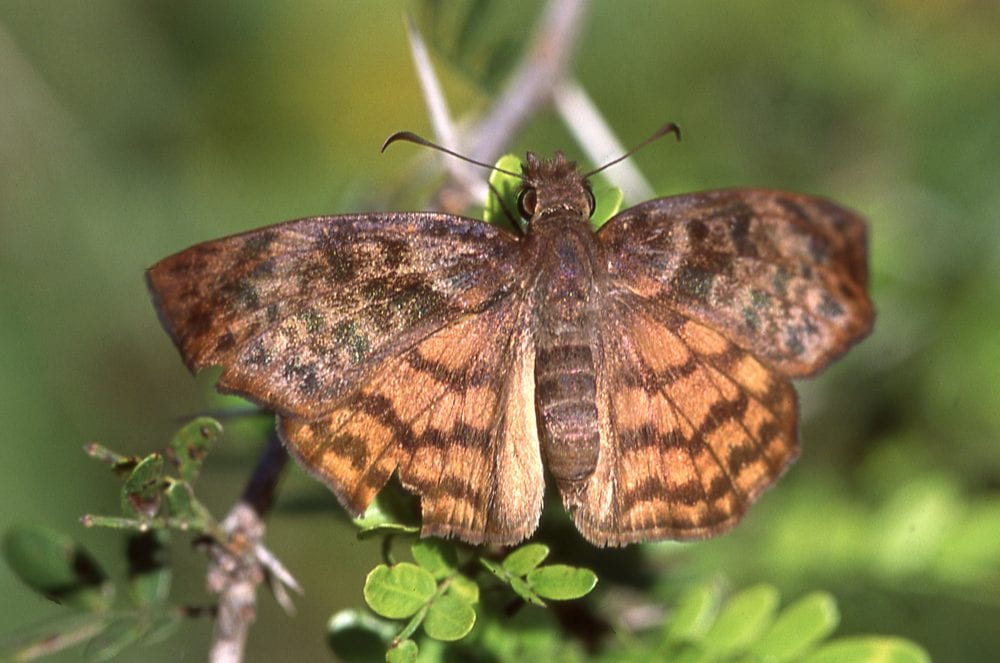
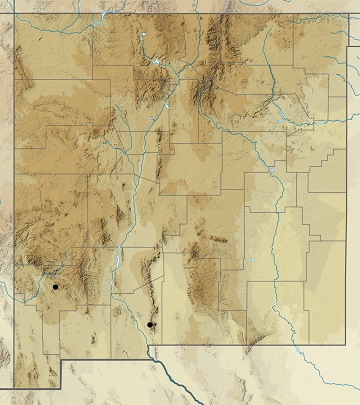
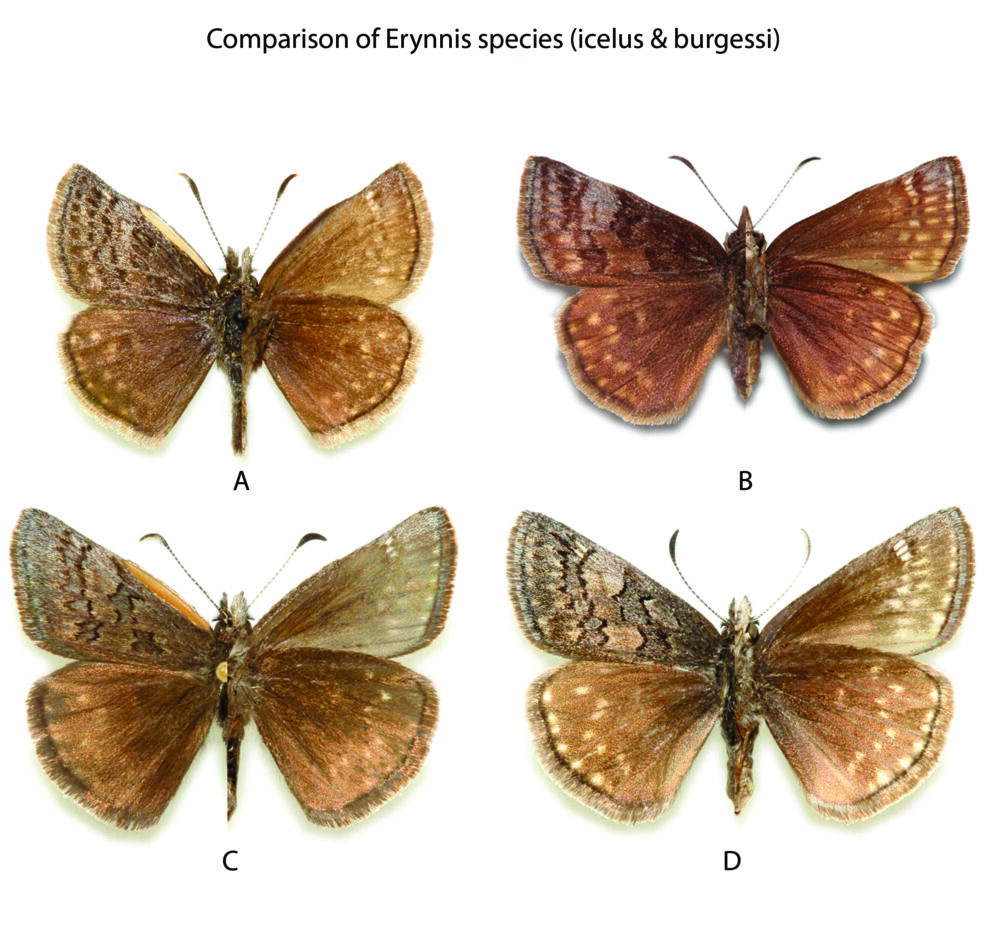
Erynnis icelus (Scudder & Burgess 1870) Dreamy Duskywing (updated September 22, 2022)
Description. Dreamy and Burgess’ duskywings are very similar. The dorsal forewing of each has a chain-like postmedian row of gray spots, while lacking the translucent, hyaline white spots typical of members of the genus Gesta. How do they differ? Erynnis icelus is smaller and has a broad wash of silver scales beyond the postmedian spot row on the dorsal forewing. The head has two prominent palps. Males have a costal fold. Each abdominal segment is encircled by a gray ring. It also has a restricted range, exhibits different behaviors and lives in different habitats. Range and Habitat. Dreamy lives across Canada and south, reaching southern limits in the mountains of Arizona and New Mexico (counties: Be,Ca,Ci,Co,Gr,Li,LA,Mo,Ot,RA,Sv,SJ,SM,SF,Si,Ta,To,Un). Here it likes Transition and Canadian Zone openings near aspen, 7000 to 10,000′ elevation. Life History. Scott (1992) witnessed oviposition on a seedling of quaking aspen (Populus tremuloides; Salicaceae) at Hopewell Lake (RA). That is the only known larval host here. Flight. Adults come readily to flowers and moist earth. They perch in forest openings looking for mates; males do not hilltop. Records span April 10 to July 25. Univoltine, adults peak in May in the Sacramentos, but in June farther north. Comments. If aspen is a significant part of your vegetation community, then you are in Dreamy Duskywing country.
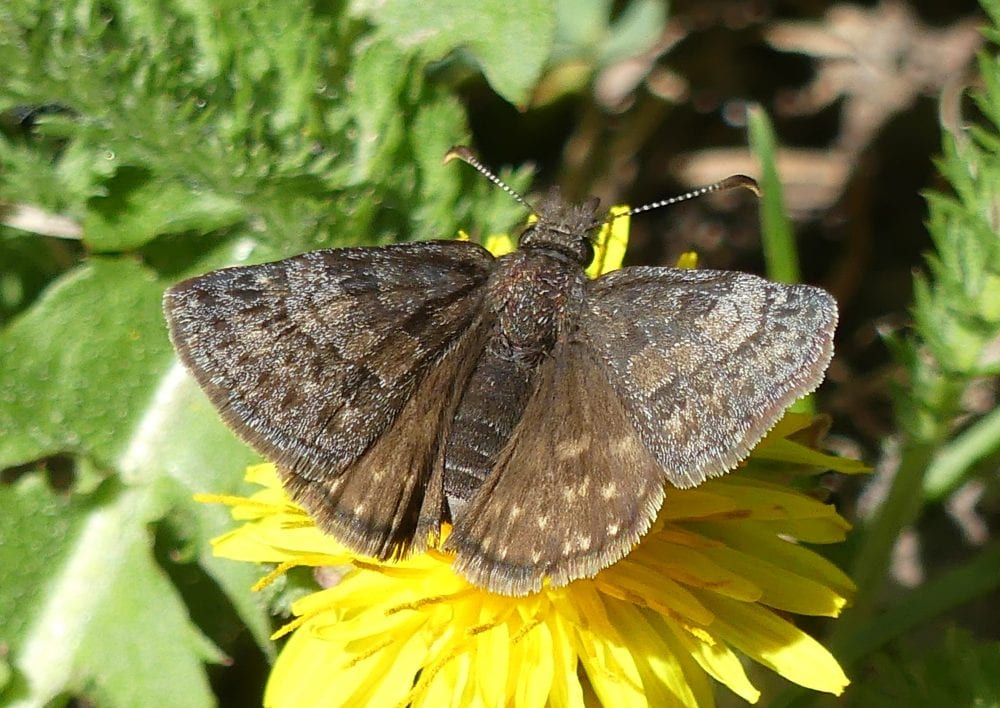
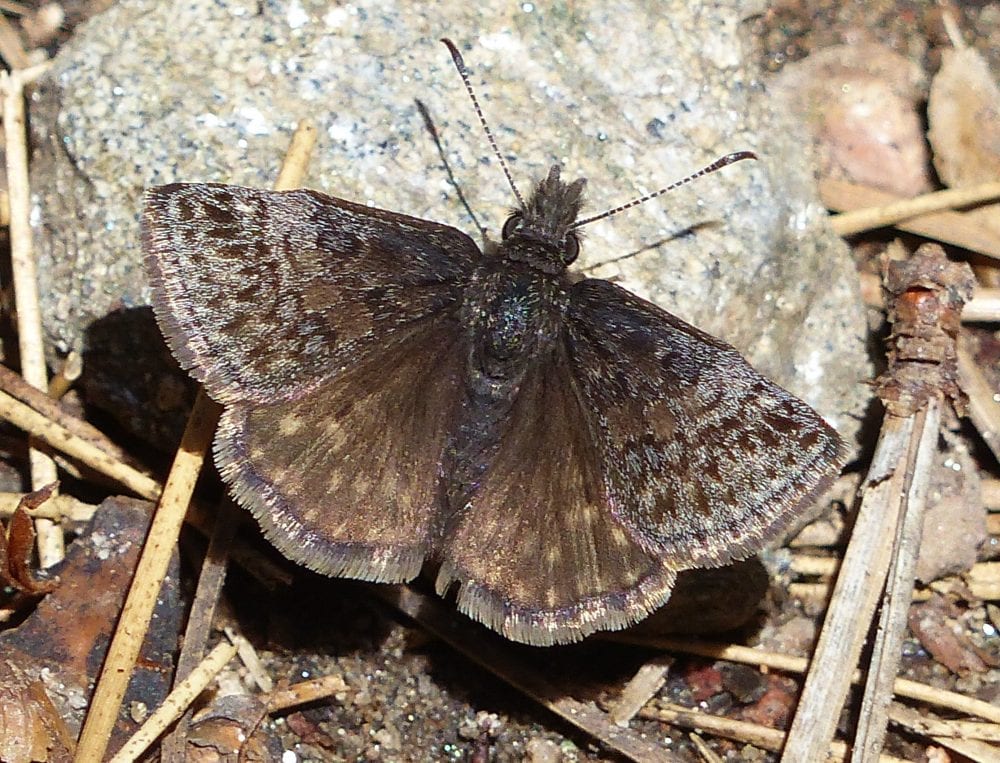
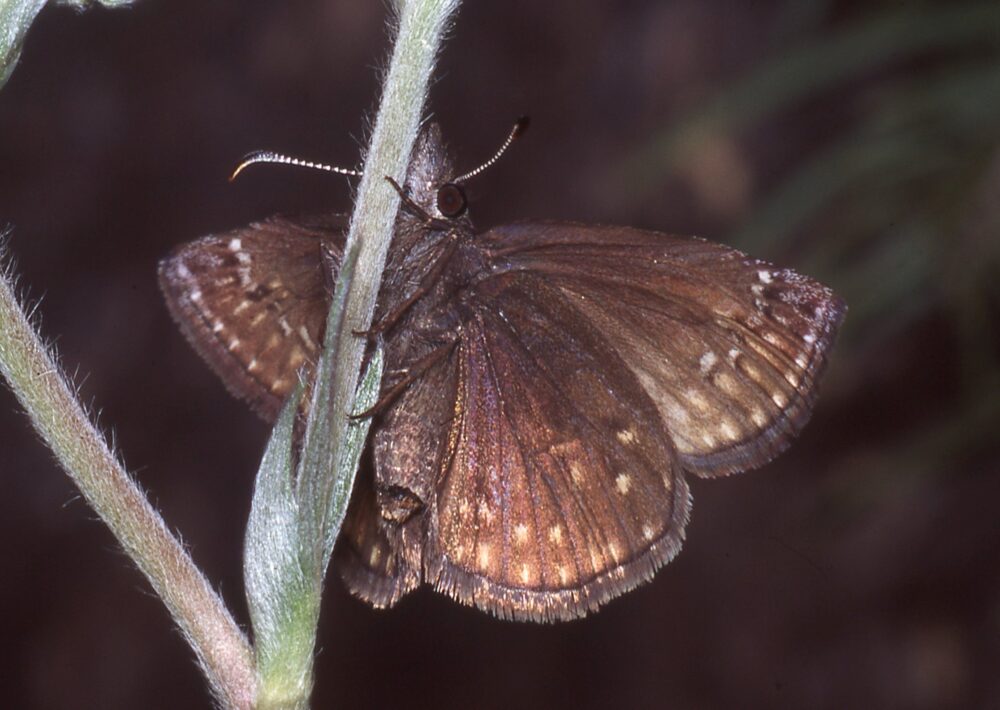
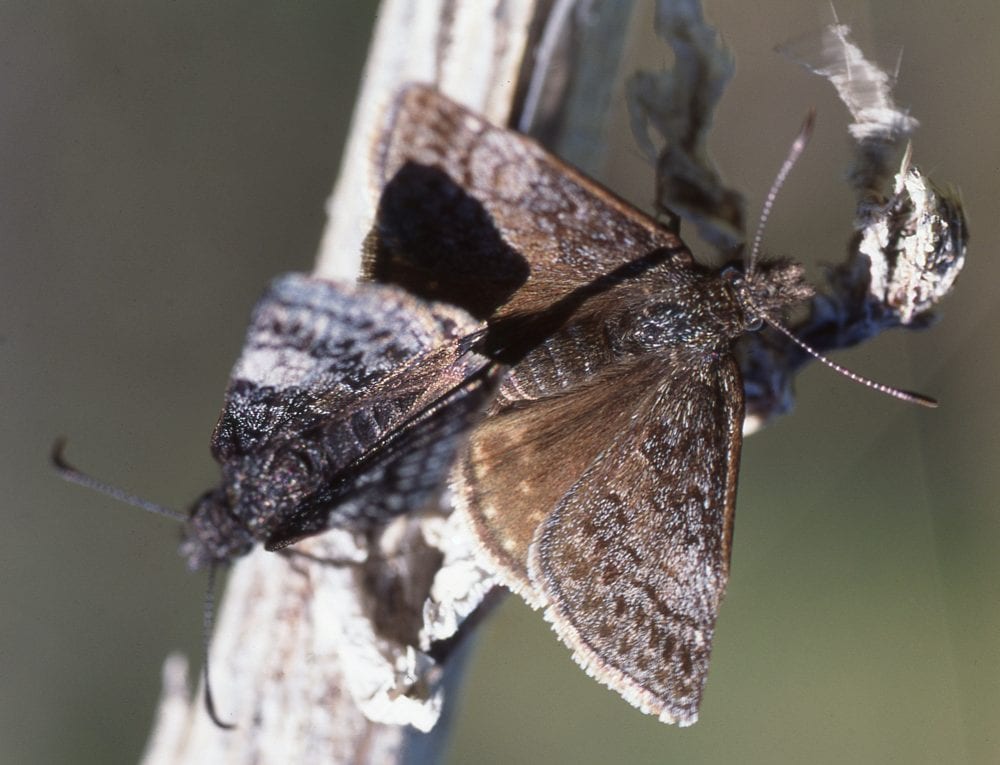
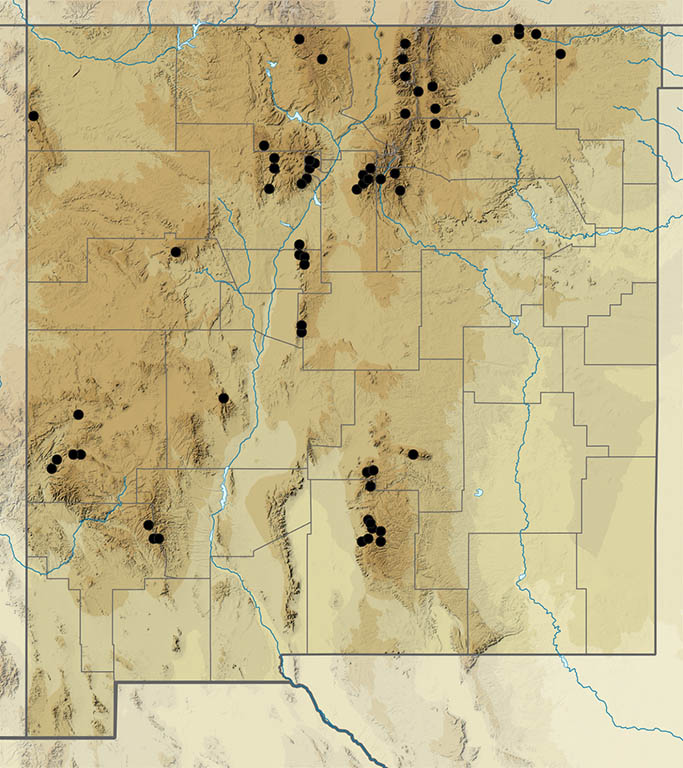
Erynnis burgessi (Skinner 1914) Burgess’ Duskywing (updated September 22, 2022)
Description. Burgess’ (formerly Sleepy) Duskywing closely resembles Dreamy, as discussed above, in having median and postmedian chains of gray spots on the dorsal forewing, but it lacks Dreamy Duskywing’s broad silver wash of scales and prominent palps. It also is larger, lives in different habitats and exhibits different mate-location behaviors. Range and Habitat. Erynnis burgessi lives in Upper Sonoran to Transition Zones throughout non-boreal Mexico and North America (all New Mexico counties). Its altitude range is 5200 to 7800′, but it will fly to higher hilltops. This butterfly flies among the shinnery oak of the Mescalero Sands of southeast New Mexico. Life History. Larvae eat oaks (Fagaceae) including Quercus arizonica, Quercus undulata, Quercus havardii, Quercus gambelii and Quercus emoryi. Mature larvae overwinter. Flight. Burgess’ Duskywings are univoltine with adults on the wing in spring, March 4 to July 23. Flight peaks occur in April in the south, in May on our northeast plains, and in June in the mountains. Males are eager hilltoppers, unlike Erynnis icelus. Adults visit moist earth and nectar at spring flowers such as Nolina, Ungnadia, Oxytropis and Rhus. Comments. Burns (2020) separated Burgess’ from Sleepy Duskywing (E. brizo (Boisduval & Le Conte [1837])). Some July records, suspicious because of the late date, may refer to the similar Erynnis icelus. This butterfly is known to fly among the shinnery oak of the Mescalero Sands of southeast New Mexico in addition to its other occurrences.
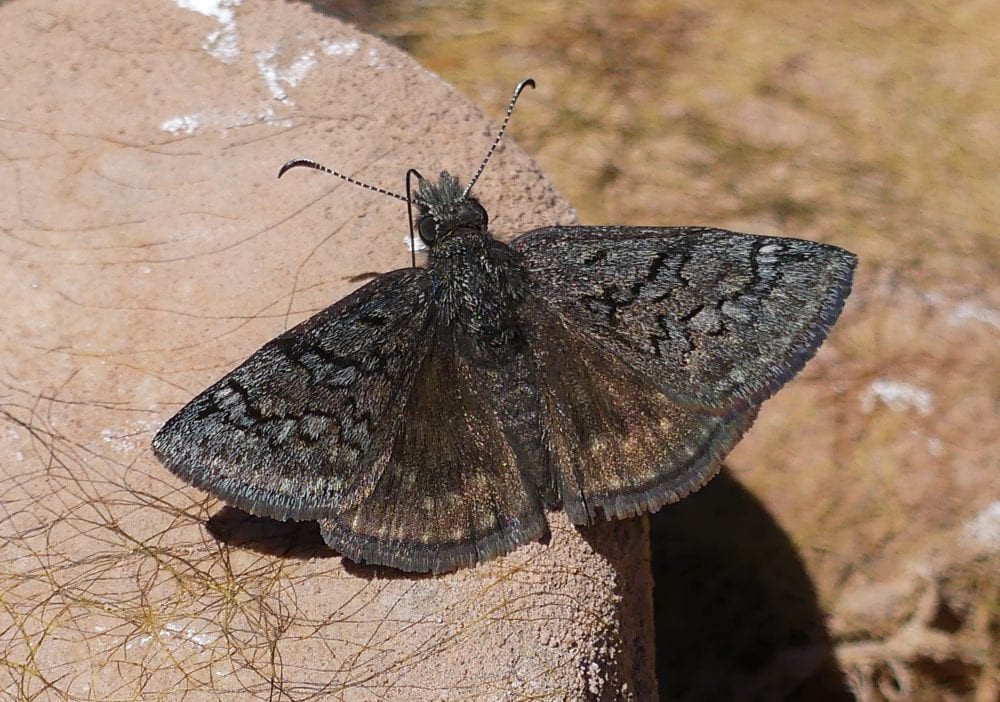
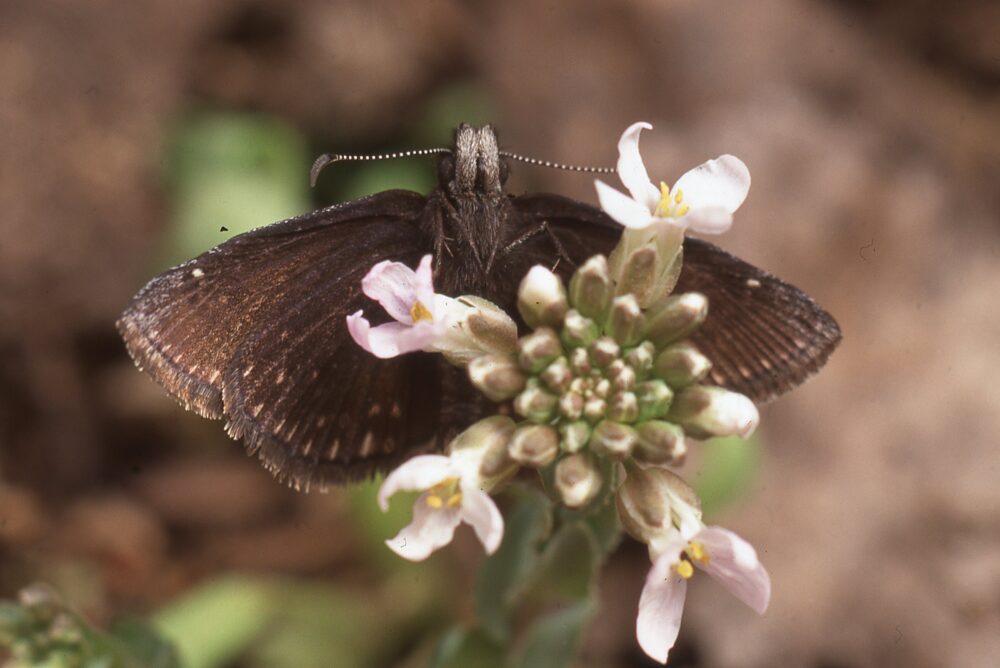
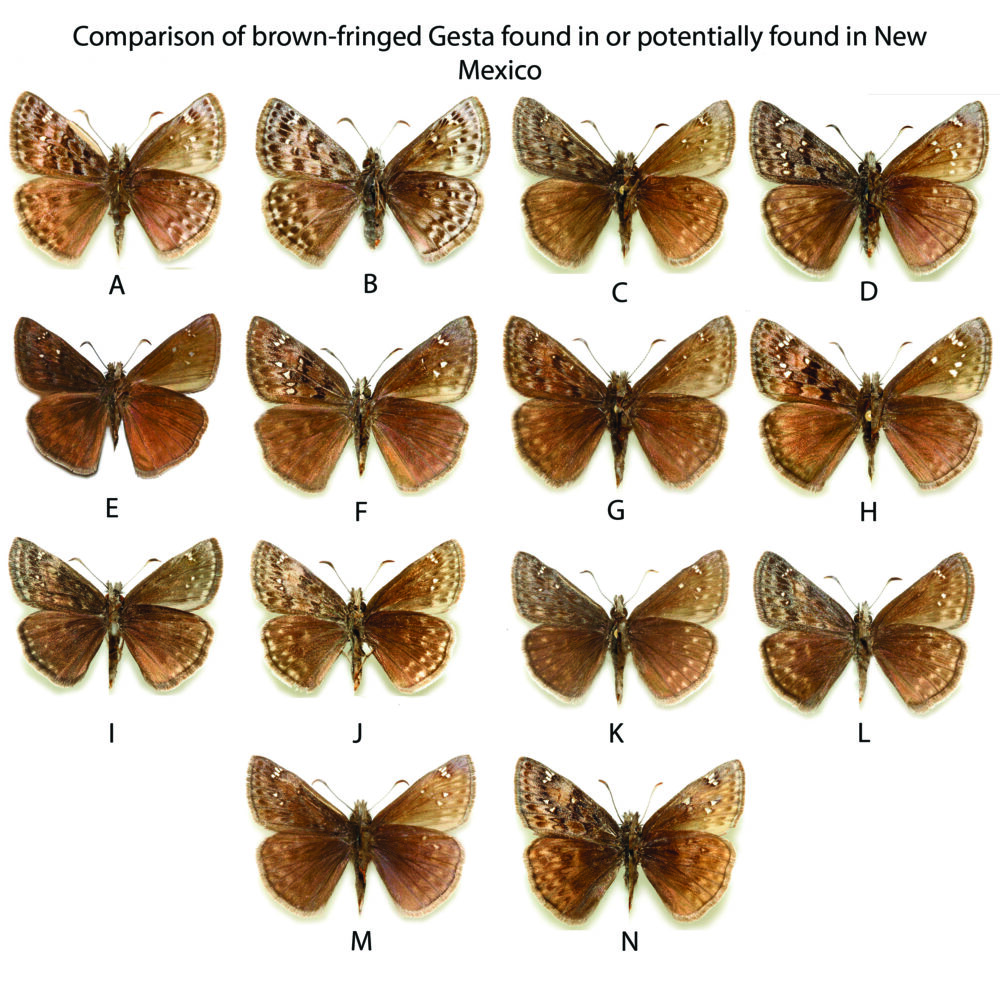
Identification of Duskywings is difficult, complicated by sexual dimorphism and seasonal variation. In general, habitat and behavior are useful tools coupled with morphology, but observers often will have to be satisfied with identifying a photo as “Duskywing.” That said, the Mottled Duskywing is fairly distinctive (currently known only from the Raton Mesa complex in NM). Rocky Mountain Duskywing is told from all other brown-fringed Duskywings by the two apical and costal spots on the VHW, except for the brown-fringed form of Juvenal’s Duskywing (not yet known from NM). Afranius and Persius Duskywings are smaller than all the others, but very difficult to distinguish from each other. For collected specimens, genitalic dissection will distinguish one species from another. Refer to the species descriptions for more help.
Gesta martialis (Scudder 1869) Mottled Duskywing (updated September 23, 2022)
Description. Mottled Duskywings have a mottled, contrasty dorsal forewing, rather like that of Rocky Mountain Duskywing or Afranius Duskywing. It stands out from these look-alikes with ventral hindwing submarginal spots that are much more elaborate and showy (for a duskywing). Range and Habitat. Gesta martialis is widespread in eastern North American woodlands and in the eastern tallgrass Great Plains. Disjunct western colonies occur along the Rocky Mountain Front Range foothills from South Dakota as far south as northeast New Mexico, where they occupy Transition Zone savanna habitats. Life History. Although little is known about this butterfly in New Mexico, Ceanothus fendleri (Rhamnaceae) is the larval host in Colorado (Ferris and Brown 1981) and probably in New Mexico, too. Flight. Rocky Mountain Gesta martialis is univoltine flying in June. Our one confirmed population flies at 7500 to 8400′ elevation on the Raton Mesa volcanic complex (county: Co) from May 12 to July 12; one October 4 specimen suggests a second brood. Males hilltop; females associate with the larval host. Comments. The 1996 discovery of Gesta martialis in Colfax County does not legitimize a dubious report from the Sandia Mountains 50 years earlier (see Cary and Holland 1992[1994]). Formerly Erynnis martialis.
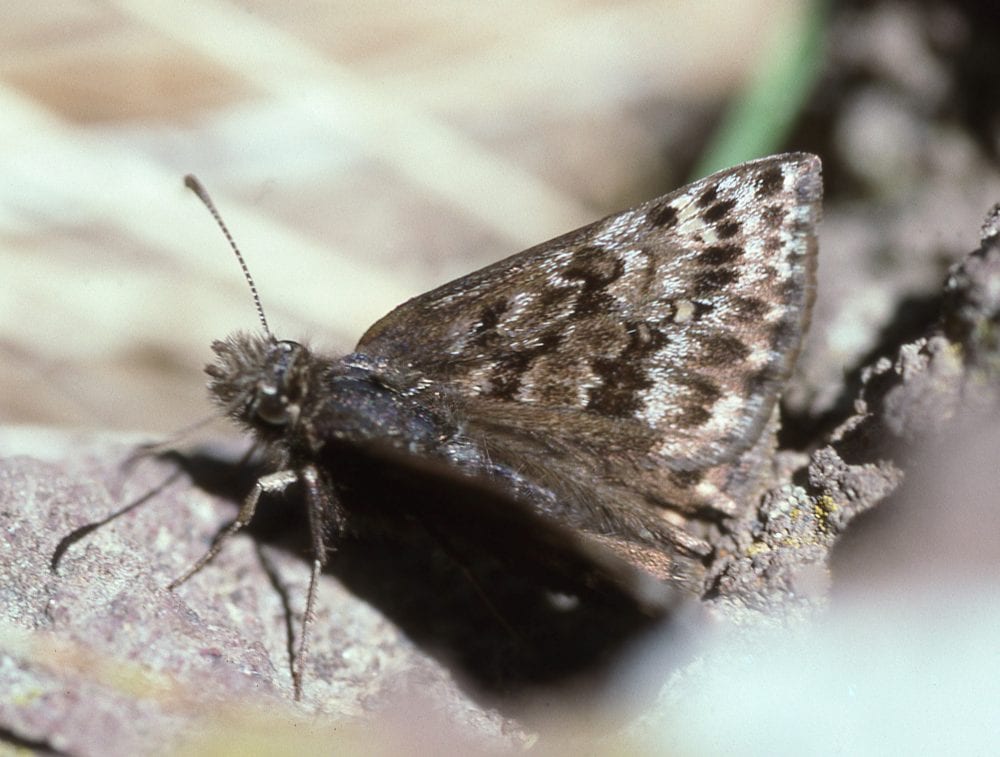
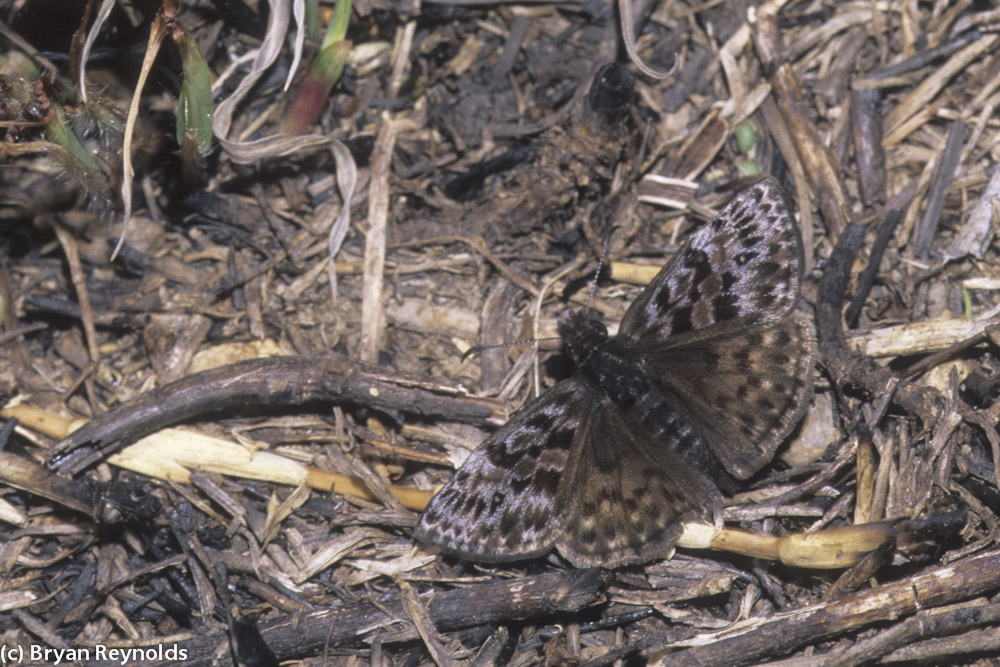
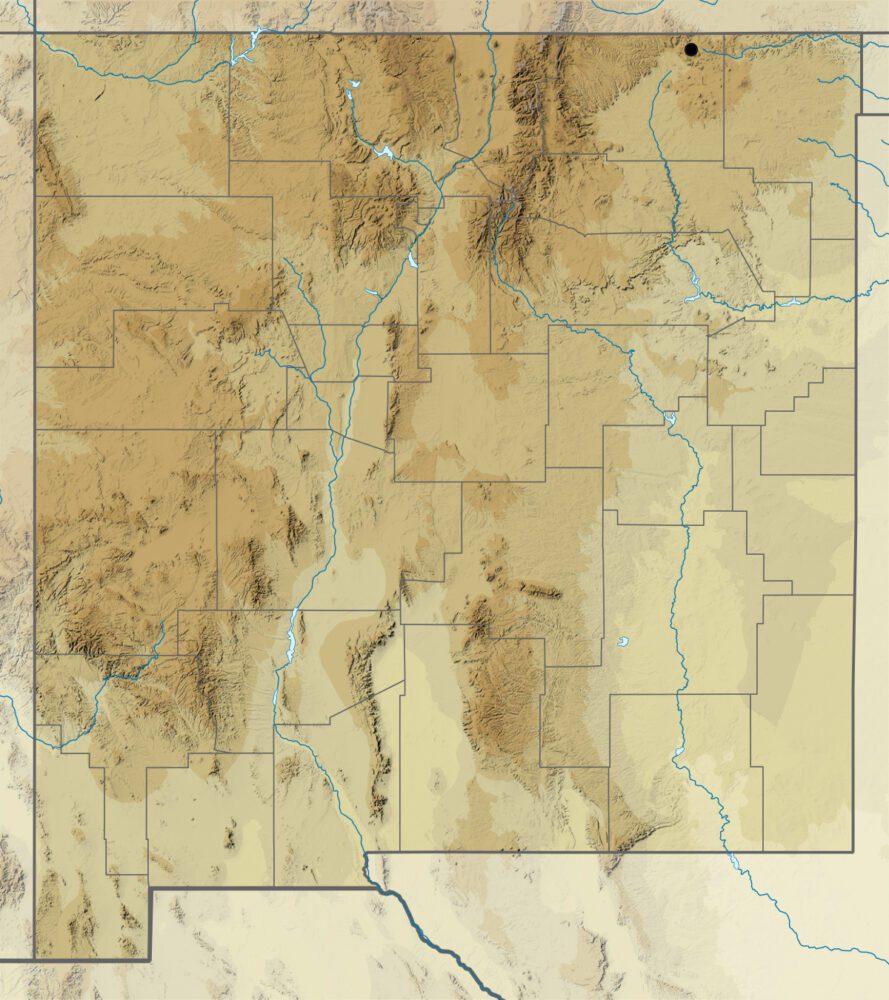
Gesta pacuvius (Lintner 1878) Pacuvius Duskywing (updated October 19, 2022)
Description. Pacuvius has a distinctive dorsal forewing showing contrasty light brown and dark gray patches, like Mottled Duskywing or spring generation Horace’s Duskywing, with which it may fly. The white-fringed hindwing sets it apart from these congeners, but it creates confusion with Juvenal’s and Scudder’s duskywings in southwest New Mexico. Range and Habitat. Gesta pacuvius lives in the Rocky Mountains and Pacific ranges from British Columbia south into Mexico and Baja California. In New Mexico it inhabits Transition and Canadian Zone open woodlands in most major uplands (counties: Be,Ca,Ci,Co,Gr,Hi,Li,LA,MK,Mo,Ot,RA,Sv,SJ,SM,SF,Si,So,Ta,To), 7000 to 9200’ elevation. Life History. Fendler’s Buckbrush (Ceanothus fendleri; Rhamnaceae) is the larval host in New Mexico, Arizona and Colorado. This plant is a fire climax plant. It thrives in frequent-fire landscapes because its seeds, which accumulate in soils beneath the plant, can germinate only after fire melts the paraffin coating, allowing water to penetrate. Flight. Pacuvius is uni- to bivoltine here. In southwest New Mexico the two generations are strong and distinct, with peaks in March 29 and August. Our north-central mountains have peak flight in June to July. The two broods overlap in intervening areas. Overall, New Mexico records fall between April 1 and September 5. Males hilltop, but both sexes will come to nectar, scat and moist soil. Comments. Pacuvius was described in 1876 from material collected at some unspecified New Mexico location by the Wheeler Expedition. Our populations therefore belong to the nominate subspecies.
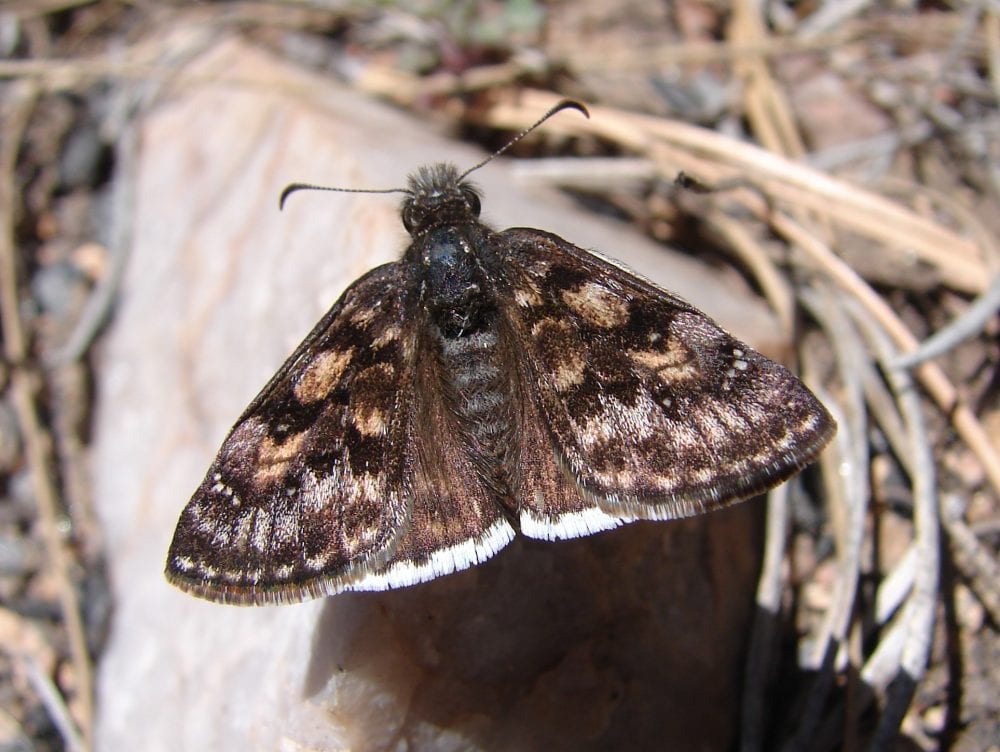
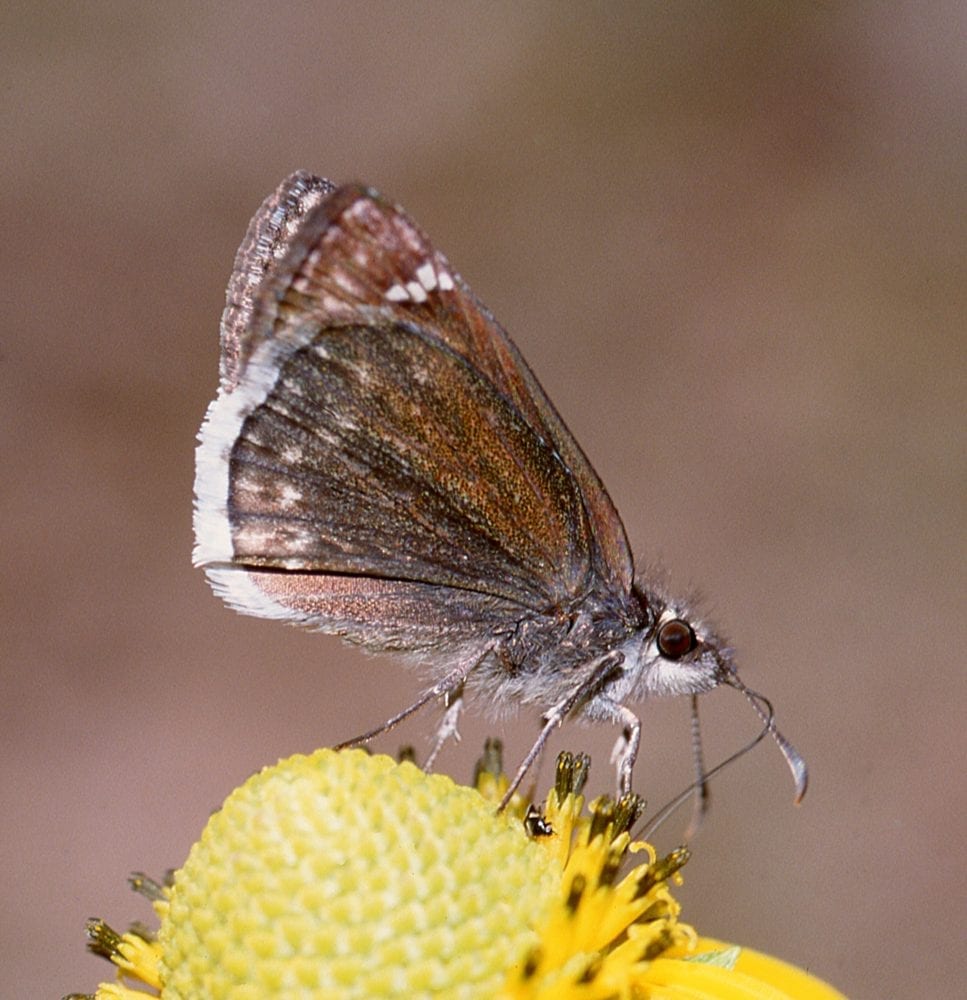
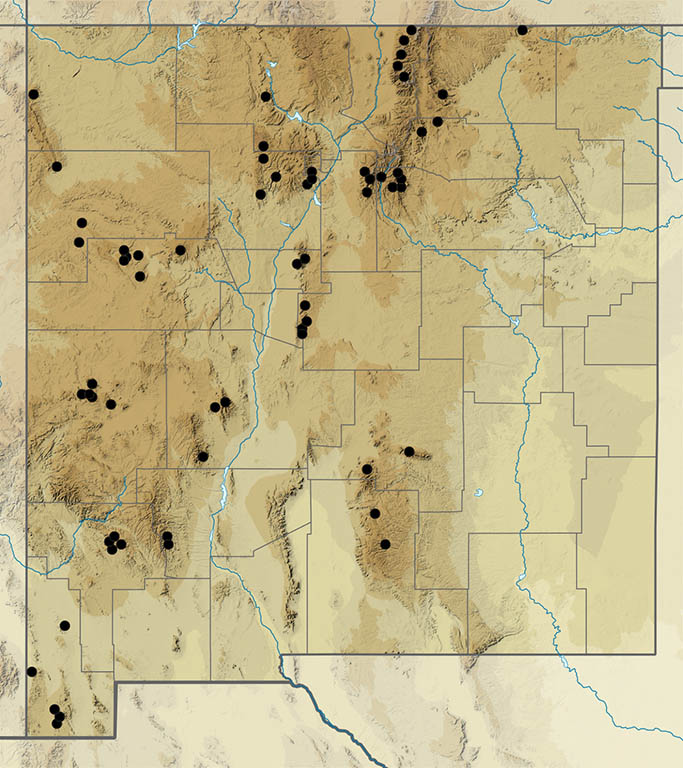
Gesta juvenalis (Fabricius 1793) Juvenal’s Duskywing (updated October 20, 2022)
Description. Gesta juvenalis is hard to differentiate from the crowd of southwestern duskywings with white hindwing fringes. The forewing above has a row of pale postmedian spots against a dark submargin. It is less contrasty above and larger than Gesta pacuvius, and larger than Gesta scudderi. The forewing is less elongated than Gesta funeralis. The hindwing below lacks the white marginal patches of Gesta tristis tatius. Most of these differences are nuanced, making field determinations, even photo IDs, challenging. Genitalic determination is recommended in most cases, and that, of course, requires a specimen. Range and Habitat. Juvenal’s Duskywing is widespread in eastern North America. A disjunct Mexican population extends north along the Sierra Madre Occidental into southeast Arizona and southwest New Mexico (counties: Ca,DA?,Hi,Lu?), where it is an Upper Sonoran to Transition Zone resident, 4500 to 8000′ elevation. Life History. Larval hosts are oaks (Fagaceae). Quercus arizonica, Quercus emoryi and Quercus grisea are reported from southeast Arizona (Burns 1964) and are probably used in southwest New Mexico as well. Flight. We have two broods per year. Our records span March 18 to May 29 and July 14 to August 3. Males hilltop, but not strongly. Comments. The geographic race in our area is subspecies Gesta juvenalis clitus (W. H. Edwards 1883). The nominate eastern race lacks the white hindwing fringe. As suggested by the uncertainty regarding reports from Dona Ana and Luna counties, a paucity of observations from our southwestern quadrant hampers our ability to better understand this butterfly in New Mexico.
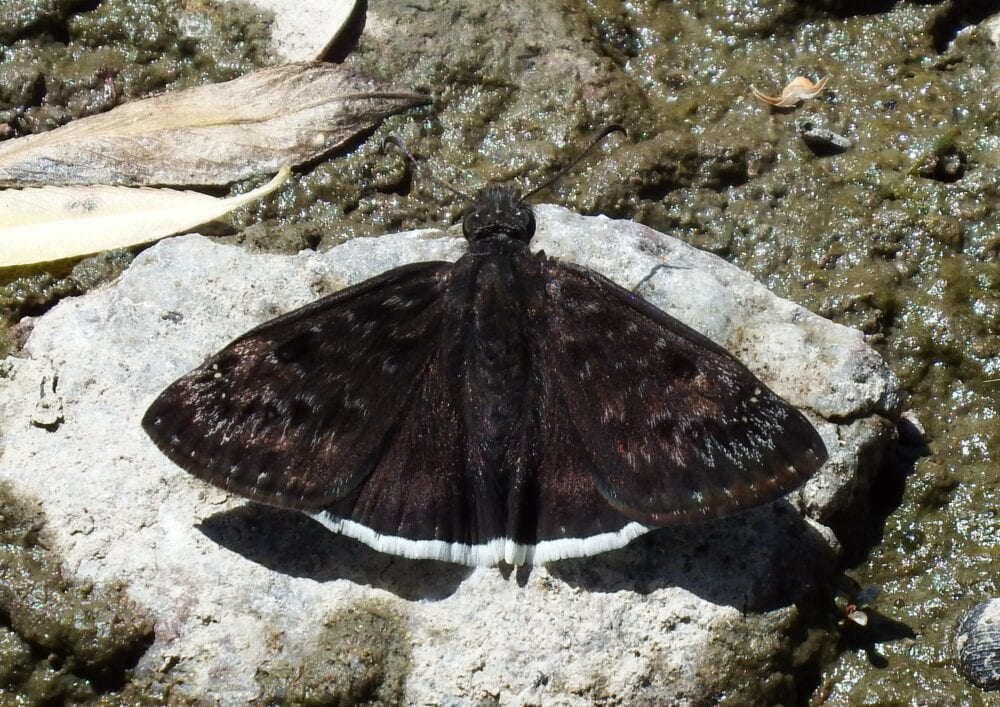
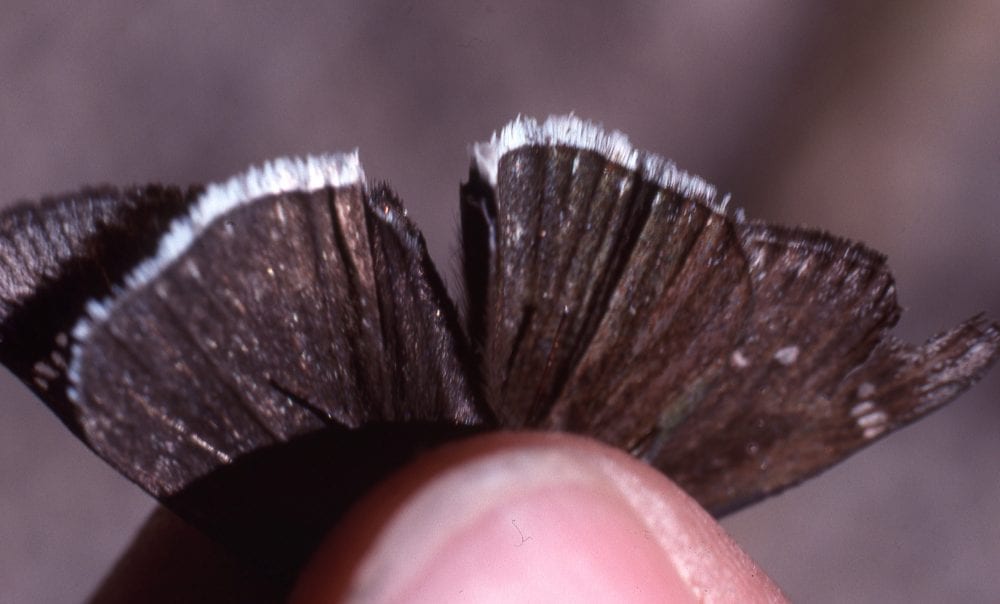
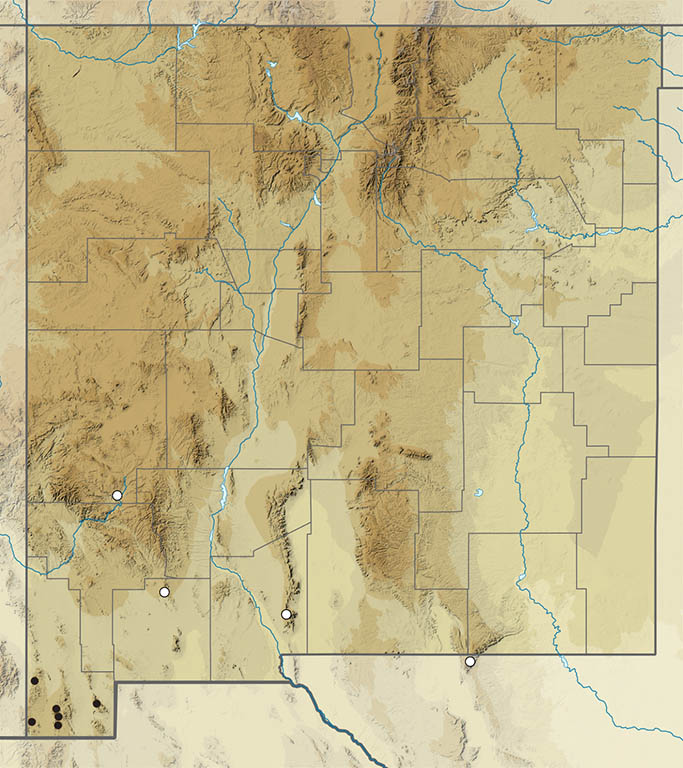
Gesta telemachus (Burns 1960) Rocky Mountain Duskywing (updated October 10, 2022)
Description. Rocky Mountain Duskywing is large with a gray dorsal forewing contrasting with the brown dorsal hindwing and brown wing fringes. Two other similarly two-toned species, Persius and Afranius, are smaller. The dorsal forewing has hyaline spots in the median area, but so do other duskywings. The 1 or 2 pale dots at the ventral hindwing apex is the best diagnostic character, shared only by Gesta juvenalis clitus, whose white fringe sets it apart. If Gesta juvenalis juvenalis is eventually found in SE NM, Duskywings from that area will be even more difficult to distinguish. Range and Habitat. This skipper lives in the central Rocky Mountain states of Utah, Colorado, Arizona and New Mexico (all counties but Cu,DB,Gu,Hi,Le,Qu,Ro). It inhabits Transition Zone oak openings with the host, 5000 to 9000′ elevation. Life History. Gambel’s Oak, (Quercus gambelii; Fagaceae), is the host for Rocky Mountain Duskywing. A female oviposited on expanding buds of an oak at Alps Mesa (Un) on 5 May 1996 (S. Cary). Eggs hatch quickly and larvae eat developing spring tissues. The strong representation of Gambel’s Oak in the flora of the Four Corners states causes its herbivore, Rocky Mountain Duskywing, to have an equally strong presence, for its size. Flight. Gesta telemachus is single-brooded and the timing of its flight helps to identify it. Adults fly in spring between March 22 and July 22; timing of the peak flight depends on altitude and latitude. Adults perch, patrol, bask and nectar in swales or drainages near stands of the larval host. Comments. This species languished in anonymity until Burns (1960) teased it out of the duskywing tangle. It had been observed and collected around the Rockies for decades, but for lack of a better option it had been reported as G. juvenalis, G. martialis or G. propertius.
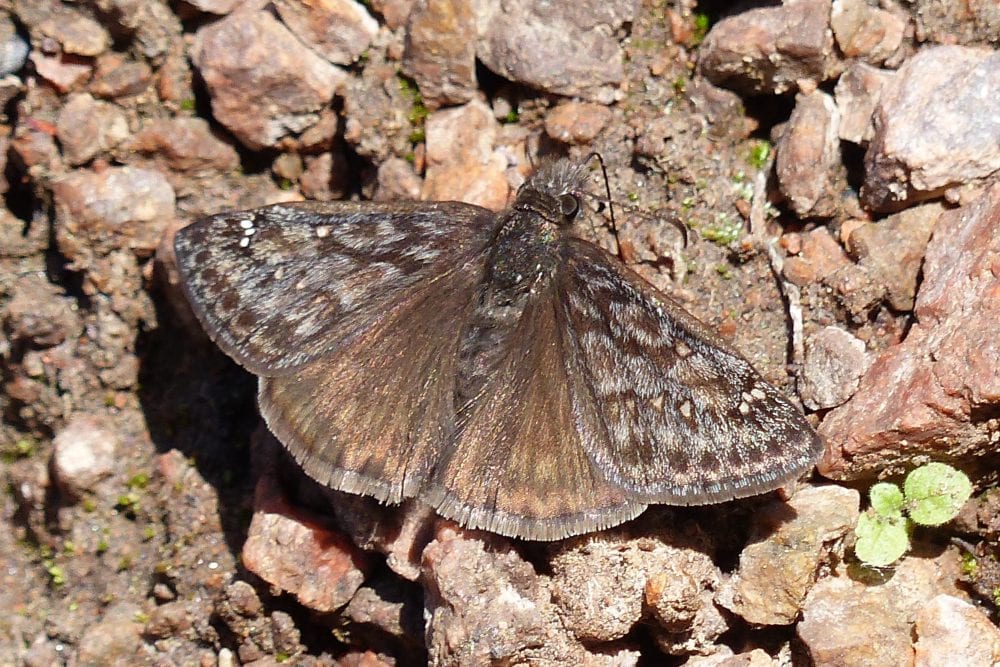
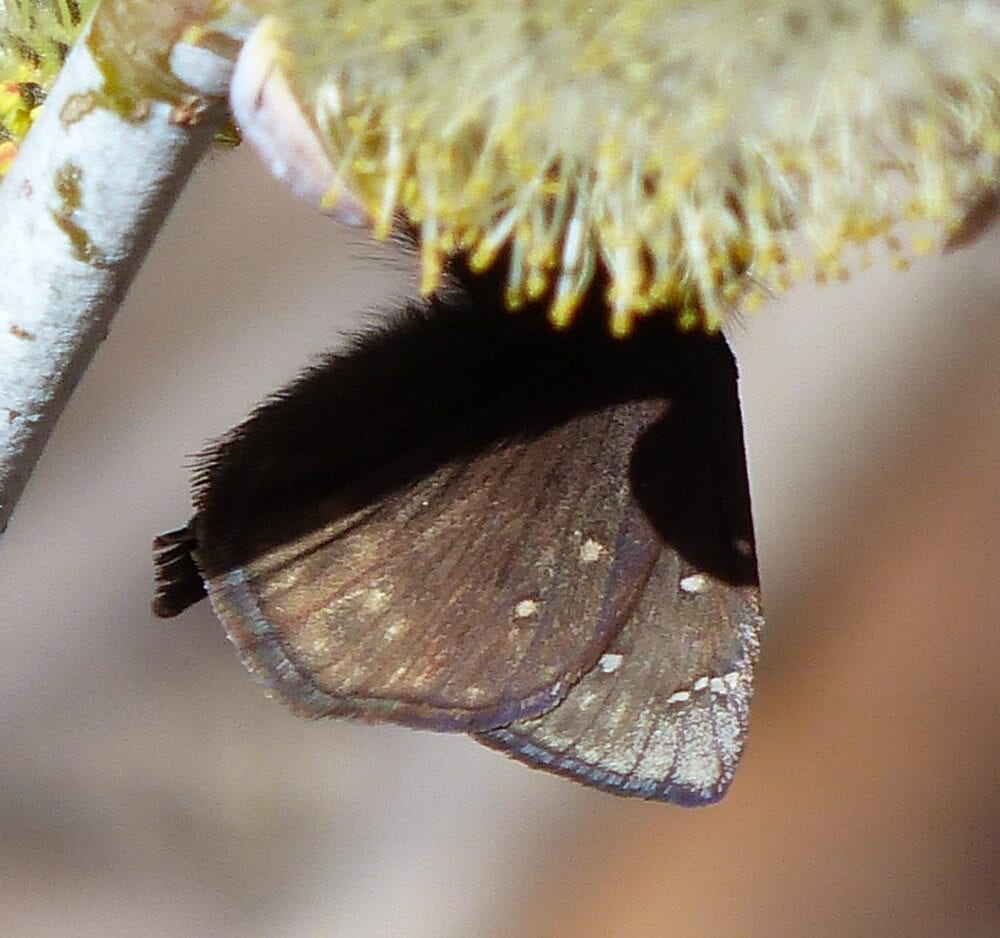
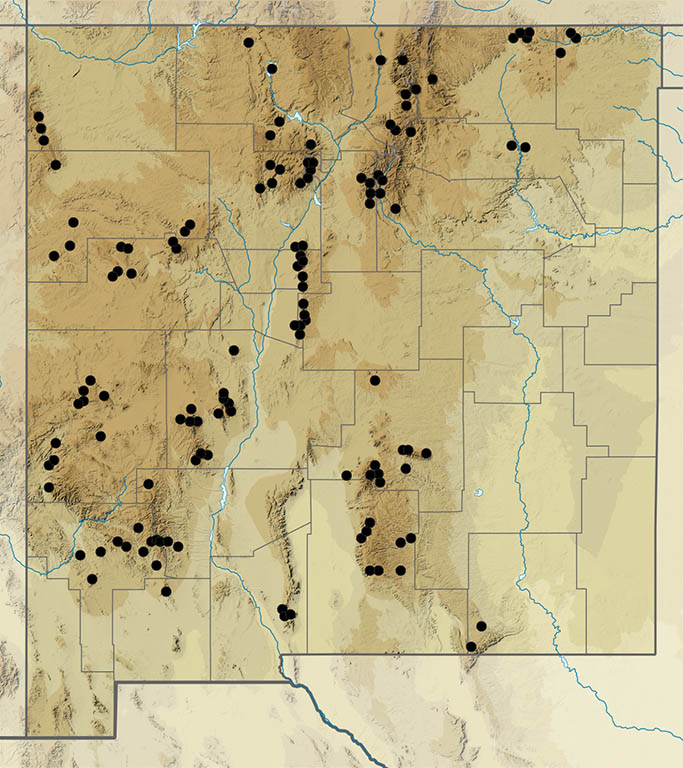
Gesta meridianus E. Bell 1927 Meridian Duskywing (updated October 20, 2022)
Description. The spring version of Meridian has a forewing upperside that is dark gray, sprinkled with tiny translucent postmedian white dots, and all quilted together with stitching of light blue scales, not unlike Rocky Mountain Duskywing. Hindwing upperside is vibrant chocolate with iridescent black dots and pale blotches. Hindwing underside lacks the two pale dots that typify Rocky Mountain Duskywing. Summer brood Meridian may be confused with the summer brood of Horace’s Duskywing, but it has less contrasting marks. Fortunately, their area of geographic overlap, or sympatry, is small. Above and below, the hindwing has iridescent dark submarginal dots on an iridescent light brown background. The hindwing fringe usually is dark with white tips. Spring brood individuals tend to be smaller and not as dark. Range and Habitat. Gesta meridianus lives in Nevada, Utah, Arizona, Texas and southern New Mexico (counties: Be,Ca,Ch,Co,DA,Ed,Gr,Gu,Ha,Hi,Li,Lu,Ot,Sv,Si,So,To,Un,Va) south to Mexico. It inhabits oak woodlands from 4500 to 7000′, hilltopping to 8500’ elevation. Life History. Larvae of Meridian Duskywings eat evergreen oaks (Fagaceae) such as Quercus arizonica and probably Quercus grisea and others. Flight. Males patrol desert hilltops, often quarreling with Mournful Duskywing males for the best spots. Both sexes come to nectar and water. New Mexico records of this bivoltine skipper are known from March 11 through September 30, with peak numbers in April and July-August, and sometimes a partial autumn flight. Comments. Rare dwarf individuals have turned up in extreme southern New Mexico (Ed,Hi). They are the size of Gesta persius and hilltop like that species, but they have Gesta meridianus genitalia (J.A. Scott and R.E. Stanford, pers. comm.). Meridian is called Southwestern Oak Duskywing in some field guides.
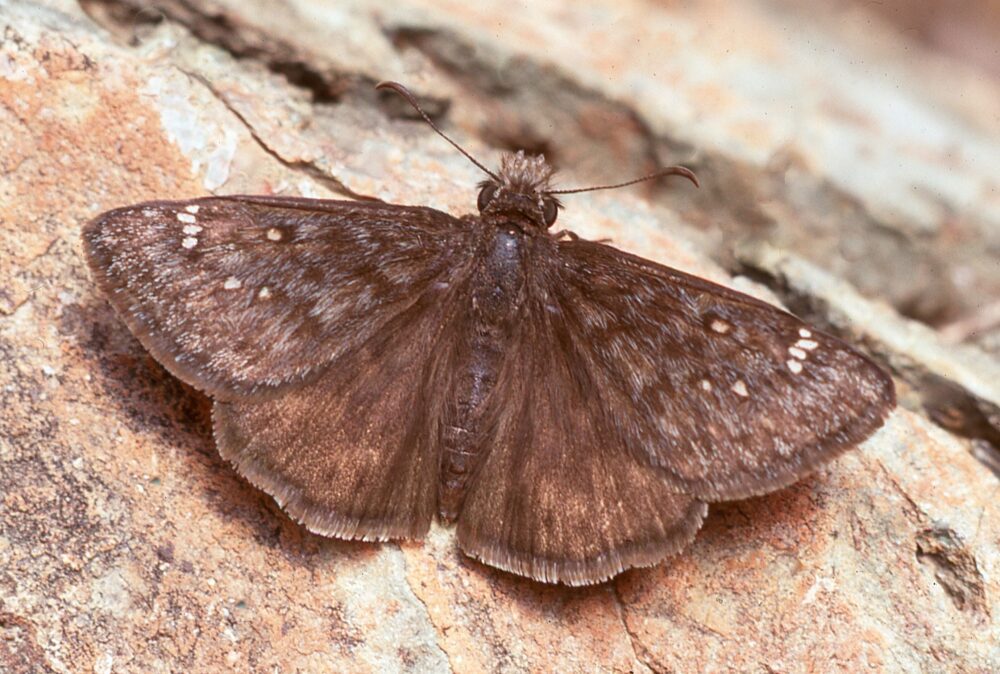
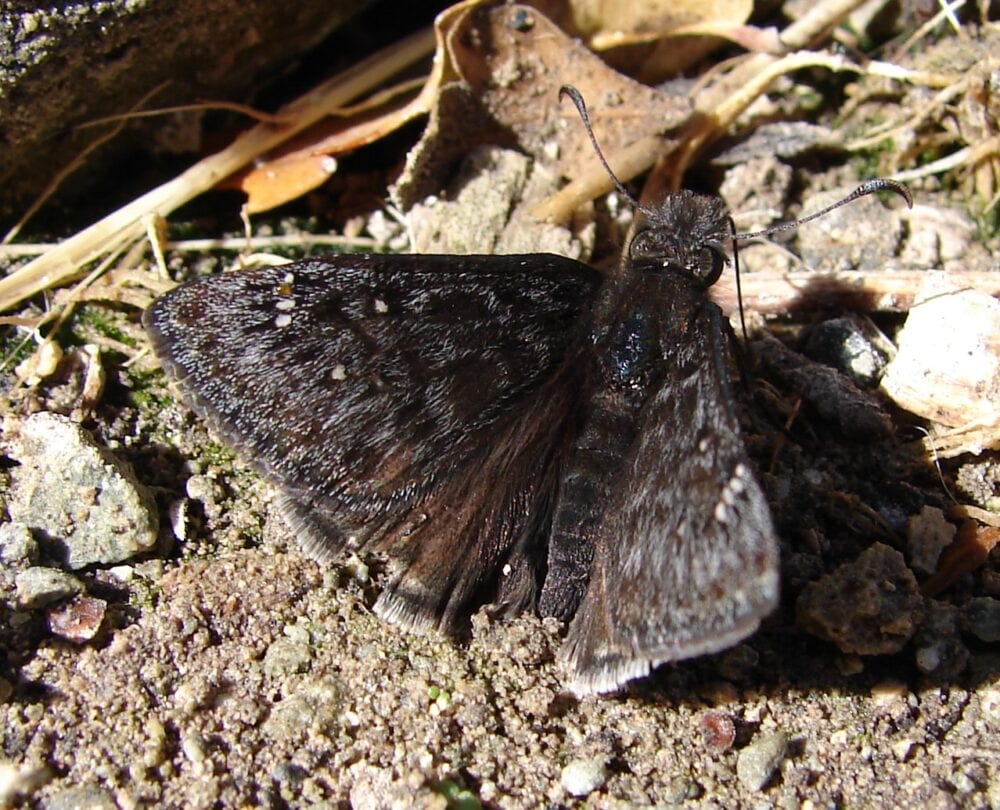
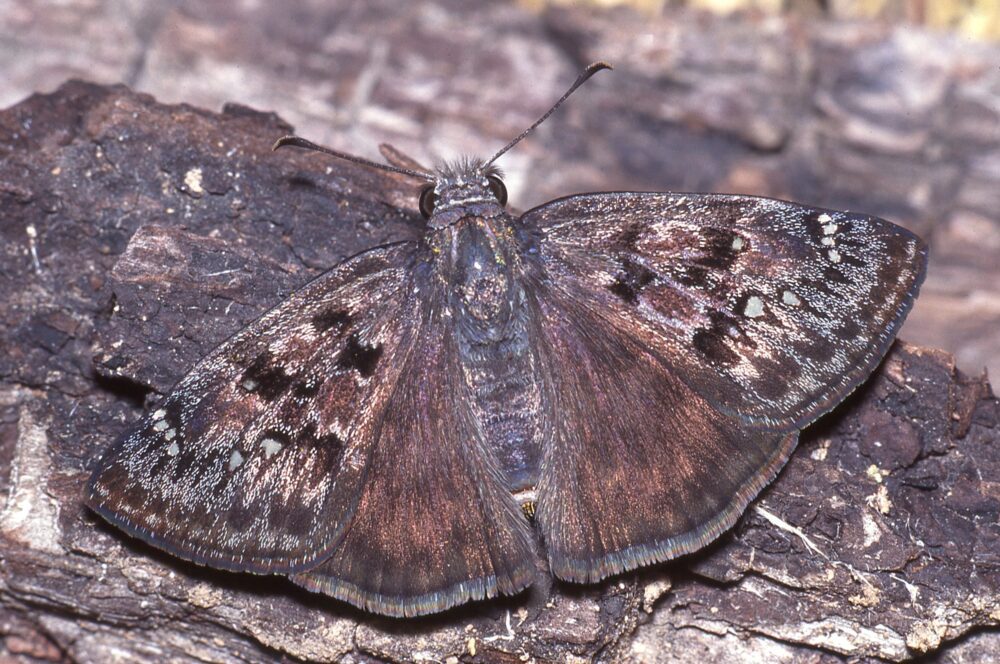
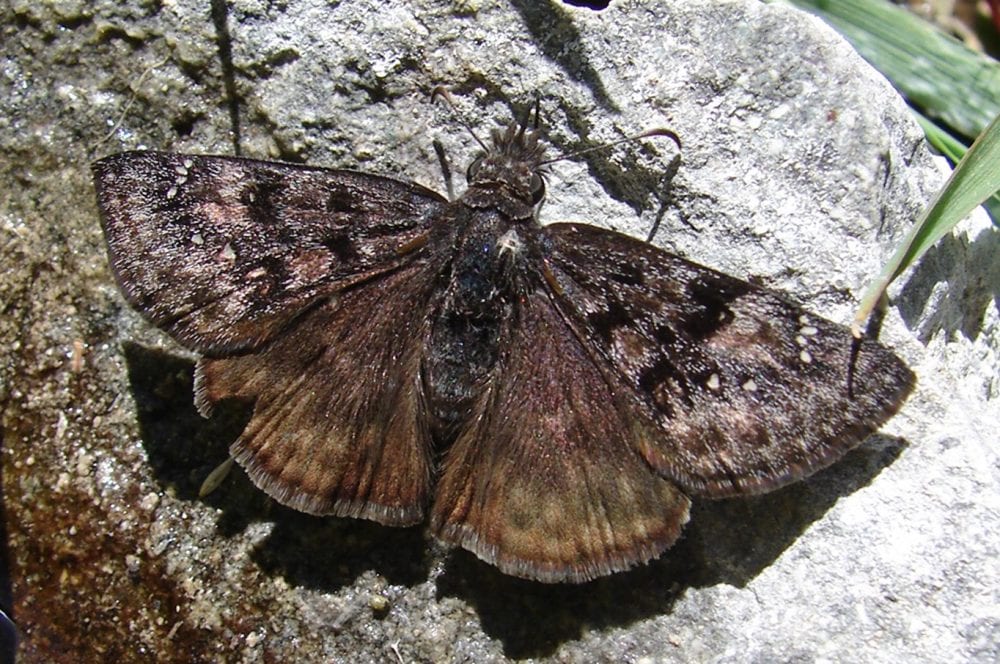
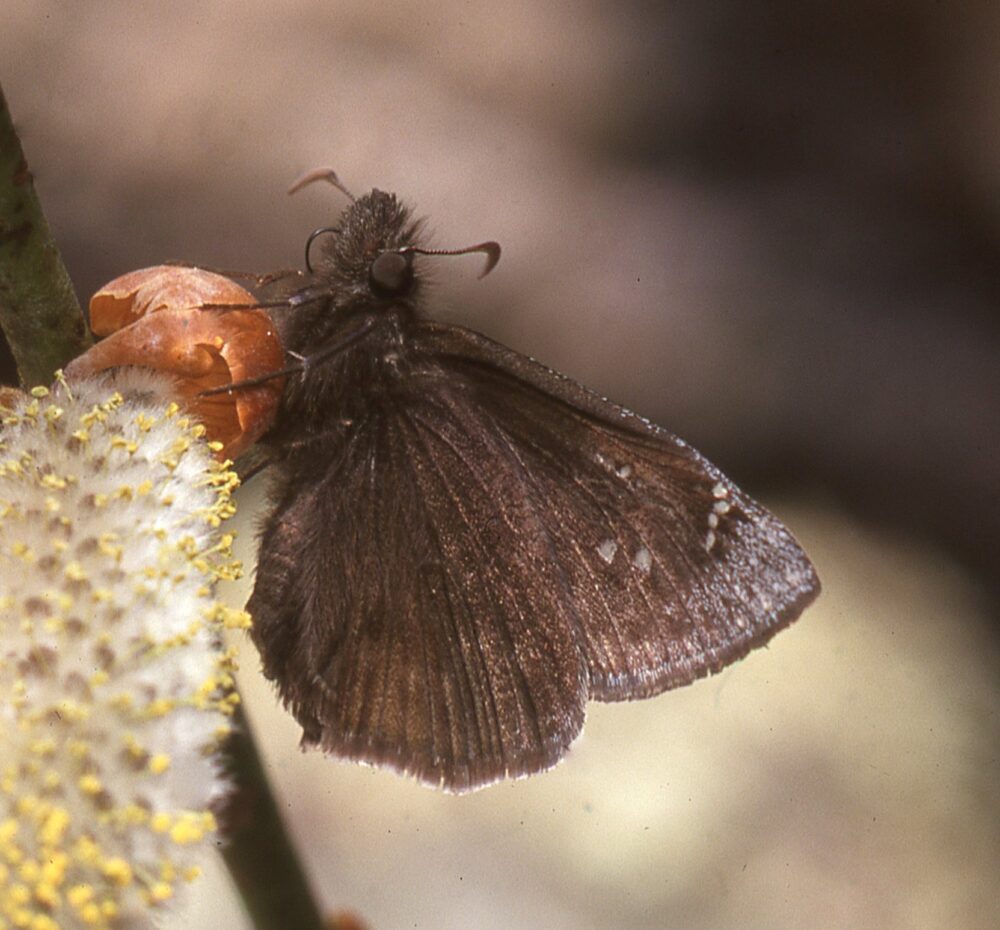

Gesta horatius (Scudder & Burgess 1870) Horace’s Duskywing (updated May 7, 2025)
Description. Horace’s Duskywing resembles Meridian Duskywing. Spring brood Horace’s have contrasting tan and gray patches on the forewing above. Summer brood Horace’s may be iridescent chocolate brown. Translucent hyaline dots on the dorsal forewing are larger on Horace’s than those on Meridian. Hindwing iridescent submarginal spots are prominent. Range and Habitat. This eastern US species has a disjunct population in the southern Rockies and Southwest. It occupies Upper Sonoran and Transition Zone oak woodlands in New Mexico usually from 5000 to 8000’ elevation (counties: Be,Co,Ed?,Gu,Ha,Li,LA,Mo,Ot,Qu,RA,Sv,SJ,SM,SF,Ta,To,Un). Life History. Larvae eat oaks (Fagaceae) such as Quercus gambelii and Quercus undulata in New Mexico. Larvae roll leaves into nests, then overwinter. Flight. Gesta horatius is bivoltine. Statewide, records fall between April 4 and October 4. Adults seek nectar; males may hilltop. Comments. The Sacramento Mountains have a strong spring flight from April to May with a weak July flight. The north-central mountains and eastern plains have a weak spring brood, but a strong July flight. Scant, unverified reports from Eddy and Socorro counties probably represent misidentified Meridian Duskywings.
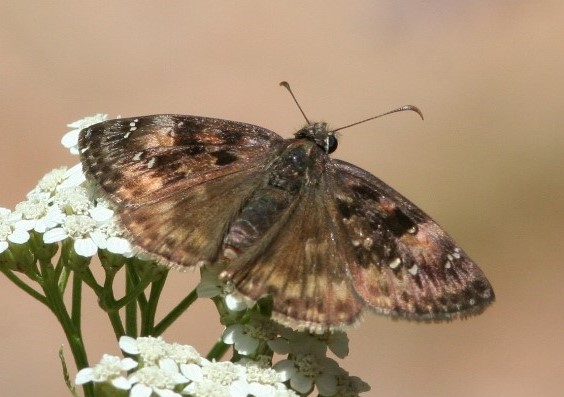
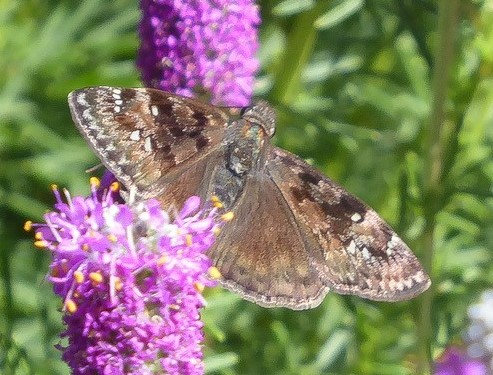
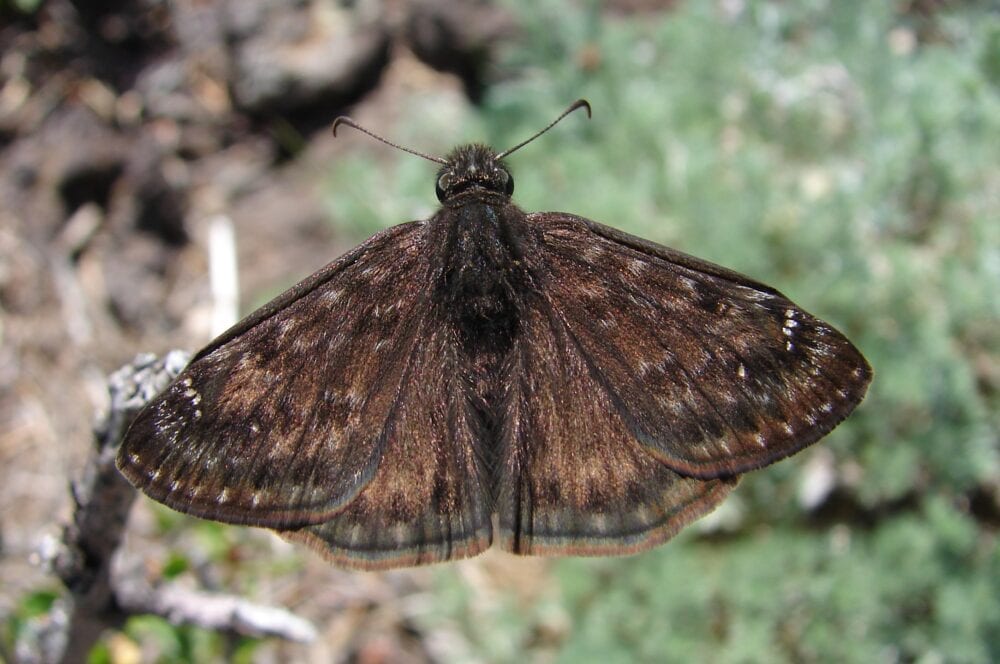
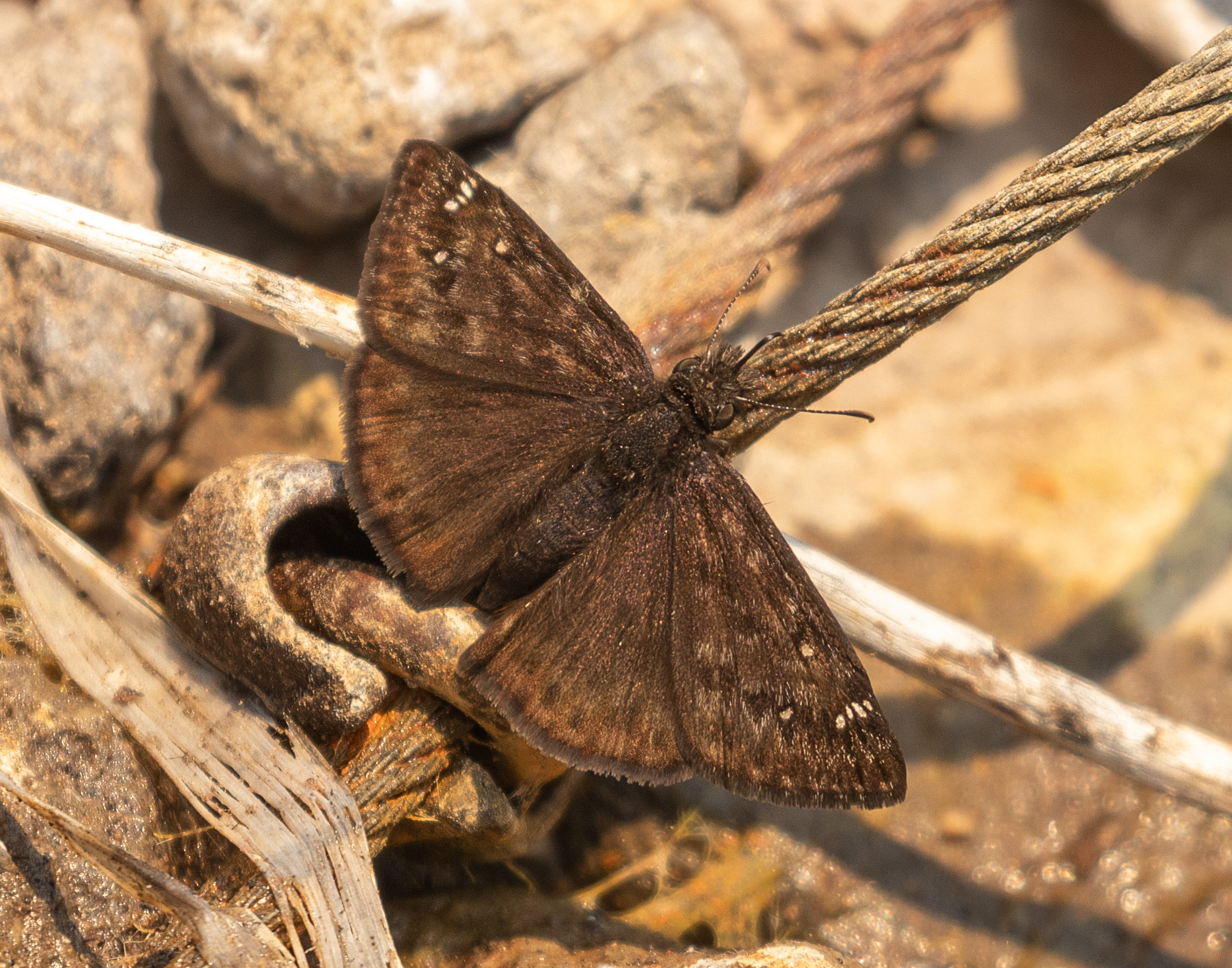
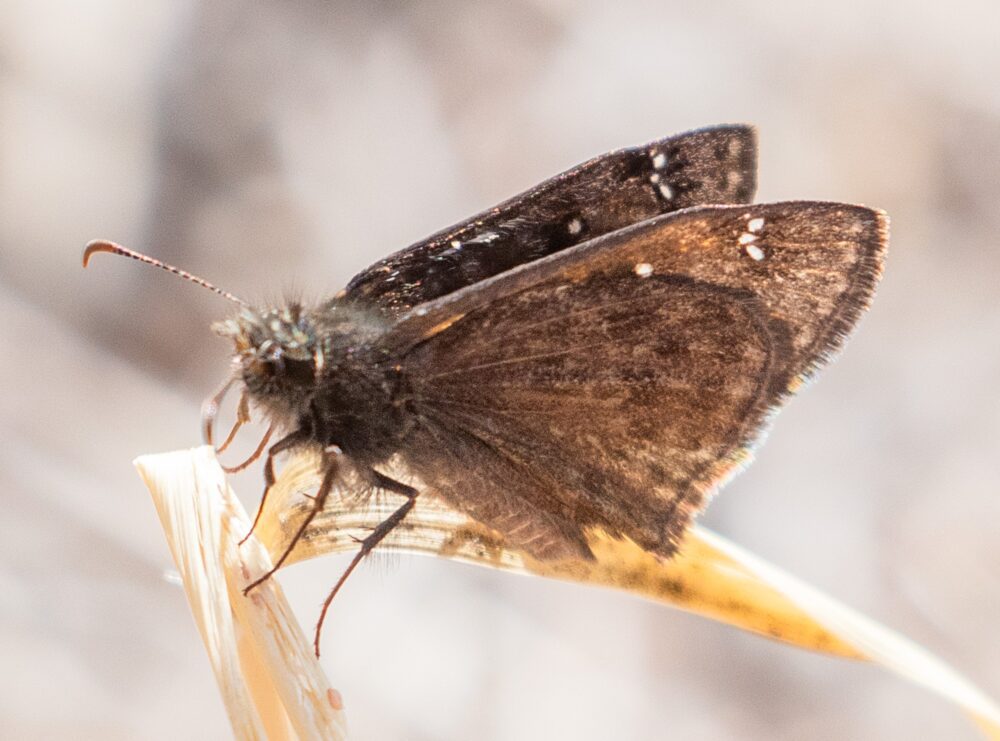
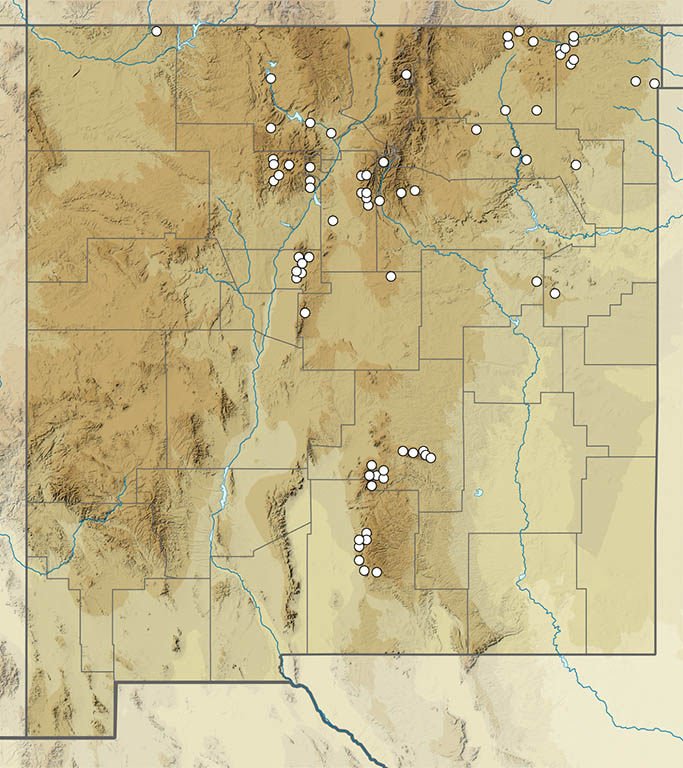
Gesta tristis (Boisduval 1852) Mournful Duskywing (updated October 24, 2022)
Description. Mournful Duskwings have a unique combination of a white hindwing fringe and parallel white patches along the ventral hindwing margin. Rarely absent, these patches are the best way to separate Mournfuls from other white-fringed duskywings. You just have to get a look at the underside. Range and Habitat. Nominate Gesta tristis is Californian. Our population is disjunct and distinct, occurring from Arizona, west Texas and southern New Mexico (counties: Ca,Ch,DA,Ed,Gr,Gu,Hi,Li,Lu,Ot,Ro,Si,So) south to Colombia. Mournful Duskywings live in Upper Sonoran Zone oak woodlands from 4500 to 6500′ elevation. Conveniently, Gesta tristis and Gesta pacuvius are nearly allopatric in New Mexico, which simplifies some field identifications. Life History. Oaks (Fagaceae) are the larval hosts. Specific oaks used in our region are unknown, but Quercus grisea is suspected and other species are likely. Flight. Mournful males establish hilltop territories by defending perches atop the tallest vegetation on summits, usually oaks or junipers. Females frequent nectar and water. Our records suggest two or more generations per year: February 24 to May 23 peaking in April, and again June 22 to November 4 peaking in August. Our northernmost sightings may represent the occasional summer wanderer. Comments. We have the white-fringed, southwestern version: Gesta tristis tatius (W. H. Edwards 1883). Kansas Professor Francis Huntington Snow caught the first New Mexico specimen in Water Canyon in the Magdalena Mountains (So) in August 1881. It was as yet undescribed by science and he reported it, erroneously, as Gesta funeralis, but he may have been distracted by his hair-raising escape from local Apaches who objected to his intrusion into their lands. William Henry Edwards subsequently described this white-fringed subspecies in 1883 from specimens obtained at Mount Graham in Arizona by another collector.
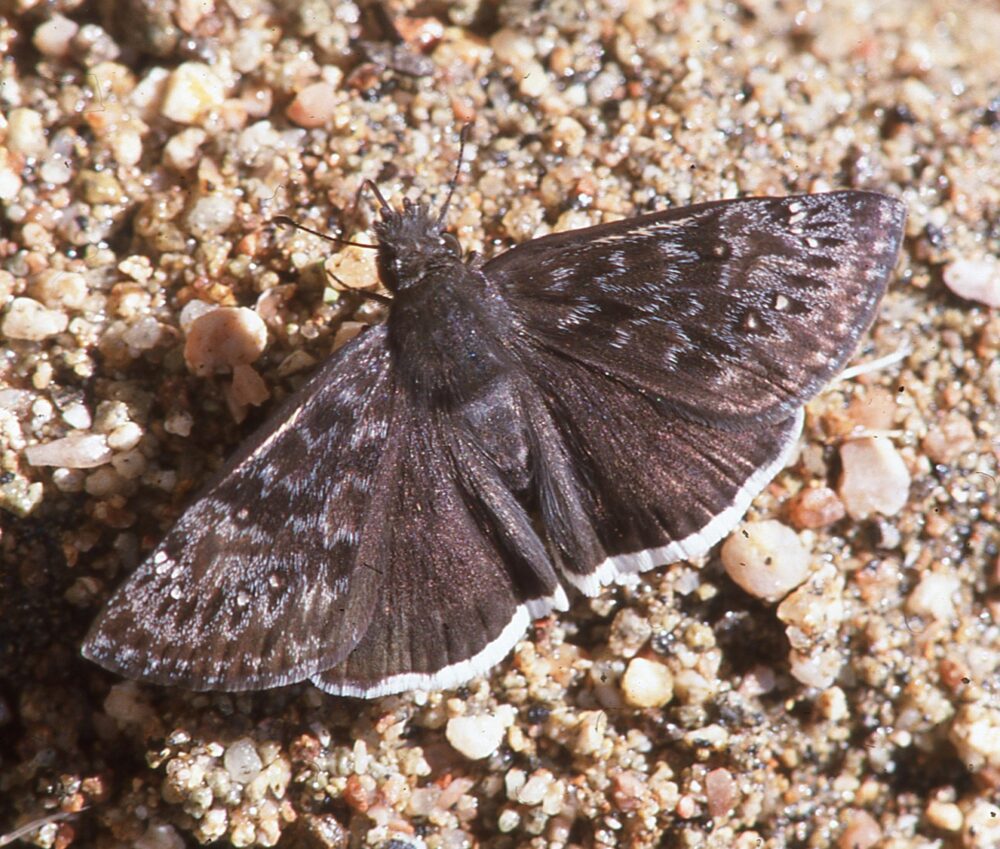
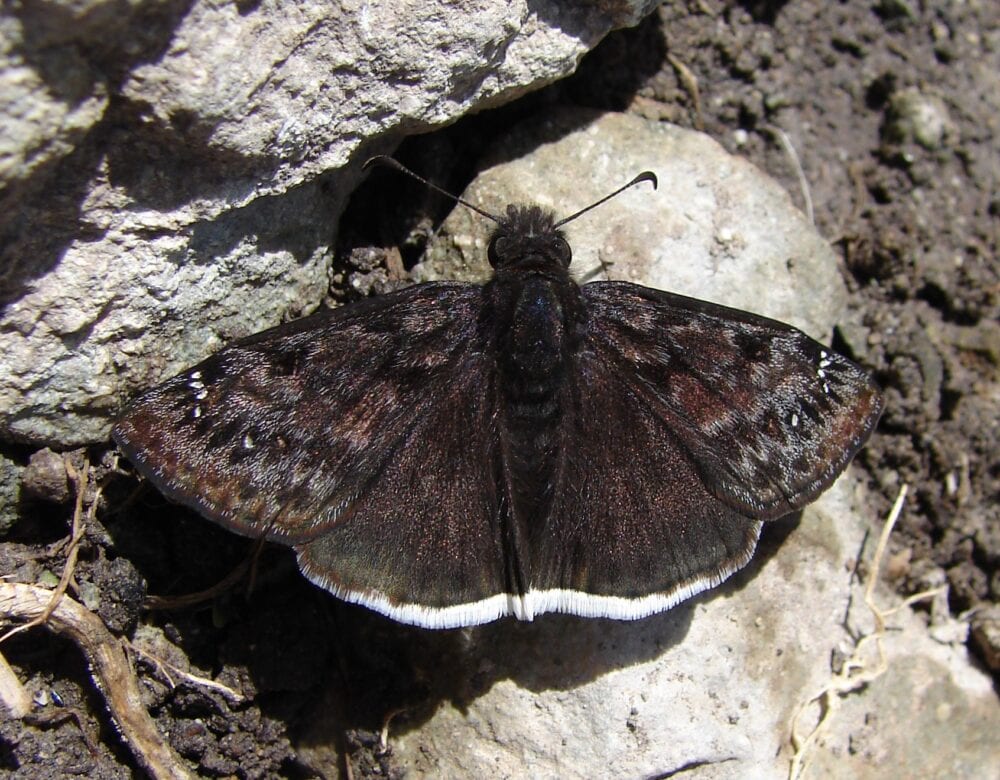
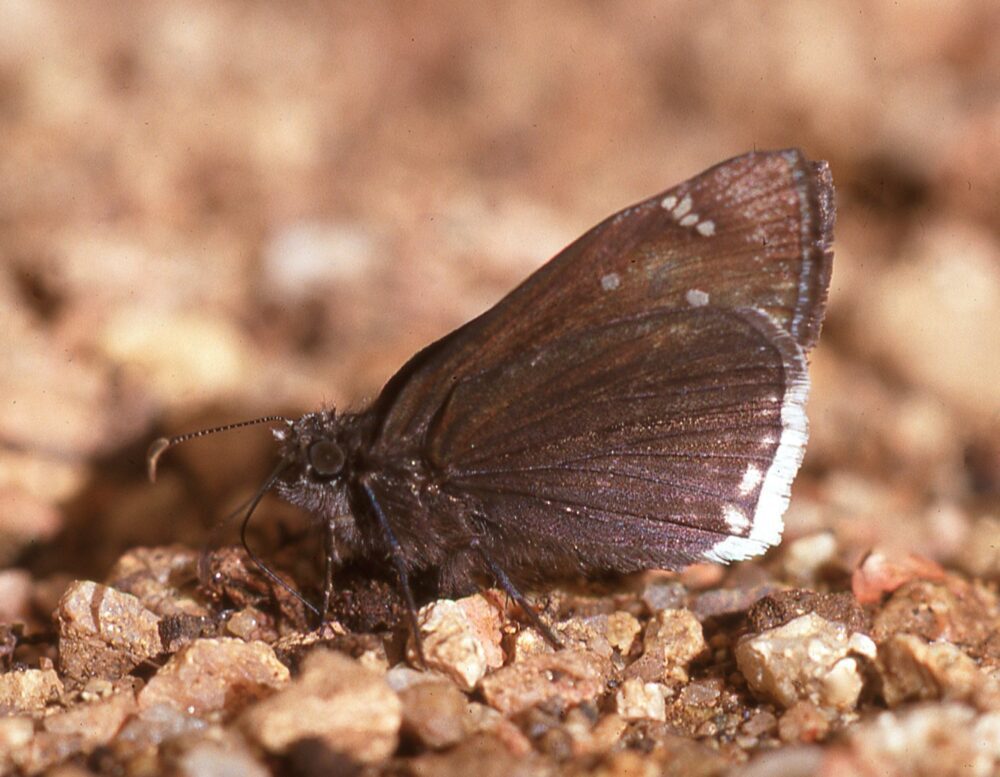
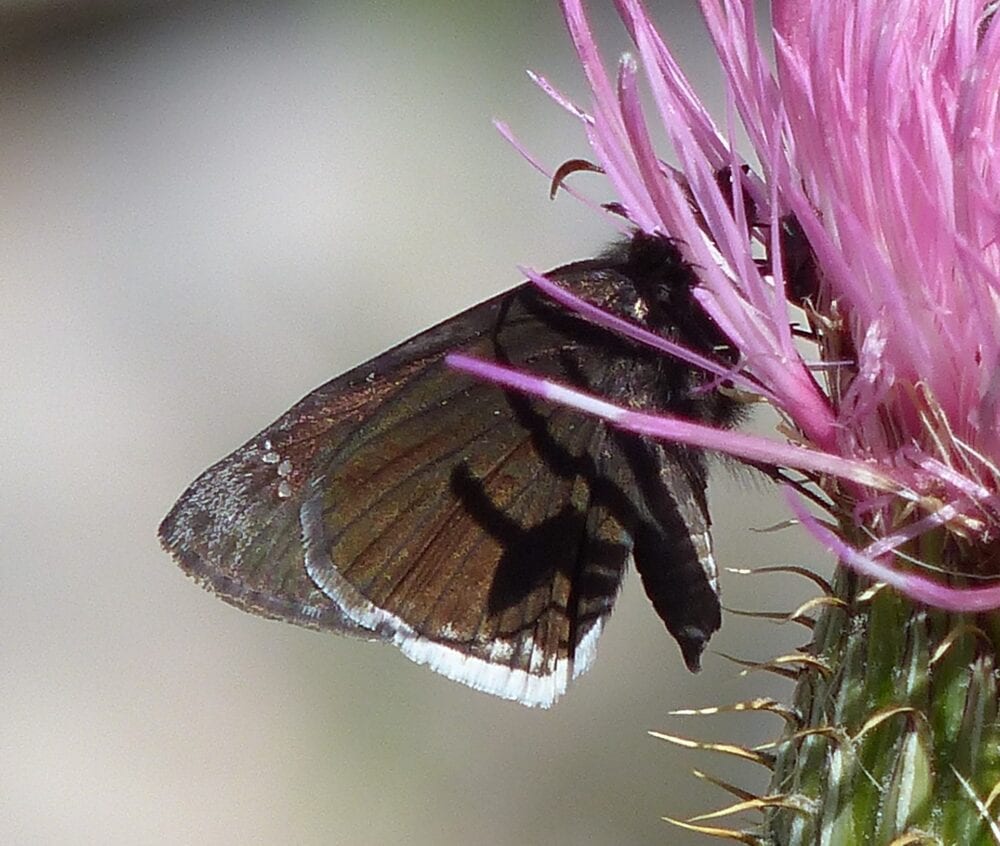
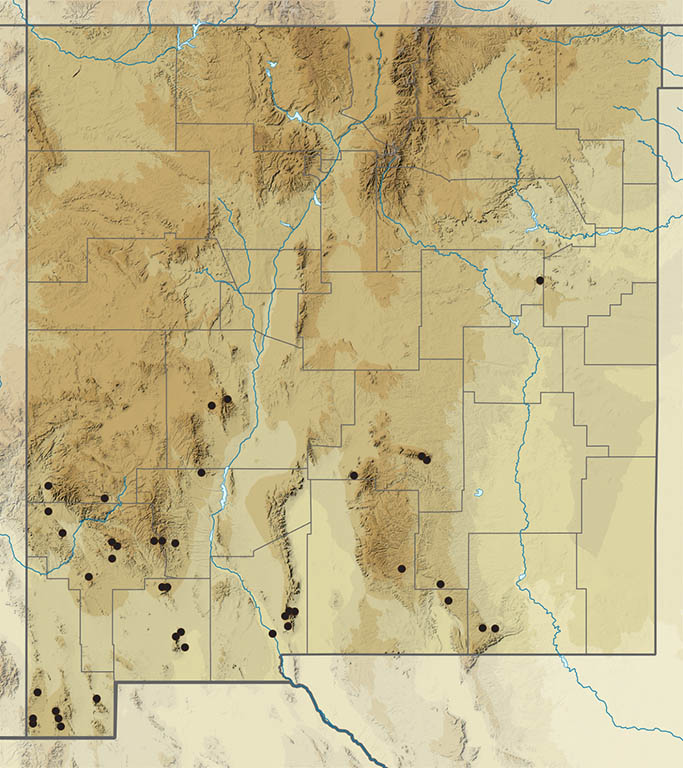
Gesta scudderi (Skinner 1914) Scudder’s Duskywing (updated October 23, 2022)
Description. Positive identification of individual Scudder’s Duskywing requires genitalic dissection and examination. This species is smaller than Gesta juvenalis clitus and not as contrasty as Gesta pacuvius, but its resemblance to each is such that naked-eye determinations are suspect unless many individuals can be compared. Range and Habitat. This Mexican species barely edges into the US along the Sierra Madre in southeast Arizona and southwest New Mexico (county: Hi), where it occupies Upper Sonoran to Transition Zone scrubby woodlands. Life History. Little is known of its bionomics, but the likely larval hosts for Gesta scudderi are oaks (Fagaceae). Flight. Bailowitz and Brock (2022) indicate multiple generations in southeast Arizona (records there range from mid-March to early September). Our one record is from 4 March 1986, when it was captured at Geronimo Pass in the Peloncillo Mountains by Ray E. Stanford. Its identity was confirmed by J. A. Scott and H. A. Freeman. Comments. Because of difficulty in identification, Gesta scudderi may be more common in southwest New Mexico than our one confirmed record suggests.
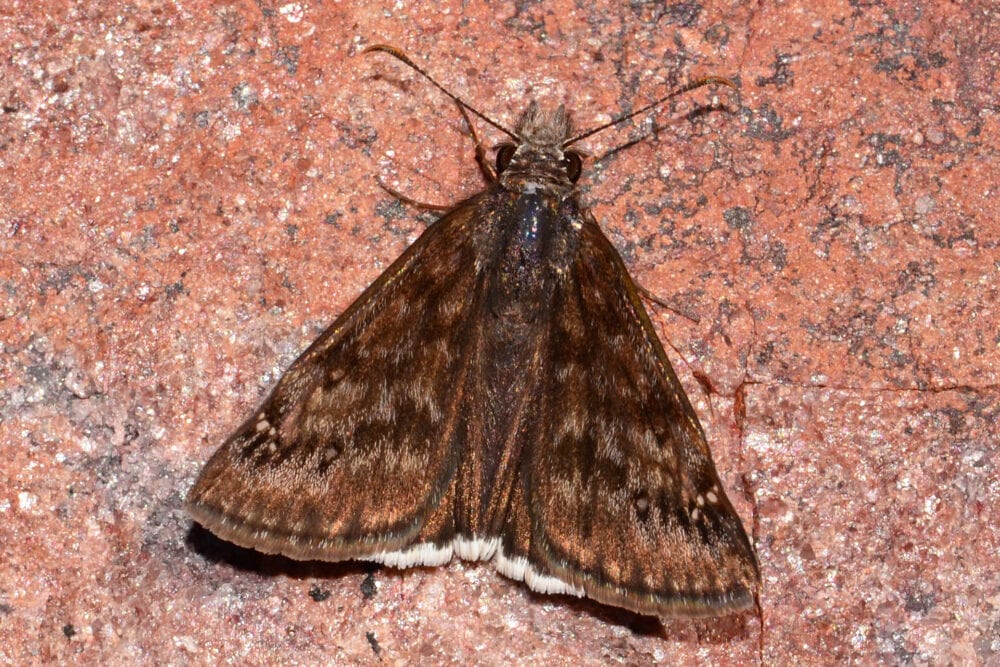
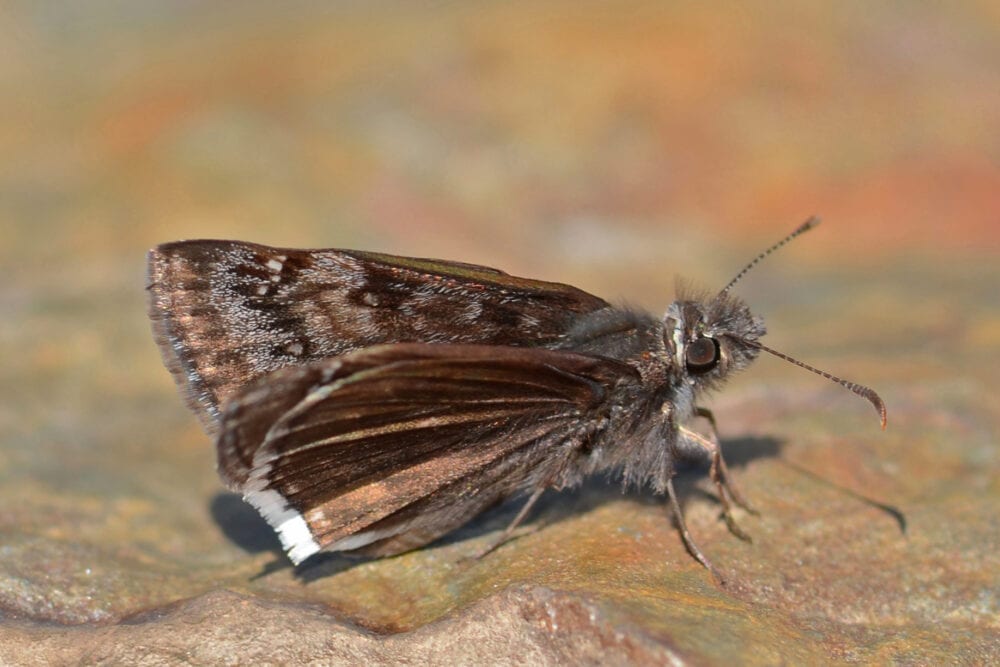
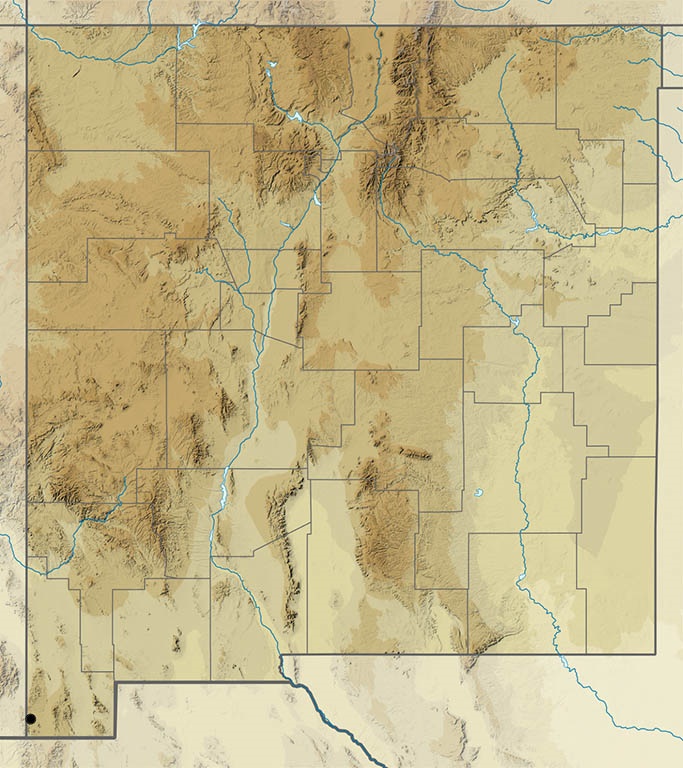
Gesta funeralis (Scudder & Burgess 1870) Funereal Duskywing (updated March 3, 2022)
Description. Funereal Duskywing’s long, narrow forewing is unique among the Duskywings in our area. A distinctive dorsal forewing tan patch occurs just inside of the subapical white spots. The hindwing is fringed with white. Range and Habitat. Gesta funeralis breeds in Upper Sonoran Zones of Central and South America, Mexico and the southwest US, including much of New Mexico. Its widespread occurrence here (all counties) is the result of strays wandering north and breeding seasonally. Life History. Many legumes (Fabaceae) are larval hosts. The author observed oviposition on New Mexico locust (Robinia neomexicana) in the Sacramento Mountains (Ot). Polyphagous and multivoltine, our most widespread white-fringed duskywing has been found from 3,900 to 11,200′. Flight. Influx of adults and seasonal breeding help Funereal Duskywings maintain steady levels in most southern New Mexico summers. Records span February 19 to December 25. Adults wander along drainages, feeding at nectar or mud. Comments. Some experts consider Funereal to be a subspecies of Gesta zarucco (Lucas), a species of coastal southeastern North America. Funereal Duskywing was considered a resident of southern New Mexico and only a rare stray to northern areas as recently as 2000. Since then, it has become routine in northern New Mexico, too.
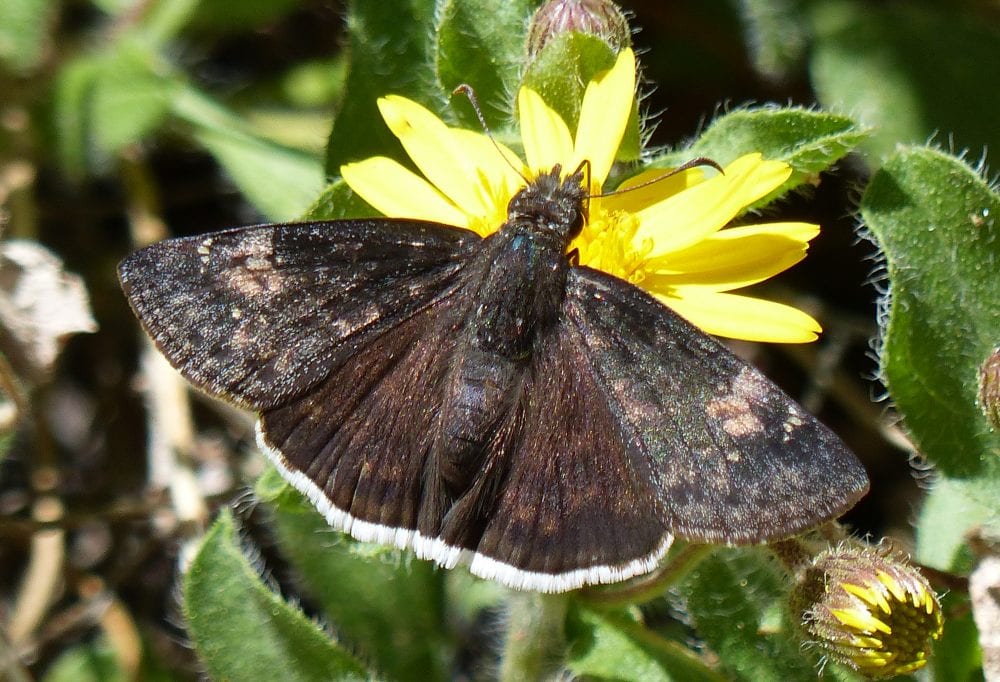
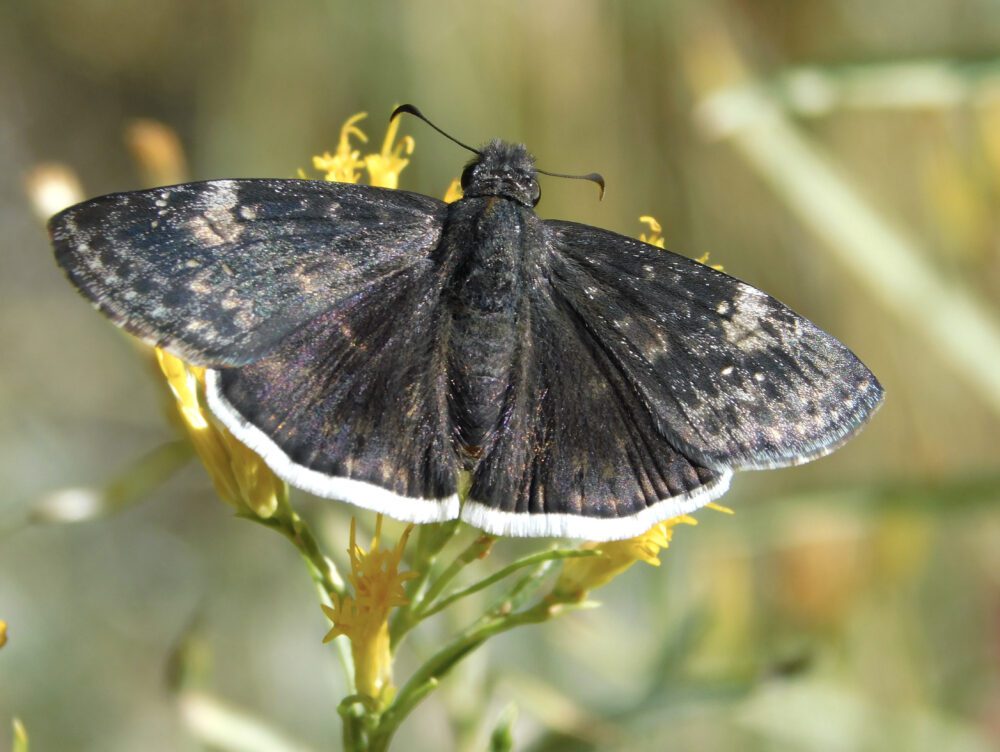
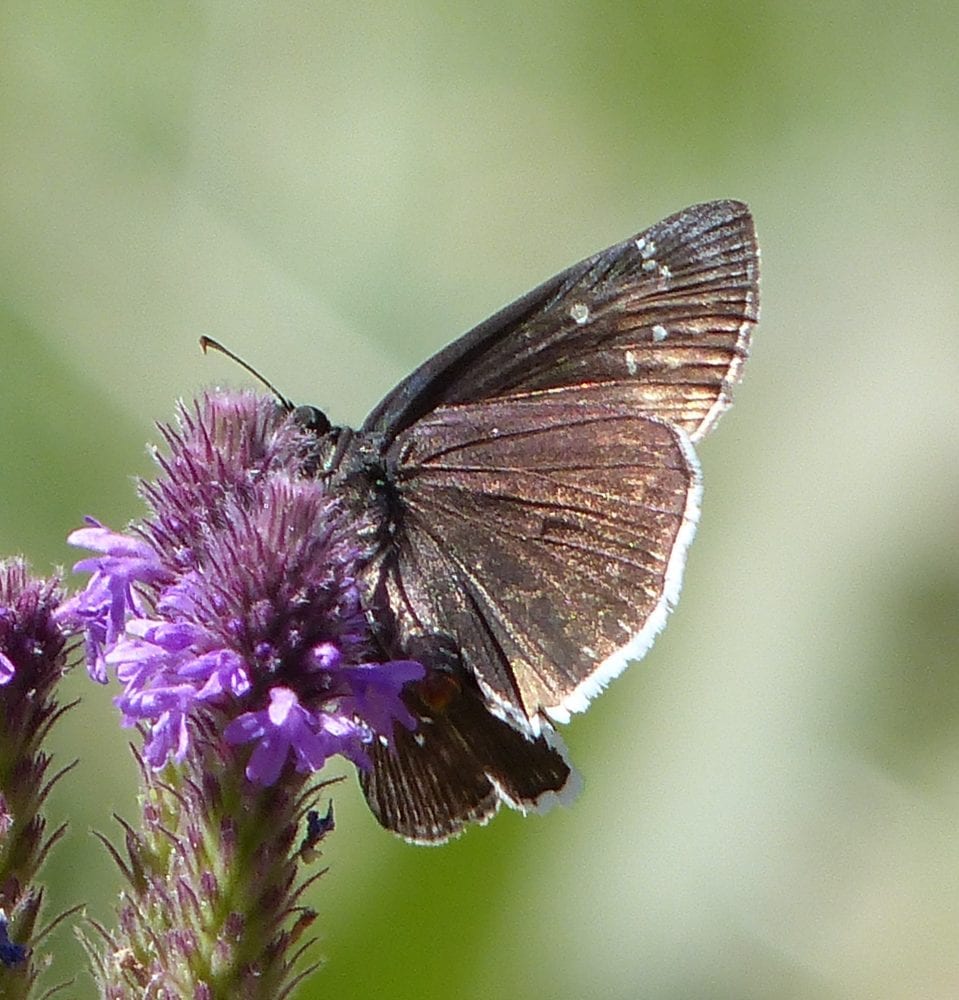
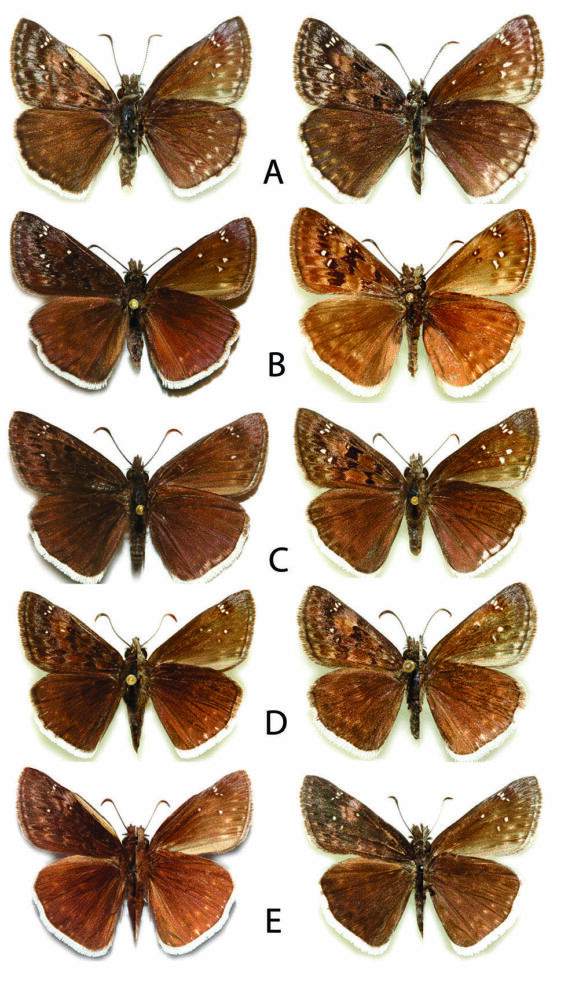
Gesta afranius (Lintner 1878) Afranius Duskywing (updated March 5, 2024)
Description. Afranius and Persius (the next species) are similarly small, compared to other Gesta spp. and difficult to differentiate from each other. They both have dorsal forewing subapical white spots. Gesta afranius males lack the numerous whitish hairs blanketing the dorsal forewing of Gesta persius males. Genitalic examination is the best way to be 100 percent certain of an identification. Range and Habitat. Afranius Duskywing lives throughout the Rockies and high plains from southern Canada south to the Mexican Sierra Madre. In New Mexico it prefers canyons and ravines in Transition Zone savannas, generally 6000 to 9000’ elevation (counties: all except DB,DA,Ed,Le,Lu,Ro,Va). Life History. Larvae eat a variety of legumes (Fabaceae). The widespread Lupinus argenteus is a popular host in northern New Mexico. Hosts in nearby states include Lupinus caudatus and Thermopsis divaricarpa (Scott 1992), as well as Lotus wrightii (Brock 1994). Flight. The two annual broods produce peak adult numbers in April and July. Flight dates span March 23 to September 4. Males patrol low areas; both sexes seek nectar. Comments. In the field, Afranius can sometimes be separated from Persius based on habitat. If you look around and see lupines, you should suspect Afranius. If you see Golden Banner (Thermopsis divaricarpa), it is probably Persius. This generalization fails in some places (see Scott 1992). Uncertainty regarding reports from Cibola, Hidalgo and Otero counties reflect unresolved confusion with Gesta persius, for example they may be photographs or undissected female specimens.
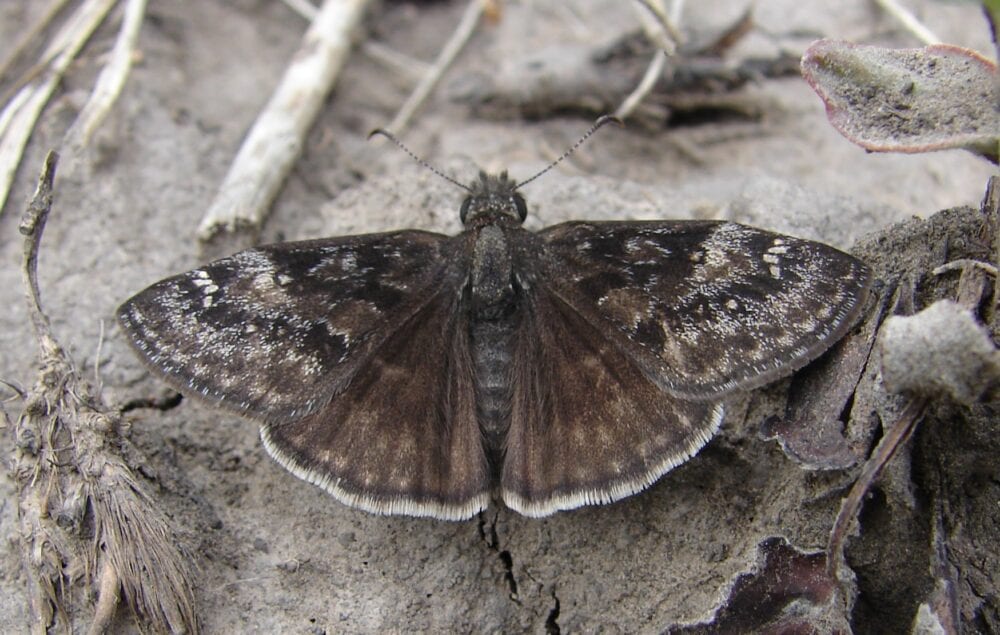
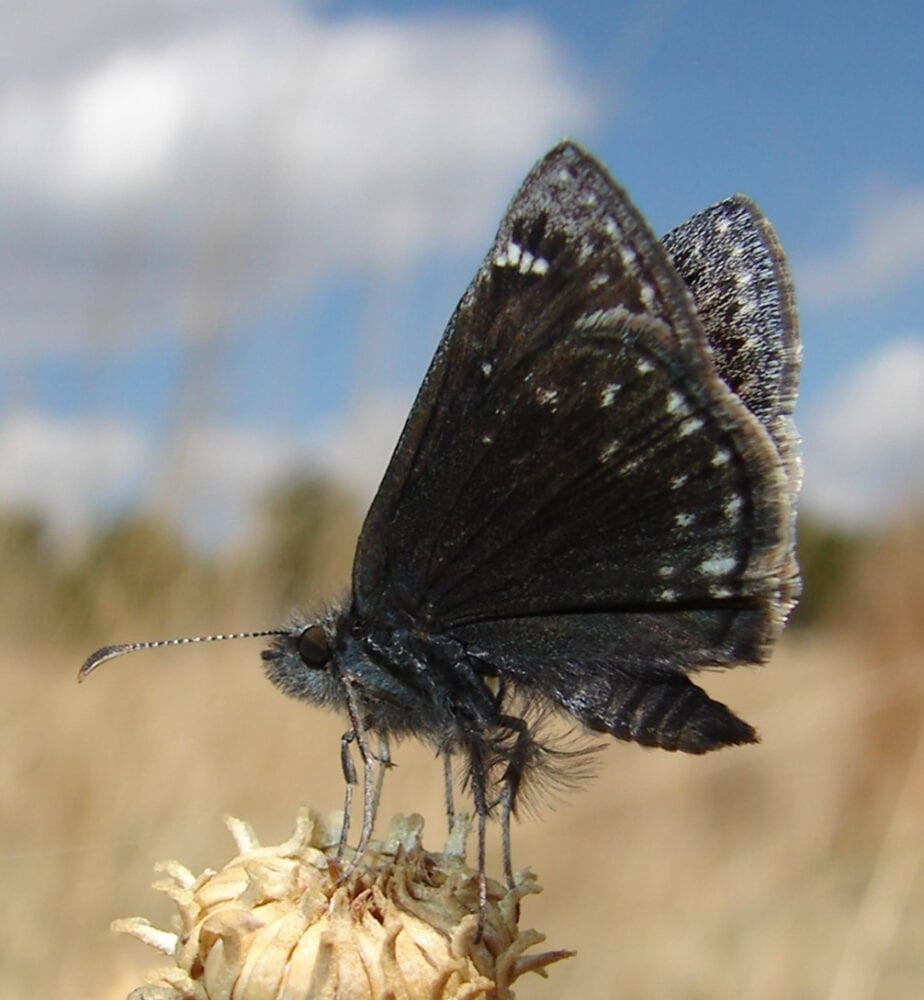


Gesta persius (Scudder 1863) Persius Duskywing (updated March 5, 2024)
Description. Smallish, Persius Duskywing is much like Afranius Duskywing, but fresh males have a dense blanket of whitish hairs on the dorsal forewing. Hindwing pale spots usually are more distinct than on Afranius. Use of these characters is possible if one can determine sex and if individuals are in good condition. Males (small abdomen) tend toward gray above, while females (larger abdomen) tend toward brown. Females and worn males may require genitalic determination. Range and Habitat. Gesta persius occurs in the northeast US and in the western US cordillera from Alaska south to montane Arizona and New Mexico (counties: Be,Ca,Ci,Co,Gr,LA,Li,MK,Mo,Ot,RA,Sv,SJ,SM,SF,Si,Ta,To,Un). Its habitat is somewhat more alpine than that of G. afranius. Burns (1964) stated that G. persius occurs “as far south as the Sacramento and Black Mountains” in New Mexico. Life History. Persius uses several hosts for its larvae. In the West it prefers legumes (Fabaceae) such as Astragalus flexuosus, Thermopsis divaricarpa and sometimes Lupinus argenteus. Oviposition has been observed on Thermopsis species (RA) (Scott 1992) and on Astragalus species (Ta). Mature larvae hibernate. Flight. Persius Duskywing males patrol hilltops, which contrasts with gully-patrolling Afranius males. There is one generation per year, perhaps with a partial second brood in southern New Mexico. Persius flies mostly from May to July. Reports from March and September are likely to be misidentified Afranius. Comments. Reports from Mora and Sierra counties remain uncertain due to identification difficulties. The McCauley Expedition collected Persius along the Rio Chama southwest of Ojo Caliente (RA), on 7 July 1877.
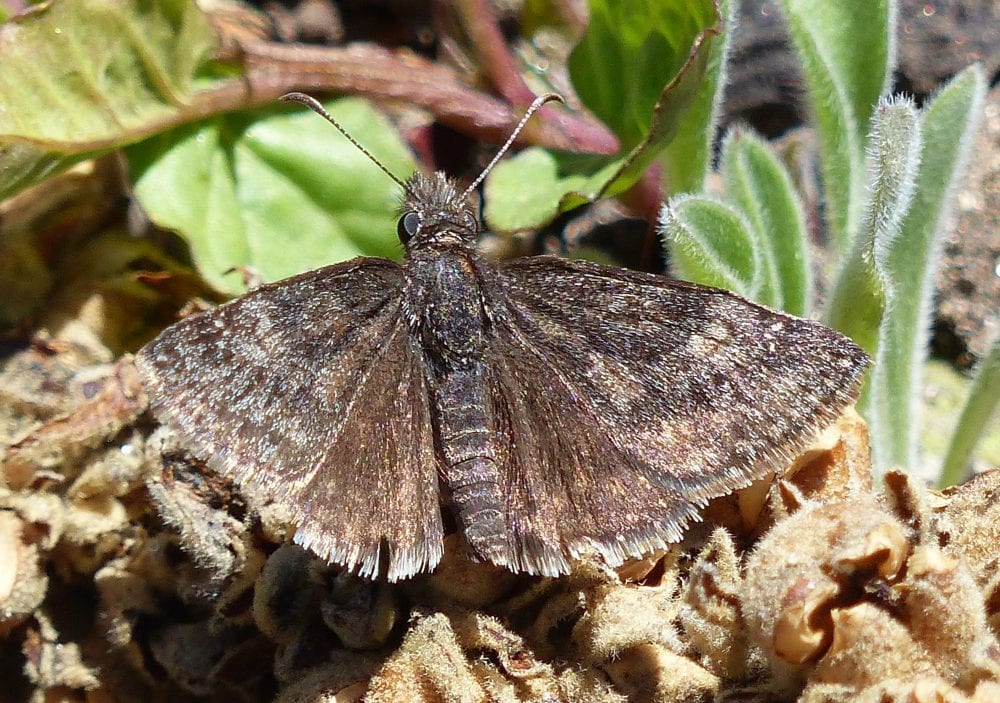
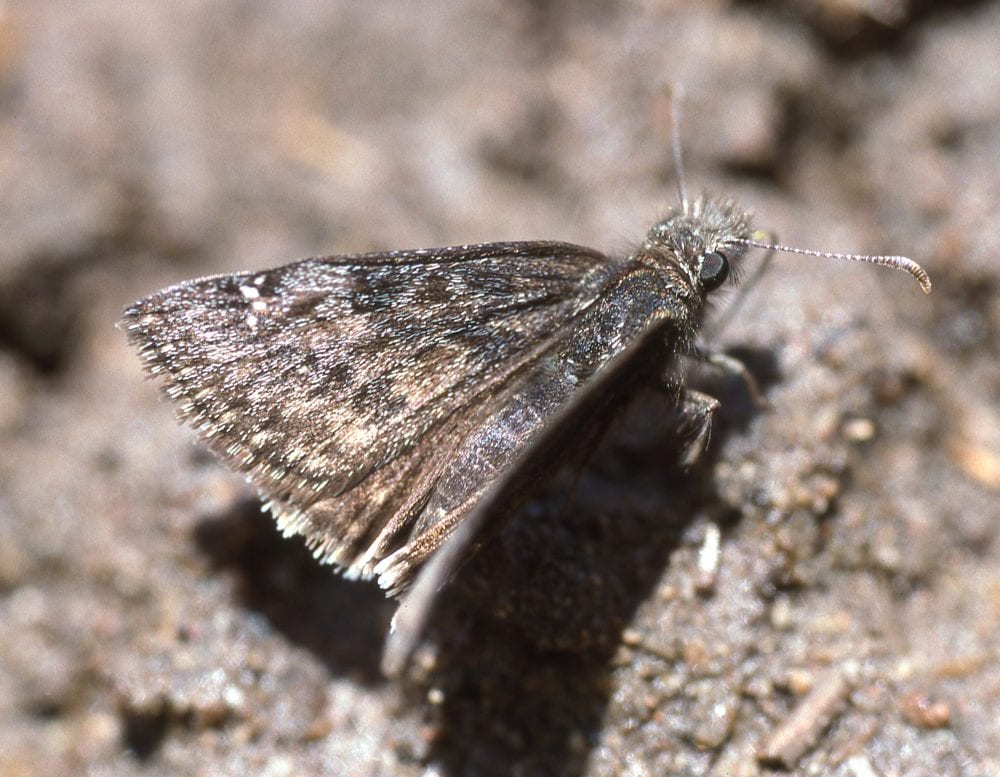
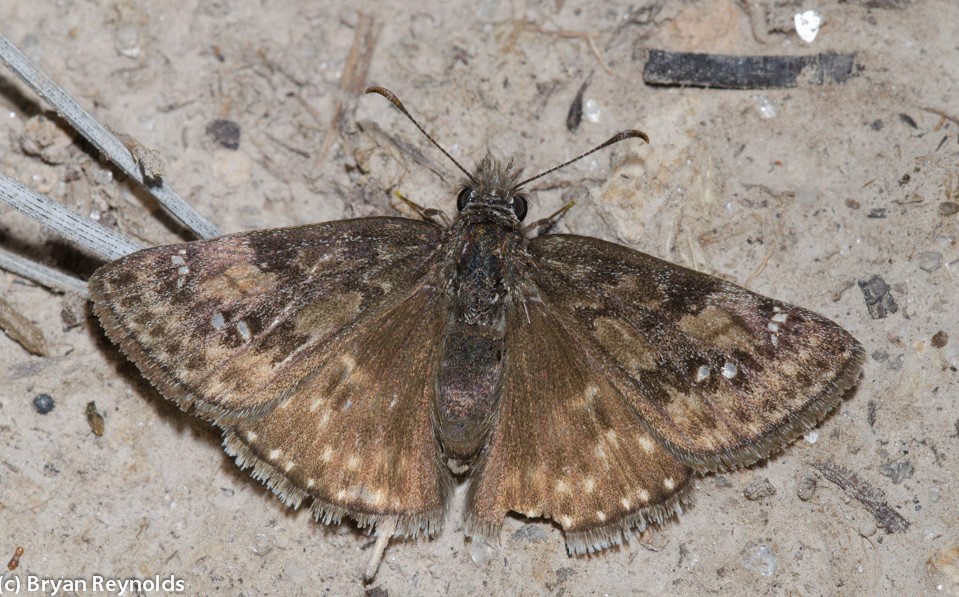


Grais stigmaticus (Mabille 1883) Hermit Skipper (added September 5, 2022)
Description. This is a fairly large skipper, with about a 2-inch wingspan. The upper surface is brown with faint darker brown spots arranged in postmedian rows on both wings. There are faint brown spots at the distal ends of the cells on both fore and hind wings. Ventrally, the color is a lighter yellowish brown with the spot rows repeated. Occasionally, there are a few small white spots on the apex of the FW. It is similar to the Brown-banded skipper (Timochares ruptifasciata), but that smaller species has bolder darker markings. Range and Habitat. This is a tropical species which rarely enters our area. Its normal range is Argentina to Mexico. Occasional individuals have strayed as far north as Kansas; there is a single record for SE AZ and one from extreme SW NM. Our record is from Guadalupe Canyon, Peloncillo Mtns. (Hi). Life History. According to Bailowitz & Brock (2022), larvae eat leaves of Esenbeckia, a citrus family tree which apparently doesn’t occur in NM. Flight. Our sole record is from August. The lone AZ record is from September. In Mexico, it is known to fly from March to December. Comments. The underside of the head is bright yellow.
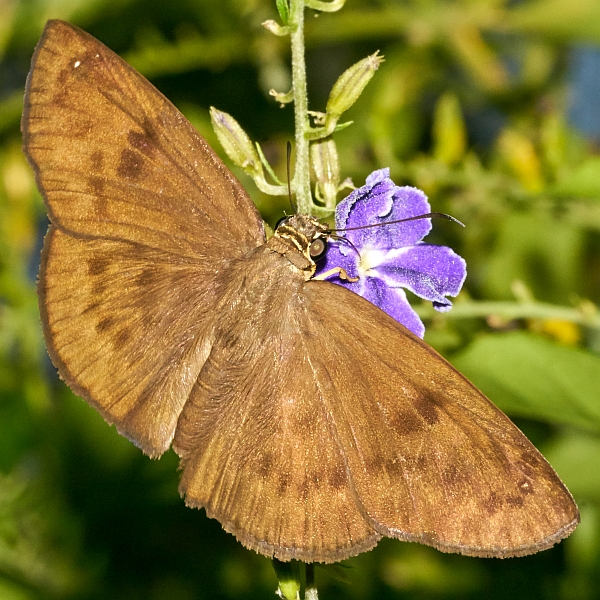


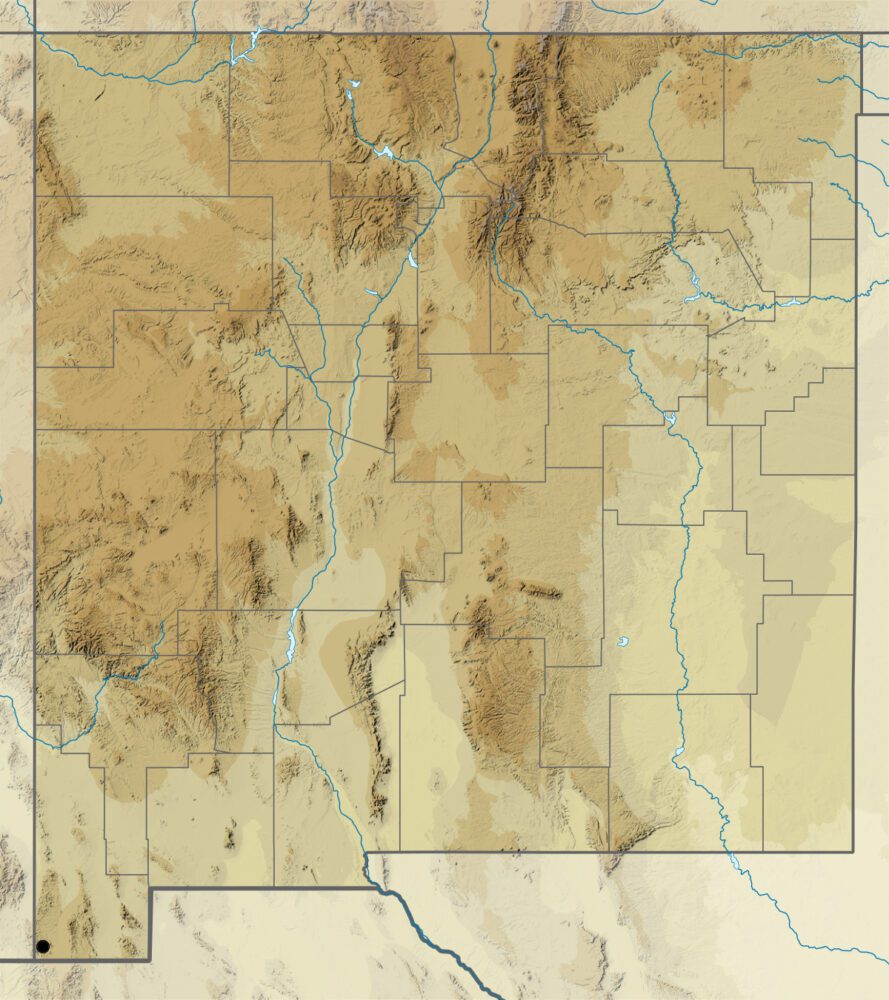
Windia windi H. Freeman 1969 Wind’s Skipper (added August 22, 2022)
Description. This rare skipper presents a “patchy” appearance, with translucent spots on the FW and lighter brown patches of color on the darker brown ground color on both wings. The FW is pointed at the apex. Wind’s Skipper has about a 1.5-inch wingspan. Range and Habitat. The only US record for this species is a specimen captured by Kilian Roever at the AZ end of Cottonwood Canyon, Peloncillo Mtns. Given the close proximity of this occurrence, Wind’s Skipper may eventually be found on the NM side of Cottonwood Canyon, or elsewhere in the Peloncillos. Life History. Nothing is known of the life history of this insect. Flight. The one specimen noted above was captured on 23-viii-1983. Elsewhere, this univoltine butterfly appears in August and September. Comments. The BAMONA web site notes that males perch at the bottom of gullies in steep canyons to find females (https://www.butterfliesandmoths.org/species/Windia-windi).

